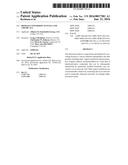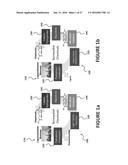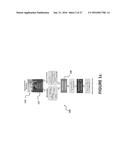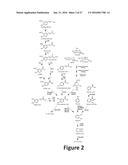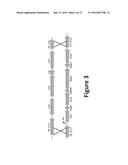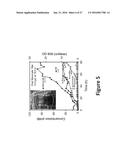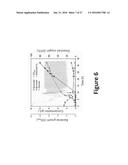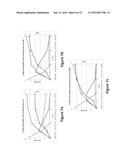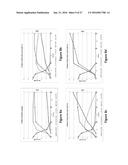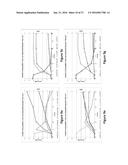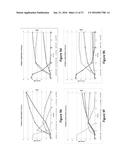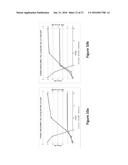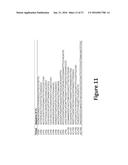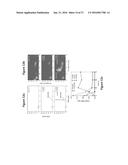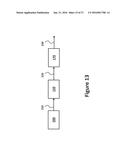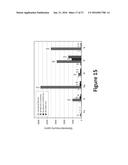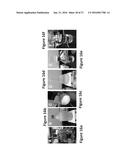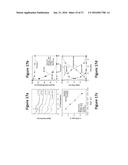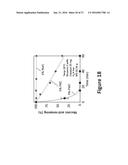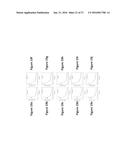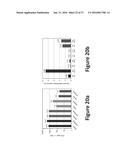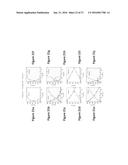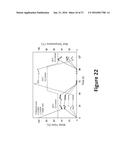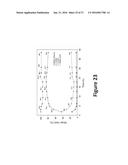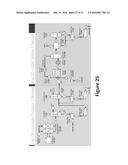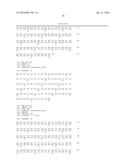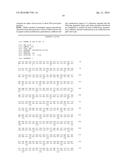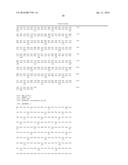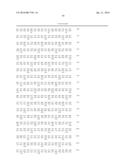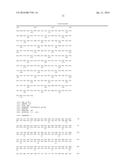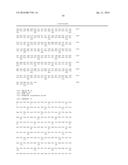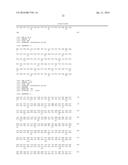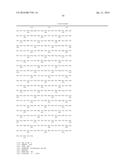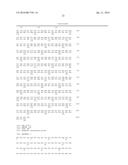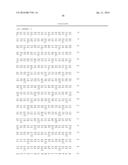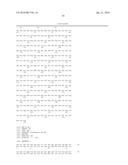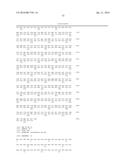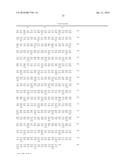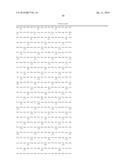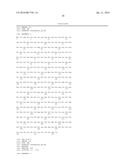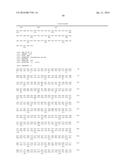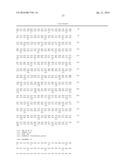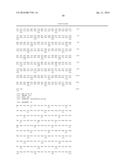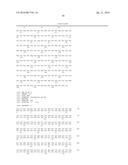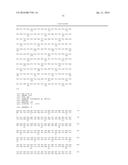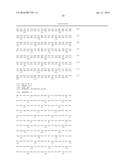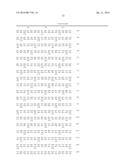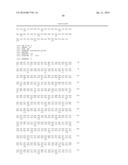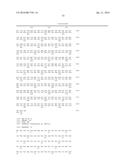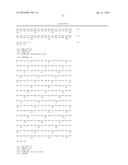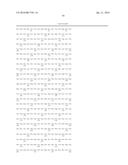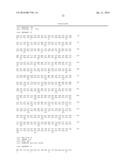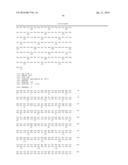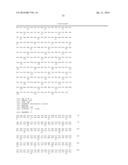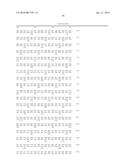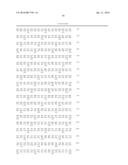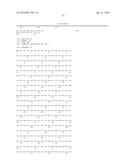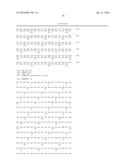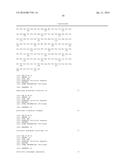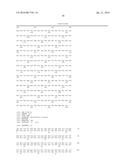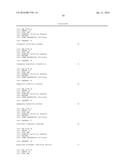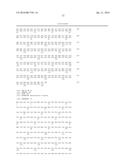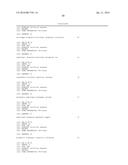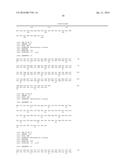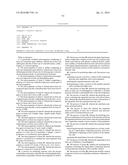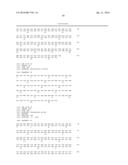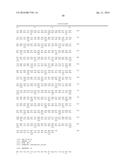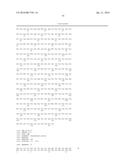Patent application title: BIOMASS CONVERSION TO FUELS AND CHEMICALS
Inventors:
IPC8 Class: AC12P744FI
USPC Class:
562592
Class name: Acyclic polycarboxylic preparation by hydrogenation
Publication date: 2016-01-21
Patent application number: 20160017381
Abstract:
This disclosure relates to compositions and methods for converting
biomass to various chemical intermediates and final products including
fuels. Aspects include the depolymerization of lignin, cellulose, and
hemicellulose to a wide slate of depolymerization compounds that can be
subsequently metabolized by genetically modified bacterium, and converted
to cis,cis-muconic acid. Other aspects include the use of monometallic
catalysts for converting the cis,cis-muconic acid to commodity chemicals
and fuels, for example adipic acid and/or nylon.Claims:
1. A genetically modified microorganism comprising at least one exogenous
gene addition, wherein the at least one added gene encodes at least one
of a decarboxylase, a dehydratase, or a monooxygenase.
2. The microorganism of claim 1, further comprising at least one endogenous gene deletion, wherein the at least one deleted gene encodes at least one of a dioxygenase, a muconate lactonizing enzyme, or muconolactone isomerase.
3. The microorganism of claim 1, wherein the microorganism over-expresses at least one demethylase gene.
4. The microorganism of claim 1, further comprising a deletion of at least one catabolite repression control gene of the microorganism.
5. The microorganism of claim 1, wherein the at least one exogenous gene encodes a decarboxylase from Enterobacter cloacae.
6. The microorganism of claim 5, wherein the exogenous gene is at least one of aroY, ecdB, or ecdD.
7. The microorganism of claim 1, wherein the at least one exogenous gene encodes a dehydratase from Bacillus cereus.
8. The microorganism of claim 7, wherein the exogenous gene is at least one of aroZ or asbF.
9. The microorganism of claim 1, wherein the at least one exogenous gene encodes a monooxygenase from Pseudomonas sp. CF600.
10. The microorganism of claim 9, wherein the exogenous gene is at least one of dmpK, dmpL, dmpM, dmpN, dmpO, dmpP, or pheA.
11. The microorganism of claim 2, wherein the at least one deleted gene is at least one of pcaH or pcaG.
12. The microorganism of claim 2, wherein the at least one deleted gene is at least one of catB or catC.
13. The microorganism of claim 3, wherein the demethylase gene is at least one of vanA, vanB, or ligM.
14. The microorganism of claim 1, wherein the microorganism is at least one of a bacterium, a fungus, a yeast, a prokaryote, or a prokaryotic microorganism.
15. The microorganism of claim 14, wherein the microorganism is a prokaryote or prokaryotic microorganism from the genus Pseudomonas.
16. The microorganism of claim 15, wherein the microorganism is a strain of P. putida, P. fluorescens, or P. stutzeri.
17. The microorganism of claim 16, wherein the microorganism is a strain of P. putida KT2440.
18. A process for producing muconic acid, the process comprising contacting a culture broth containing lignin depolymerization compounds with the microorganism of claim 1.
19. The process of claim 18, wherein the lignin depolymerization compounds comprise at least one of p-coumaric acid, ferulic acid, benzoic acid, phenol, coniferyl alcohol, caffeic acid, vanillin, or 4-hydroxybenzoic acid, and at least a portion of the lignin depolymerization compounds are converted to catechol, and at least a portion of the catechol is converted to muconic acid.
20. A process for producing adipic acid, the process comprising: separating muconic acid from a culture broth comprising muconic acid, impurities, and a microorganism; purifying the separated muconic acid; and hydrogenating at least a portion of the purified muconic acid to produce the adipic acid.
21. The process of claim 20, wherein the separating comprises at least one of centrifugation or filtration to produce muconic acid that is substantially free of the microorganism.
22. The process of claim 21, wherein the purifying comprises contacting the separated muconic acid with an adsorbent, wherein the adsorbent removes at least a first portion of the impurities from the separated muconic acid.
23. The process of claim 22, wherein the adsorbent comprises activated carbon.
24. The process of claim 23, wherein the impurities removed comprise at least one of benzoic acid, protocatechuic acid or 4-hydroxybenzoic acid.
25. The process of claim 20, wherein the purifying comprises crystallizing at least a portion of the muconic acid from the separated muconic acid to form a muconic acid precipitate and a liquid that contains at least a portion of the impurities.
26. The process of claim 25, wherein the purifying further comprises: dissolving the muconic acid precipitate in a solvent, resulting in a liquid phase comprising muconic acid and a solid phase comprising at least a portion of the impurities; and separating the liquid phase from the solid phase.
27. The process of claim 26, wherein the separating is by at least one of filtration or centrifugation.
28. The process of claim 26, wherein the hydrogenation comprises contacting the liquid phase comprising muconic acid and diatomic hydrogen with a metallic catalyst.
29. The process of claim 28, wherein the metallic catalyst comprises at least one of palladium, platinum, ruthenium, or rhodium.
30. The process of claim 29, wherein the at least one of palladium, platinum, ruthenium, or rhodium is supported by activated carbon or silica.
31. The process of claim 30, wherein the metallic catalyst comprises rhodium supported by activated carbon.
Description:
CROSS-REFERENCE TO RELATED APPLICATIONS
[0001] This application claims priority to and the benefit of U.S. Provisional Application No. 62/026,222, filed on Jul. 18, 2014, and U.S. Provisional Application No. 62/062,224, filed on Oct. 10, 2014, both entitled "Biomass Conversion to Fuels and Chemicals," and both of which are incorporated herein by reference in their entireties.
REFERENCE TO SEQUENCE LISTING
[0003] This application contains a Sequence Listing submitted as an electronic text file entitled "14-04_ST25.txt," having a size in bytes of 141 kb and created on Jul. 20, 2015. Pursuant to 37 CFR §1.52(e)(5), the information contained in the above electronic file is hereby incorporated by reference in its entirety.
BACKGROUND
[0004] Lignocellulosic biomass represents a vast resource for the production of renewable transportation fuels and chemicals to offset and replace current fossil fuel usage. For many decades, worldwide research efforts have focused on the development of cost-effective processes to selectively convert the polysaccharide components of plant cell walls, namely cellulose and hemicellulose, to fuels and chemicals through biological and chemical pathways. For example, in bioethanol production, biomass typically undergoes a mild thermochemical pretreatment step followed by enzymatic hydrolysis and fermentation to produce ethanol from the monomeric components of both cellulose and hemicellulose.
[0005] The lignin component of lignocellulosic biomass is an energy-dense, heterogeneous alkyl-aromatic polymer constructed from phenylpropanoid monomers used by plants for water transport and defense, and it is the second most abundant biopolymer on Earth after cellulose. Lignin is typically underutilized in most selective conversion processes for biofuel production. In the production of fuels and chemicals from biomass, lignin is typically burned for process heat because its inherent heterogeneity and recalcitrance make it difficult to selectively upgrade the monomers to value added products. This limited ability to utilize lignin, despite being the most energy dense polymer in the plant cell wall, is primarily due to its inherent heterogeneity and recalcitrance. Despite having a longer history of use as alternative renewable raw materials, cellulose and hemicellulose still remain important, high volume, readily available renewable raw materials, and next generation technologies that process these polysaccharides efficiently and economically are still needed. Thus, compositions, methods, and processes that can simultaneously and/or in parallel convert all of the substituent components of biomass, e.g. lignin, cellulose, and hemicellulose, to useful chemical intermediates, final chemical products (including fuels), is highly desirable to make steps towards lessening global dependency on petroleum.
[0006] However, in order to displace our current petrochemical consumption, an expanded renewable product slate is necessary, similar to the myriad of products currently derived from crude petroleum. This requires efficient and economically viable technology for converting all of the main constituents of biomass, cellulose, hemicellulose, as well as lignin, to useful final products, as well as chemical intermediates that can be converted to useful final products, utilizing either new technologies or existing technologies. The present application provides a suite of innovative technologies that may serve as cornerstones for future biomass-to-chemicals manufacturing plants, wherein these technologies focus on the first task of converting biomass to cis, cis-Muconic acid (hereinafter referred to as "muconic acid"), followed by the second task of converting the muconic acid to useful products including, but not limited to, adipic acid, 1,6-hexanediol, and hydrocarbon fuels.
[0007] Genetic engineering of microbial organisms is most commonly known due to the landmark Supreme Court case of Diamond v. Chakrabarty, wherein the court validated Chakrabarty's U.S. Pat. No. 4,259,444, directed to a Pseudomonas putida strain that had been engineered to degrade various oil derivatives, including octane and naphthalene.
[0008] Since then, researchers have pursued engineered microorganisms for biologically converting various biomass components to numerous chemical intermediates and products, including muconic acid, followed by conversion to adipic acid. Annual world-wide production of adipic acid in 1989 was estimated at 4.2 billion pounds and production has continued to grow since then. With U.S. production at 1.75 billion pounds in 1992, adipic acid consistently ranks as one the top fifty chemicals produced domestically. Nearly 90% of domestic adipic acid is used to produce nylon-6,6. Other uses for adipic acid include production of lubricants and plasticizers. Thus, there is a large economic driver behind the development of improved methods for muconic acid production, especially for the development of improved production methods that utilize renewable resources.
[0009] For example Koppisch et al. ("Koppisch") describe the use of engineered prokaryotic organisms for converting D-glucose to catechol and muconic acid (WO 2012/106257). This includes the introduction of exogenous decarboxylase genes, including aroY from Klebsiella pneumoniae, and the introduction of exogenous dioxygenase genes for converting catechol to muconic acid, for example catA.
[0010] U.S. Pat. No. 5,487,987 to Frost et al. ("Frost") describes the production of adipic acid through a metabolic pathway producing the cis, cis-muconic acid intermediate, also utilizing D-glucose as the starting material, and Escherichia coli genetically engineered to include genes endogenous to Klebsiella pneumoniae and Acinetobacter calcoaceticus.
[0011] Burk et al. ("Burk") describes the use of engineered microbial microorganisms to produce terephthalate through a muconic acid intermediate comprising trans,trans-muconate and/or cis, trans-muconate, starting with succinyl-CoA as a starting material (WO 2011/017560).
[0012] U.S. Pat. No. 8,133,704 to Baynes et al. ("Baynes") describes the use of genetically engineered microorganisms including E. coli, C. glutanicum, B. flavum, and B. lactofermentum for the eventual production of adipic acid, utilizing carbohydrate starting materials.
[0013] Weber et al. describe a genetically modified Saccharomyces cerevisiae to produce cis, cis-muconic acid utilizing aromatic amino acid pathways (Applied and Environmental Microbiology (2012) 78(23), 8421-8430).
[0014] Pseudomonas putida has been of particular interest recently, especially since completion of the genomic sequencing of Pseudomonas putida KT2440 (Environmetal Microbiology (2002) 4(12), 799-808). Jimenez et al. have characterized four of the main pathways in the KT2440 strain, including the protocatechuate and catechol branches of the β-ketoadipate pathway, the homogentisate pathway, and the phenylacetate pathway (Environmental Microbiology (2002) 4(12), 824-841).
[0015] Even before its genomic sequencing, scientists attempted to use P. putida as an organism for producing muconic acid. For example, U.S. Pat. Nos. 4,480,034 and 4,731,328 describe converting toluene to muconic acid, utilizing engineered microorganisms including Pseudomonas putida.
[0016] More recently, Bang et al. ("Bang") describe the use of a P. putida strain (BM014) for the production of cis, cis-muconic acid utilizing benzoic acid as a starting material (Journal of Fermentation and Bioengineering (1995) 79(4), 381-383). J. van Duuren et al. describe the use of P. putida KT2440 for the production of cis, cis-muconic acid utilizing benzoate as a starting material (Journal of Biotechnology (2011) 156, 163-172).
[0017] Thus, a review of the literature illustrates that a significant need remains for improved, flexible, reliable, economical technologies that are capable of converting a wide variety of biomass to industrially relevant chemical intermediates and final products, especially technologies that are capable of converting all of the key constituents of biomass; e.g. lignin, cellulose, and hemicellulose. To achieve this goal, robust genetically modified microorganisms, and/or mixtures of microorganisms are required that are capable of funneling chemical compounds through multiple metabolic pathways to common a common precursor or precursors, that can be subsequently converted to useful chemical intermediates and final products. In addition, novel upstream and downstream processing techniques are needed to assist with biomass fractionation, lignin and polysaccharide depolymerization, and precursor conversion to chemical intermediates and final products. The concepts presented herein provide some technologies that address these and other needs.
SUMMARY
[0018] An aspect of the present invention is a genetically modified microorganism that includes at least one exogenous gene addition, wherein the at least one added gene encodes at least one of a decarboxylase, a dehydratase, or a monooxygenase. In some embodiments of the present invention, a genetically modified microorganism may have at least one deleted gene that encodes at least one of a dioxygenase, a muconate lactonizing enzyme, or muconolactone isomerase. In some embodiments of the present invention, a microorganism may over-express at least one demethylase gene. In some embodiments of the present invention, a microorganism may include a deletion of at least one catabolite repression control gene.
[0019] In some embodiments of the present invention, the at least one exogenous gene may encode a decarboxylase from Enterobacter cloacae. In some embodiments of the present invention, the exogenous gene may be at least one of aroY, ecdB, or ecdD. In some embodiments of the present invention, the at least one exogenous gene may encode a dehydratase from Bacillus cereus or from P. pneumonia. In some further embodiments of the present invention, the exogenous gene may be at least one of aroZ or asbF. In some further embodiments of the present invention, the at least one exogenous gene may encode a monooxygenase from Pseudomonas putida CF600. In still further embodiments of the present invention, the exogenous gene may be at least one of dmpK, dmpL, dmpM, dmpN, dmpO, dmpP, or pheA. In still further embodiments of the present invention, the at least one deleted gene may be at least one of pcaH or pcaG. In some embodiments of the present invention, the at least one deleted gene from a microorganism may be at least one of catB or catC. In some embodiments of the present invention, the demethylase gene may be at least one of vanA, vanB, or ligM.
[0020] In some embodiments of the present invention, the microorganism may be at least one of a fungi, a prokaryote, or a prokaryotic microorganism. In some embodiments of the present invention, the microorganism may be a prokaryote or prokaryotic microorganism from the genus Pseudomonas. In some embodiments of the present invention, the microorganism may be a strain of P. putida, P. fluorescens, or P. stutzeri. In some further embodiments of the present invention, the microorganism may be a strain of P. putida KT2440.
[0021] A further aspect of the present invention is a process for producing muconic acid, where the process includes contacting a culture broth containing lignin depolymerization compounds with any of the genetically modified microorganism disclosed within this specification. In some embodiments of the present invention, the lignin depolymerization compounds may include at least one of p-coumaric acid, ferulic acid, benzoic acid, phenol, coniferyl alcohol, caffeic acid, vanillin, or 4-hydroxybenzoic acid, and at least a portion of the lignin depolymerization compounds are converted to catechol, and at least a portion of the catechol is converted to muconic acid.
[0022] A further aspect of the present invention is a process for producing adipic acid, where the process includes separating muconic acid from a culture broth comprising muconic acid, impurities, and microorganisms, purifying the separated muconic acid, and hydrogenating at least a portion of the purified muconic acid to produce the adipic acid or other chemicals. In some embodiments of the present invention, the separating may include at least one of centrifugation and/or filtration to produce muconic acid that is substantially free of the microorganism. In some embodiments of the present invention, the purifying may include contacting the separated muconic acid with an adsorbent, wherein the adsorbent removes at least a first portion of the impurities from the separated muconic acid.
[0023] In some embodiments of the present invention, the adsorbent may include activated carbon. In some embodiments of the present invention, the impurities removed may include at least one of benzoic acid, protocatechuic acid or 4-hydroxybenzoic acid. In some embodiments of the present invention, the purifying may include crystallizing at least a portion of the muconic acid from the separated muconic acid to form a muconic acid precipitate and a liquid that contains at least a portion of the impurities.
[0024] In some embodiments of the present invention, the purifying may include dissolving the muconic acid precipitate in a solvent, resulting in a liquid phase that includes muconic acid and a solid phase that includes at least a portion of the impurities, and separating the liquid phase from the solid phase. In some embodiments of the present invention, the separating may be by at least one of filtration or centrifugation. In some embodiments of the present invention, the hydrogenation may include contacting the liquid phase that includes muconic acid and diatomic hydrogen with a metallic catalyst. In some embodiments of the present invention, the metallic catalyst may include at least one of palladium, platinum, ruthenium, or rhodium. In some embodiments of the present invention, the at least one of palladium, platinum, ruthenium, or rhodium may be supported by activated carbon or silica. In some embodiments of the present invention, the metallic catalyst may include rhodium supported by activated carbon.
[0025] In addition to the exemplary aspects and embodiments described above, further aspects and embodiments will become apparent by reference to the drawings and by study of the following descriptions.
BRIEF DESCRIPTION OF DRAWINGS
[0026] The accompanying drawings are incorporated into and form a part of the specification to illustrate examples of how the aspects, embodiments, or configurations can be made and used and are not to be construed as limiting the aspects, embodiments, or configurations to only the illustrated and described examples. Further features and advantages will become apparent from the following, more detailed description of the various aspects, embodiments, or configurations.
[0027] FIGS. 1a-c illustrate biorefinery processes for the conversion of biomass to chemical intermediates and final products, according to exemplary embodiments of the present invention.
[0028] FIG. 2 illustrates engineered metabolic pathways in P. putida for converting both lignin depolymerization products and polysaccharide depolymerization products to muconic acid, according to exemplary embodiments of the present invention.
[0029] FIG. 3 summarizes engineered modifications to the genome of a P. putida strain to increase the production of muconic acid, followed by conversion to chemical intermediates, according to exemplary embodiments of the present invention.
[0030] FIG. 4 summarizes experimental culture results obtained using an engineered strain of Pseudomonas putida metabolizing various substrates for their conversion to muconic acid, according to exemplary embodiments of the present invention.
[0031] FIG. 5 summarizes experimental results from a DO-stat fed-batch experiment utilizing an engineered strain of P. putida (KT2440-CJ103) to convert p-coumarate to muconic acid, according to exemplary embodiments of the present invention.
[0032] FIG. 6 summarizes experimental results from a DO-stat fed-batch experiment utilizing an engineered strain of P. putida (KT2440-CJ103) to convert benzoate to muconic acid, according to exemplary embodiments of the present invention.
[0033] FIGS. 7a-c summarize experimental results obtained from an engineered strain of P. putida that coexpresses decarboxylase subunits, EcdB and EcdD, to enhance the activity of the protocatechuate decarboxylase, AroY, according to exemplary embodiments of the present invention.
[0034] FIGS. 8a-d summarize experimental results obtained from an engineered strain of P. putida that over-expresses VanAB for enhanced conversion of vanillate to protocatechuate to enable enhanced muconic acid production, according to exemplary embodiments of the present invention.
[0035] FIGS. 9a-h summarize experimental results obtained from an engineered strain of P. putida with deregulation of Carbon Catabolite Repression to enhance aromatic catabolism and, subsequently, increase production of muconic acid from aromatic molecules, according to exemplary embodiments of the present invention.
[0036] FIGS. 10a-b summarize experimental results obtained from an engineered strain of P. putida modified to express (-)-3-dehydroshikimate dehydratase, AsbF, the protocatechuate decarboxylase, AroY, and the protocatechuate subunit, EcdB, for enhanced production of muconic acid from sugars, according to exemplary embodiments of the present invention.
[0037] FIG. 11 tabulates primer sequences used to genetically engineer some of the P. putida strains engineered for improved muconic acid production, according to exemplary embodiments of the present invention. Depicted are LP29 (SEQ ID NO:39), LP30 (SEQ ID NO:40), LP31 (SEQ ID NO:41), LP32 (SEQ ID NO:42), LP33 (SEQ ID NO:43), LP34 (SEQ ID NO:44), LP48 (SEQ ID NO:45), LP49 (SEQ ID NO:46), LP50 (SEQ ID NO:47), LP51 (SEQ ID NO:48), LP53 (SEQ ID NO:49), LP54 (SEQ ID NO:50), oCJ100 (SEQ ID NO:51), oCJ101 (SEQ ID NO:52), oCJ102 (SEQ ID NO:53), oCJ103 (SEQ ID NO:54), oCJ165 (SEQ ID NO:55), and oCJ166 (SEQ ID NO:56).
[0038] FIGS. 12a-c show experimental results comparing muconic acid production of a genetically engineered strain to the starting strain, according to exemplary embodiments of the present invention.
[0039] FIG. 13 illustrates post-biocatalysis steps to produce purified muconic acid and subsequently final produces, according to exemplary embodiments of the present invention.
[0040] FIG. 14 illustrates experimental results quantifying the components present in a culture broth before treatment with activated carbon, after treatment with activated carbon, and after crystallization, according to exemplary embodiments of the present invention.
[0041] FIG. 15 compares the elemental content of commercially available muconic acid biocatalysis-derived muconic acid at various purification/separation steps, according to exemplary embodiments of the present invention.
[0042] FIGS. 16a-f illustrate purification of muconic acid biological culture media by activated carbon treatment, pH/temperature shift crystallization, and ethanol dissolution with microfiltration, according to exemplary embodiments of the present invention.
[0043] FIGS. 17a-d summarize data from experiments evaluation catalytic hydrogenation of muconic acid to adipic acid, according to exemplary embodiments of the present invention.
[0044] FIG. 18 illustrates experimental data obtained screening catalysts for hydrogenating muconic acid to adipic acid using noble metal catalysts, according to exemplary embodiments of the present invention.
[0045] FIGS. 19a-j summarize XRD spectra of virgin catalysts used for batch reactor screening experiments and after metal loading and catalyst reduction, according to exemplary embodiments of the present invention. Spectra were also provided for blank powdered silica and activated carbon supports for reference (a, b).
[0046] FIGS. 20a-b illustrate muconic acid hydrogenation activity for platinum group metals (PGM) on powder activated carbon and silica supports in batch (a), and PGM leaching after 35 min exposure to reaction conditions (b), according to exemplary embodiments of the present invention.
[0047] FIGS. 21a-j summarize data from batch reactor catalyst activity screening for muconic acid hydrogenation), according to exemplary embodiments of the present invention. Reactions were performed in a minimum of duplicate batch reactors, with error bars indicating standard deviations. Reaction conditions were as follows: temperature 24° C., muconic acid 200 mg, catalyst loading 15 mg, hydrogen pressure 24 bar, ethanol solvent 19.8 g.
[0048] FIG. 22 illustrates product molar yields, catalyst bed temperature, and liquid feed rate during the 100-h time-on-stream stability test of 1% Rh/AC for muconic acid hydrogenation, according to exemplary embodiments of the present invention. Reaction conditions were as follows: muconic acid 1 wt % in ethanol, temperature and liquid flow rate as indicated, hydrogen 200 sccm at 24 bar, catalyst loading 1100 mg.
[0049] FIG. 23 illustrates preliminary trickle bed reactor results with 1% Pd/AC granules, demonstrating ˜12 h to reach stead-state activity, according to exemplary embodiments of the present invention. Reaction conditions were as follows: muconic acid 1 wt % in ethanol, liquid flow rate 0.5 mL/min, catalyst bed temperature 72° C., hydrogen 200 sccm at 24 bar, and catalyst loading 200 mg of 1% Pd/AC granules.
[0050] FIG. 24 illustrates a polymerization scheme for reacting bio-adipic acid with 1,6-hexanediamine to produce Nylon-6,6 (left), according to exemplary embodiments of the present invention. This method using bio-adipic acid produced from the catalytic hydrogenation of muconic acid (right). Adipic acid was initially reacted with thionyl chloride and dissolved to cyclohexane, prior to adding the solution to a basic 1,6-hexanediamine aqueous solution. Nylon "rope" was then pulled from the biphasic solution interface for subsequent characterization.
[0051] FIG. 25 illustrates a flow diagram for the separation/purification and upgrading areas of a biorefinery for the conversion of lignocellulosic materials to muconic acid and subsequently to adipic acid, according to exemplary embodiments of the present invention.
REFERENCE NUMBERS
TABLE-US-00001
[0052] 100 biorefinery 110 lignocellulosic biomass 120 pretreatment-fractionation 130 lignin depolymerization 135 polysaccharide depolymerization 140 microbial catalysis 150 separation/purification 160 catalytic hydrogenation 170 upgrading 200 bioreactor 210 muconic acid containing culture broth 220 purified muconic acid 230 final products
DETAILED DESCRIPTION OF EXEMPLARY EMBODIMENTS
[0053] The following detailed description illustrates the invention by way of example and not by way of limitation. This description will clearly enable one skilled in the art to make and use the invention.
[0054] Unless otherwise explained, all technical and scientific terms used herein have the same meaning as commonly understood by one of ordinary skill in the art to which this disclosure belongs. The singular terms "a," "an," and "the" include plural referents unless context clearly indicates otherwise. Similarly, the word "or" is intended to include "and" unless the context clearly indicates otherwise. It is further to be understood that all molecular weight or molecular mass values given for nucleic acids or polypeptides are approximate, and are provided for description. Although methods and materials similar or equivalent to those described herein can be used in the practice or testing of this disclosure, suitable methods and materials are described below. The term "comprises" means "includes". In addition, the materials, methods, and examples are illustrative only and not intended to be limiting.
[0055] References in the specification to "one embodiment", "an embodiment", "an example embodiment", etc., indicate that the embodiment described may include a particular feature, structure, or characteristic, but every embodiment may not necessarily include the particular feature, structure, or characteristic. Moreover, such phrases are not necessarily referring to the same embodiment. Further, when a particular feature, structure, or characteristic is described in connection with an embodiment, it is submitted that it is within the knowledge of one skilled in the art to affect such feature, structure, or characteristic in connection with other embodiments whether or not explicitly described.
[0056] Those skilled in the art will understand that the genetic alterations, including metabolic modifications exemplified herein, are described with reference to a suitable host microorganism such as species from the Pseudomonas genus and their corresponding metabolic reactions or a suitable source microorganism for desired genetic material such as genes for a desired metabolic pathway. However, given the complete genome sequencing of a wide variety of microorganisms and the high level of skill in the area of genomics, those skilled in the art will readily be able to apply the teachings and guidance provided herein to essentially all other microorganisms. For example, the Pseudomonas metabolic alterations exemplified herein can readily be applied to other species by incorporating the same or analogous encoding nucleic acid from species other than the referenced species. Examples of other species include Sphingobium species (sp.) SYK-6, Rhodococcus jostii, Cupriavidus necator, Acinetobacter sp. ADP1, Amycolatopsis sp. ATCC 39116, E. coli, S. cerevisae, and/or fungi. Such genetic alterations include, for example, genetic alterations of species homologs, in general, and in particular, orthologs, paralogs or nonorthologous gene replacements.
[0057] Disclosed herein are methods for the integrated production of fuels, chemicals or materials from biomass, including lignin, cellulose, and hemicellulose, via catabolic pathways in bacteria. These methods enable a biological funneling approach for heterogeneous aromatic streams, thus opening a new route to produce renewable chemicals and fuels from biomass. Methods to couple this biological funneling to upstream lignin, cellulose, and/or hemicellulose depolymerization and downstream catalytic upgrading processes, thereby enabling a versatile, general approach to valorize lignin are also disclosed.
[0058] The methods presented herein may include the steps of lignin, cellulose, and/or hemicellulose depolymerization, biological funneling to a desired intermediate, followed by recovery and transformation to a value-added product. There is significant versatility in each step of this process such that it can be adapted to various feedstocks (e.g. raw materials), unit operations, and targeted fuel and chemical portfolios.
[0059] FIG. 1a illustrates an exemplary biorefinery 100 that utilizes lignocellulosic biomass 110 to produce a high volume, commodity chemical, in this case adipic acid. FIG. 1a illustrates corn and/or corn stover as the lignocellulosic biomass 100 raw material (the carbon, oxygen, and hydrogen source). However, other examples of lignocellulosic biomass 110 that may be processed by such a biorefinery 100 include wheat straw, bagasse, wood, wood chips, bark, grass, municipal solid waste, and any other common and/or high volume biomass source characterized by a high content of cellulose, hemicellulose, lignin, or combinations thereof. In some embodiments, the biomass utilized may include at least one of wood, wood chips, bark, sawdust, wood pellets, wood briquettes, forestry waste, pine, poplar, willow, Eucalyptus, Nothofagus, sycamore, ash, miscanthus, switchgrass, reed canary grass, rye, giant reed, hemp, bamboo, sugar cane, bagasse, corn, corn stover, wheat, wheat straw, sugar beets, sorghum, rapeseed, waste vegetable oil, palm oil, algae, municipal solid waste, and/or yard clippings.
[0060] The biomass feed stream may be provided by mechanical conveyor and/or pneumatically. One skilled in the art will recognize that some preprocessing of the biomass may be required to enable the providing step. Examples of preprocessing include size reduction, screening, filtering, washing, and combinations thereof. Size reduction may be accomplished by chopping, cutting, grinding, and combinations thereof, using for example, a hammer-mill and/or knife-mill.
[0061] After receiving the lignocellulosic biomass, FIG. 1a illustrates that one or more pretreatment-fractionation operations 120 may pretreat and then separate the lignocellulosic biomass 110 into its component building blocks; e.g. lignin, cellulose, and hemicellulose. FIG. 1a also illustrates that the polysaccharide components may be separated from a main processing stream, resulting in a lignin-rich stream. The polysaccharides may then be directed to separate and independent processing operations for conversion to, for example, sugars, chemicals, and/or fuels by dedicated processing operations (not shown). The lignin stream may be subsequently directed through various processing operations that may include lignin depolymerization operations 130 and microbial catalysis operations 140, resulting in the production of useful chemical intermediates, for example muconic acid. The intermediate chemicals produced may then be processed through one or more separation/purification operations 150 to yield purified intermediate components (e.g. muconic acid), after which the intermediates may be packaged and/or stored for delivery and sale, or directed to down-stream processing, for subsequent upgrading to higher value chemicals and/or fuels. FIG. 1a illustrates an exemplary upgrading operation that includes catalytic hydrogenation 160, to convert muconic acid to adipic acid. Thus, biological funneling of lignin-derived monomers by engineered microorganisms may be combined with downstream upgrading to facilitate the development of an immense range of products.
[0062] Any pretreatment, fractionation, or depolymerization method that generates a lignin-containing stream is suitable for use in the methods described herein. Referring again to FIG. 1a, pretreatment and/or fractionation operations 120 of a lignocellulosic biomass 110 such as corn stover may include contacting the lignocellulosic biomass with an alkaline compound or biological or chemical catalyst to generate a soluble lignin-containing stream. Exemplary processing conditions include treatment with a base such as sodium hydroxide for a time ranging from several minutes to several hours at a temperature ranging from about 50° C. to about 200° C. at a solids loading of about 5 wt % to about 10 wt % solids in a mixer. These conditions may be varied by one skilled in the art, commensurate with the biomass source, the chemical or biological catalyst used, and other process and physical property parameters. Some embodiments of the present invention include lignin-polysaccharides separations using separation methods known to one skilled in the art. Some examples of lignin-polysaccharide separation methods which may be used in the present invention are described in U.S. Pat. Nos. 5,730,837; 2,037,001; 1,594,389; 1,888,025; 2,042,705; 3,932,207; 4,520,105; and 4,594,130, all of which are incorporated herein by reference in their entirety. Should definition discrepancies arise between publications incorporated herein by reference and the present written description and claims, the definitions provided herein shall over rule any other external definitions.
[0063] Referring again to FIG. 1a, lignin depolymerization operations 130 to low molecular weight aromatics may be achieved via thermal, biological, and/or catalytic processing. For example, white rot fungi and some bacteria may depolymerize lignin to its monomeric constituents using powerful oxidative enzymes. Lignin is composed of three monomeric phenylpropanoid units that differ in their degree of methoxylation, which are polymerized by carbon-carbon and carbon-oxygen bonds formed during lignin biosynthesis via radical coupling reactions. Thus, lignin depolymerization operations 130 may include a broad range of catalytic, thermal, and biological routes, and may yield a chemically heterogeneous pool of depolymerization intermediates, which may include for example, p-coumaric acid, ferulic acid, benzoic acid, phenol, coniferyl alcohol, caffeic acid, vanillin, and/or 4-hydroxybenzoic acid.
[0064] Referring again to FIG. 1a, microbial catalysis 140 may include biological funneling of one or more lignin depolymerization products/intermediates to produce molecules from acetyl-CoA, the tricarboxylic acid cycle, and beyond in carbon metabolism. In aerobic systems, a microbial catalysis operation 140 may utilize aromatic-catabolizing microorganisms that involve the use of "upper pathways". These "upper pathways" may employ a diverse battery of enzymes to funnel aromatic monomers and oligomers to key central intermediates, such as catechol and protocatechuic acid. From these central intermediates, dioxygenase enzymes may oxidatively cleave carbon-carbon bonds in the aromatic rings to produce ring-opened species that may then be "funneled" to central carbon metabolism routes, which may then ultimately lead to the tricarboxylic acid cycle. These catabolic pathways may enable engineered microorganisms to utilize a broad range of both natural and xenobiotic aromatic molecules as carbon and energy sources. In terms of chemicals and/or biofuels production, these metabolic pathways offer a direct, powerful means to biologically `funnel` the heterogeneous slate of molecules produced from lignin depolymerization into either fuels or chemicals. An example of a useful intermediate chemical resulting from a microbial catalysis operation 140 (via biological funneling), as described above, is muconic acid.
[0065] The separation/purification operations 150 of the fuels, chemicals, and/or intermediates resulting from the microbial catalysis operation 140 may include a variety of unit operations. The selection of one or more specific unit operations for the separation/purification operation 150 will depend on the on the design criteria and operating conditions of the upstream processing; e.g. type of lignocellulosic biomass 110 utilized, and pretreatment-fractionation operation 120 efficiency and yield, and the species targeted for removal from the lignin stream. The separation/purification operation 150 needed may also depend on the details of the microbial catalysis operation 140; e.g. type of microorganism used, culture broth composition, etc. However, examples of unit operations for the separation/purification operation 150 may include filtration, centrifugation, distillation, vacuum distillation, adsorption, membrane separations, cross-flow membrane filtration, crystallization, and/or any other suitable separation/purification unit operations. For example, culture broth containing muconic acid from microbial catalysis 140 may be centrifuged and/or filtered to produce a solids stream (e.g. liquid stream with a relatively high concentration of cell matter) and a substantially solids-free liquid stream containing muconic acid. The muconic acid containing stream may then be treated by one or more unit operations, e.g. adsorption, crystallization, to produce a relatively pure muconic acid stream capable of downstream upgrading to value-added final products (e.g. chemicals, fuels, etc.)
[0066] Alternatively, a biorefinery 100 may also be designed to utilize predominantly the cellulosic components of the lignocellulosic biomass 110 to produce useful fuels and chemicals, as illustrated in FIG. 1b. In this example, lignin may be separated from the polysaccharides to form a polysaccharide-rich stream. The lignin may then be directed to separate and independent processing operations for conversion to lignin depolymerization products, for example aromatic compounds. The polysaccharide stream may be subsequently directed through various processing operations that may include polysaccharide depolymerization operations 135 and microbial catalysis operations 140, resulting in the production of useful chemical intermediates, for example muconic acid. The microbes (microorganisms) utilized for the microbial catalysis operation 140 may be engineered in this example to funnel polysaccharide degradation products (e.g. glucose, xylose, arabinose) to protocatechuic acid and/or catechol and subsequently to muconic acid. The muconic acid containing stream from the microbial catalysis operation 140 of FIG. 1b, may then be subsequently separated and/or purified in a separation/purification operation 150 operations. These operations for polysaccharide-based products may be significantly different from the separation/purification operations 150 utilized for the processing of the lignin-based products of FIG. 1a, because the microorganisms engineered to metabolize lignin depolymerization products may be significantly different from the microorganisms engineered to metabolize polysaccharide depolymerization products, as may be the culture media/broth and culture conditions. Thus, another biorefinery example may begin with something like the biorefinery of FIG. 1a, where the polysaccharide stream removed by the pretreatment-fractionation 120 operations may be fed to a polysaccharide depolymerization operation 130 operation like that of FIG. 1b. In so doing, both the polysaccharide stream and the lignin stream may have their own dedicated depolymerization operation, microbial catalysis operation, separation/purification operation, and upgrading operation (e.g. catalytic hydrogenation).
[0067] Alternatively, one or more microorganisms may be engineered to process both lignin depolymerization products and polysaccharide depolymerization products in a single microbial catalysis step. This option is illustrated in FIG. 1c. Thus, FIG. 1c combines FIG. 1a and FIG. 1b into a single series of operations wherein removal of a constituent biomass component (e.g. lignin or polysaccharides) does not occur. Instead, any pretreatment-fractionation steps (not shown) may be limited to, for example, washing steps for removing debris, metal removal steps, etc. Thus, biomass depolymerization 137 of lignin and cellulose/hemicellulose may occur simultaneously in a single processing step. Similarly, microbial catalysis 140 of the resultant lignin and polysaccharides depolymerization products may occur simultaneously in a single processing step (e.g. in a single bioreactor). Simultaneous culturing of the lignin and polysaccharides depolymerization products may include one biocatalyst/microorganism that has been engineered to process both lignin and polysaccharide depolymerization products to produce useful products (e.g. muconic acid). Alternatively, one or more biocatalysts/organisms may be engineered and/or optimized for the conversion of lignin depolymerization products to useful chemical intermediates and one or more additional biocatalysts/microorganisms may be engineered and/or optimized for the conversion of polysaccharides to useful chemical intermediates, with the various microorganisms used together in one or more culturing steps. Once the microbial catalysis 140 produces muconic acid, the resultant culture broth containing the muconic acid will be treated in a separations/purification operation 150 to produce a muconic acid stream of sufficient purity and quality to allow subsequent upgrading 170 (e.g. hydrogenation) to final products; e.g. adipic acid and/or nylon-6,6.
[0068] This disclosure will focus next on details and examples regarding the microbial catalysis 140 portion of the biorefinery 100 and will return later to the separation/purification operation 150 and the upgrading 170 portions of the biorefinery 100.
Microbial Catalysis
[0069] Microorganisms engineered and/or modified to funnel lignin depolymerization products and/or polysaccharide depolymerization products to useful molecules (e.g. chemicals and/or fuels) may include prokaryotes such as bacteria or eukaryotes such as yeasts or fungi. Further examples include Pseudomonas sp., Sphingobium sp. SYK-6, Rhodococcus jostii, Cupriavidus necator, Acinetobacter sp. ADP1, Amycolatopsis sp. ATCC 39116, E. coli, S. cerevisae, bacterial species from the genera Streptomyces or Bacillus, and/or fungi. Another example of a genetically modified bacterium may include the genus Pseudomonas. In some cases, the genetically modified microorganism may include at least one Pseudomonas species such as aeruginosa, chlororaphis, fluorescens, pertucinogena, putida, stutzeri, syringae, and/or incertai sedis. In other cases, the genetically modified microorganism may include at least one of P. putida, P. fluorescens, and/or P. stutzeri. In still other cases, the genetically modified microorganism may include at least one strain of Pseudomonas putida KT2440.
[0070] In some embodiments, the genetically modified microorganism may include at least one of P. putida group, including at least one of P. cremoricolorata, P. entomophila, P. fulva, P. monteilii, P. mosselii, P. oryzihabitans, P. parafulva, P. plecoglossicida, and/or P. putida. In some embodiments, the genetically modified microorganism may include at least one of the P. fluorescens group, including at least one of P. antarctica, P. azotoformans, P. brassicacearum, P. brenneri, P. cedrina, P. corrugate, P. fluorescens, P. gessardii, P. libanensis, P. mandelii, P. marginalis, P. mediterranea, P. meridian, P. migulae, P. mucidolens, P. orientalis, P. panacis, P. protegens, P. proteolytica, P. rhodesiae, P. synxantha, P. thivervalensis, and/or P. tolaasii.
[0071] As used herein, "exogenous" refers to something originating from another genetic source or species. So, as used herein, a genetically modified bacterium refers to a bacterium wherein the genetic modification is either the addition of genetic material from another species and/or the deletion of a portion of its own endogenous genetic material. So, as used herein, "endogenous" refers to native or naturally occurring genetic material of the microorganism itself.
[0072] As used herein, "gene" and "genetic source" and "genetic material" refer to a segment of nucleic acid that encodes an individual protein or RNA molecule (also referred to as a "coding sequence" or "coding region") and may include non-coding regions ("introns") and/or associated regulatory regions such as promoters, operators, terminators and the like, that may be located upstream or downstream of the coding sequence.
[0073] Genetic modifications and/or engineering to a microorganism to enable and/or improve the funneling of lignin depolymerization products and/or polysaccharide depolymerization products to useful intermediate compounds and/or useful fuels and/or chemicals may include at least one exogenous gene addition, at least one endogenous gene deletion, and/or the over-expression of at least one endogenous and/or exogenous gene. Such additions may be genomic and/or include the addition of plasmids that contain the desired gene.
[0074] FIG. 2 illustrates exemplary engineered pathways for enabling an engineered microorganism to metabolize at least one of lignin, cellulose, hemicellulose, lignin depolymerization products, cellulose depolymerization products, and/or hemicellulose depolymerization products, to produce muconic acid. In this example, a strain of P. putida may include pathways for metabolizing lignin depolymerization products (e.g. aromatic compounds) and for metabolizing polysaccharide depolymerization products (e.g. glucose, xylose, arabinose, mannose, galactose, and/or rhamnose) to maximize the production of muconic acid. Referring again to FIG. 2, the exemplary genetically modified microorganism may convert coniferyl alcohol to coniferyl aldehyde and/or the genetically modified microorganism may convert the coniferyl aldehyde to ferulic acid and/or the genetically modified microorganism may convert the ferulic acid to at least one of vanillin and/or vanillic acid. A genetically modified microorganism may convert the vanillin to vanillic acid and/or the genetically modified microorganism may convert the vanillic acid to protocatechuic acid. A genetically modified microorganism may convert p-coumaric acid to 4-hydroxybenzoic acid and/or the genetically modified microorganism may convert 4-hydroxybenzoic acid to protocatechuic acid. A genetically modified microorganism may convert at least one of glucose, xylose, and/or arabinose to 3-dehydroshikimate (DHS) and/or the genetically modified microorganism may convert DHS to protocatechuic acid. A genetically modified microorganism may convert protocatechuic acid to catechol. A genetically modified microorganism may convert phenol to catechol. A genetically modified microorganism may convert benzoic acid to benzoic acid diol. A genetically modified microorganism may convert benzoic acid diol to catechol. A genetically modified microorganism may convert the catechol to muconic acid. In some examples, a genetically modified microorganism may be engineered to complete one or more of the reactions described above.
[0075] FIG. 2 illustrates that various genes coding a number of different enzymes may be manipulated, for example removed, added, over-expressed, and/or under-expressed to genetically engineer a microorganism (e.g. P. putida) to maximize the yield and/or selectivity of the target product molecule (e.g. muconic acid). For example, a microorganism may be engineered such that one or exogenous genes may be added to the microorganism. For example, a microorganism may be engineered such that one or more genes encoding exogenous decarboxylases may be added to the microorganism. A microorganism may be engineered such that one or more genes encoding exogenous monooxygenases may be added to the microorganism. A microorganism may be engineered such that one or more exogenous genes encoding dehydratases may be added to the microorganism. A microorganism may be engineered such that one or more genes encoding one or more exogenous monooxygenases, decarboxylases, and/or dehydratases may be added to the microorganism. Gene additions may be genomic additions or through the use of plasmids. Genes may be provided by any suitable and compatible microorganism for example Enterobacter cloacae, Pseudomonas sp., and/or Bacillus cereus. A microorganism may be engineered such that one or more genes encoding endogenous demethylases may be over-expressed by the microorganism.
[0076] In some embodiments, a microorganism may be engineered for optimized muconic acid production such that one or more endogenous genes may be removed from the microorganism. For example, a microorganism may be engineered such that one or more genes encoding catabolite repression control proteins may be removed, for example the gene encoding the Crc protein (see SEQ ID NO:13 and SEQ ID NO:14). A microorganism may be engineered such that one or more endogenous genes encoding dioxygenases may be removed from the microorganism. A microorganism may be engineered such that one or more endogenous genes encoding muconating lactonizing enzymes may be removed from the microorganism. A microorganism may be engineered such that one or more endogenous genes encoding muconolactone isomerases may be removed from the microorganism. In some embodiments, a microorganism may be engineered such that at least one gene encoding a catabolite repression control protein, a dioxygenase, a muconating lactonizing enzyme, and/or a muconolactone isomerase are removed from the microorganism.
[0077] A microorganism may be optimized for muconic acid production by the addition of several genes. For example, an exogenous decarboxylase that may be added to a microorganism may include 3,4-dihydroxybenzoate decarboxylase from Enterobacter cloacae subsp. cloacae (ATCC 13047). Such an exogenous decarboxylase may be encoded by an aroY gene (see SEQ ID NO:17 for the DNA sequence with the corresponding amino acid sequence shown by SEQ ID NO:18). In some embodiments, an exogenous dehydratase added to a microorganism may be from at least one of Klebsiella pneumoniae, K. oxytoca, K. planticola, K. ornithinolytica, K. terrigena, Enterobacter cloacae, Enterobacter cancerogenus, Enterobacter hormaechei, Enterobacter mori or combinations thereof. In some embodiments, an exogenous dehydratase may be engineered into a microorganism, where the exogenous dehydratase may be encoded by an aroZ gene. A microorganism may be modified by the addition of at least one exogenous monooxygenase encoded by at least one gene of dmpK (see SEQ ID NO:23 and SEQ ID NO:24), dmpL (see SEQ ID NO:25 and SEQ ID NO:26), dmpM (see SEQ ID NO:27 and SEQ ID NO:28), dmpN (see SEQ ID NO:29 and SEQ ID NO:30), dmpO (see SEQ ID NO:31 and SEQ ID NO:32), and/or dmpP (see SEQ ID NO:33 and SEQ ID NO:34) from the microorganism Pseudomonas sp. CF600 or the gene pheA from Pseudomonas sp. EST1001 (SEQ ID NO:35 and SEQ ID NO:36). For example, a microorganism may be modified to include the addition of each of dmpK, dmpL, dmpM, dmpN, dmpO, and dmpP, where such a modification is referred to herein as the addition of dmpKLMNOP. In some embodiments, at least one exogenous decarboxylase may be engineered into a microorganism, where the at least one exogenous decarboxylase may further include at least one gene of ecdB (see SEQ ID NO:19 and SEQ ID NO:20) and/or ecdD (see SEQ ID NO:21 and SEQ ID NO:22). At least one exogenous dehydratase may be engineered into a microorganism, where the exogenous dehydratase may be encoded by asbF (see SEQ ID NO:15 and SEQ ID NO:16). At least one endogenous demethylase may be over-expressed in an microorganism, where the demethylase may be encoded by at least one of vanA (see SEQ ID NO:5 and SEQ ID NO:6), vanB (see SEQ ID NO:7 and SEQ ID NO:8), or ligM (SEQ ID NO:37 and SEQ ID NO:38).
[0078] A microorganism may be optimized for muconic acid production by the deletion of at least one gene encoding a muconate lactonizing enzyme and/or a muconolactone isomerase, such as catB (see SEQ ID NO:1 and SEQ ID NO:2) and/or catC (see SEQ ID NO:3 and SEQ ID NO:4). In some examples, a microorganism may be manipulated to maximize muconic acid production by the removal of at least one dioxygenase, where the dioxygenase may be encoded by at least one gene of pcaH (see SEQ ID NO:9 and SEQ ID NO:10) and/or pcaG (see SEQ ID NO:11 and SEQ ID NO:12).
[0079] In some examples, at least one endogenous gene deletion to modify a microorganism for improved muconic acid production may include the deletion of at least one gene that encodes at least one enzyme that metabolizes muconic acid to a different molecule. In some embodiments, at least one endogenous gene deletion from a microorganism may include the deletion of at least one gene that encodes at least one enzyme in the β-ketoadipate pathway that metabolizes muconic acid to a different molecule.
[0080] In still further embodiments, the modified (e.g. engineered) microorganism may include at least one exogenous gene addition that encodes at least one enzyme of the pentose phosphate pathway and the addition of at least one gene that encodes at least one enzyme of a glycolytic pathway, such as the Embden-Meyerhof-Parnas pathway or the Entner-Doudoroff pathway. For example, some of the exogenous genes that may be added to a microorganism for improved muconic acid production may encode enzymes from the pentose phosphate pathway, such as at least one of glucose-6-phosphate dehydrogenase, gluconolactonase, 6-phosphogluconate dehydrogenase, ribulose-5-phosphate isomerase, ribulose-5-phosphate-3-epimerase, transketolase, and/or transaldolase. As another example, some of the exogenous genes that may be added to a microorganism for improved muconic acid production may encode enzymes from the Glycolysis pathway, such as at least one of hexokinase, phosphofructokinase, fructose-bisphosphate aldolase, triosephosphate isomerase, glyceraldehyde 3-phosphate dehydrogenase, phosphoclycerate kinase, phosphoglycerate mutase, enolase, and/or pyruvate kinase. In further embodiments, the modified microorganism may include at least one endogenous gene deletion where at the gene deleted encodes an enzyme for converting 3-dehydroshikimate (DHS) to an amino acid.
[0081] As used herein, the term "homologous" sequences of nucleic acids and proteins refer to sequences that have a statistically significant degree of similarity. In some embodiments of the present invention, any of the genes and the proteins and/or enzymes that they encode, e.g. dehydratases, decarboxylases, dioxygenases, monooxygenases, genes and enzymes from the pentose phosphate pathway, genes and enzymes from the Glycolysis pathway, may include nucleic acid and/or amino acid sequences that are homologous to the specific examples given in that the homologs have nucleic acid and/or amino acid sequences that are at least 70%, 75%, 85%, 90%, 91%, 92%, 93%, 94%, 95%, 96%, 97%, 98%, or 99% homologous to or identical to the sequences of the exemplary enzymes provided above. Nucleic acid sequences that do not show a high degree of identity may nevertheless encode similar amino acid sequences, due to the degeneracy of the genetic code. It is to be understood that changes in nucleic acid sequence can be made using this degeneracy to produce multiple nucleic acid sequences that each encode substantially the same protein.
[0082] As a result of at least one of the genetic modifications described above, a genetically engineered microorganism may be used to metabolize at least one of lignin, cellulose, hemicellose, or combinations thereof, to produce useful final products, chemicals, and chemical intermediates. Further, a modified microorganism may be used to metabolize at least one of the intermediations of lignin depolymerization, cellulose depolymerization, hemicellose depolymerization, or combinations thereof, to produce useful final products, chemicals, and chemical intermediates. For example, a modified microorganism (e.g. a bacterial strain such as P. putida) may be engineered to metabolize at least one of carbohydrates, cellobiose, polysaccharides, C5 sugars, C6 sugars, and/or lignin depolymerization products. Sugars that may be metabolized in some embodiments by modified microorganisms described herein may include at least one of xylose, glucose, galactose, arabinose, mannose, or combinations thereof. Lignin depolymerization products that may be metabolized by some embodiments of the modified microorganisms described herein may include least one of phenylpropanoid units, coniferyl alcohol-derived constituents, syringyl structures, coniferyl structures, p-coumaryl groups, or mixtures thereof. In still further embodiments, compounds that may be metabolized by some examples of the modified microorganisms as described herein may include at least one of p-coumaryl alcohol, syringyl alcohol, coniferyl alcohol, coniferyl aldehyde, ferulic acid, feruloyl-CoA, vanillin, vanillic acid, caffeic acid, or mixtures thereof. Other chemical compounds that may be metabolized by some examples of the genetically engineered microorganisms described herein include at least one of 3-dehydroshikimate, p-coumeric acid, 4-hydroxybenzoic acid, phenol, benzoic acid, benzoic acid diol, or mixtures thereof. In some embodiments, a modified microorganism as described herein, engineered to metabolize at least one of lignin, cellulose, hemicellulose, and their respective depolymerization products, may achieve this metabolism by use of at least one of the β-ketoadipate pathway, the Embden-Meyerhof-Parnas pathway, the Entner-Doudoroff pathway, the pentose phosphate pathway, and/or an amino acid synthesis pathway.
[0083] Referring again to FIG. 2, several organic acids are shown: e.g. ferulic acid, vanillic acid, caffeic acid, protocatechuic acid, p-coumaric acid, 4-hydroxybenzoic acid, benzoic acid, etc. Organic acids in aqueous solutions will reach an equilibrium concentration/ratio of the conjugate acid (e.g., muconic acid) with the conjugate base (e.g., muconate). The relationships defining these equilibrium concentrations and ratios are controlled at least by the acid dissociation constant and solution pH and often both the acid and base form will be present in an aqueous solution (e.g. culture broth). Thus, for simplification purposes, as used herein reference to either the conjugate acid form (e.g., muconic acid) or the conjugate base form (e.g., muconate) of a molecule means both forms of molecule are present unless specified otherwise.
[0084] FIG. 4 summarizes experimental results from an engineered P. putida KT2440 strain. For this example, the strain was modified to capture aromatic species metabolized through protocatechuic acid. This was accomplished by replacing the gene pcaHG encoding a protocatechuate 3,4 dioxygenase with aroY encoding a protocatechuate decarboxylase from Enterobacter cloacae. This enabled the conversion of protocatechuic acid and upstream metabolites to catechol while simultaneously eliminating further catabolism of protocatechuic acid to β-ketoadipate via the TCA-cycle (see FIG. 2, β-ketoadipate not shown). The same P. putida strain was then further engineered to expand substrate utilization and to eliminate further metabolism of muconic acid. This was accomplished be removing CatA and CatB by removing a genomic section containing catR, catBC, and the promoter for catBCA and replacing it with the Ptac promoter, which allowed the constitutive expression of catA. Lastly, as phenol is a commonly derived lignin intermediate, the genes encoding the phenol monooxygenase from Pseudomonas sp. CF600, dmpKLMNOP were integrated into the genome downstream of catA to form an operon driven by the Ptac promoter (see FIG. 3).
[0085] The metabolic performance of the engineered P. putida strain (called KT2440-CJ103) was then evaluated in shake-flask experiments to demonstrate substrate utilization and production of muconic acid from model lignin-derived monomers, using acetate as a carbon and energy source. FIG. 4 illustrates the metabolism of benzoate (benzoic acid), p-coumarate, phenol, 4-hydroxybenzoic acid (4-HBA), ferulate (ferulic acid), protocatechuate (protocatechuic acid), vanillin, caffeate (caffeic acid), coniferyl alcohol, and catechol by KT2440-CJ103. KT2440-CJ103 successfully produced muconic acid from catechol, phenol, and benzoate via the catechol branch (see FIG. 2), as well as from protocatechuate, coniferyl alcohol, ferulate, vanillin, caffeate, p-coumarate, and 4-hydroxybenzoate via the protocatechuate branch. Muconic acid yields ranged from about 14% using coniferyl alcohol as a substrate to about 93% utilizing benzoate. Compounds metabolized through vanillate (see FIG. 2; e.g. coniferyl alcohol, ferulate, and vanillin) demonstrated lower yields with accumulation of the intermediate vanillate. In contrast, compounds metabolized through the catechol branch (see FIG. 2; e.g. phenol, catechol, benzoate), as well as p-coumarate and 4-HBA, provided higher yields.
[0086] The performance of the engineered P. putida strain (KT2440-CJ103) was also studied in a fed-batch bioreactor experiment to understand the effects increased aeration, pH control, and a metered dosing of substrates on P. putida growth and the conversion of substrate to muconic acid. The results are illustrated in FIG. 5. Dissolved oxygen static (DO-stat) fed-batch biological conversion by KT2440-CJ103 yielded a muconic acid titer of about 13.5 g/L after about 78.5 hours using p-coumarate as a model lignin monomer substrate, over 15 times greater than the shake flask results shown in FIG. 4. Preliminary experiments indicated that muconic acid production from p-coumarate was significantly inhibited by the presence of excess glucose or acetate, potentially due to catabolite repression control or other regulatory inhibition. Therefore, DO-stat was used to maintain glucose levels below 1 mM while co-feeding p-coumarate and ammonium sulfate. During the course of cultivation, protocatechuate (protocatechuic acid) buildup occurred. Moreover, as the cultivation progressed past 60 hours, muconic acid concentrations plateaued and 4-HBA, a metabolite upstream of protocatechuic acid, accumulated.
[0087] FIG. 6 illustrates another set of fed-batch results where the P. putida KT2440-CJ103 strain was used to convert benzoate (benzoic acid) to muconic acid. In this example, glucose was used as a carbon source to support biological growth and function. Benzoate feeding was based on DO stat control, while pH was controlled using NaOH, resulting in sodium muconate as the predominant species at a pH of about 7. Muconate was produced at a titer of about 7.97 g/L after about 32 hours, while residual benzoic acid was present at about 0.94 g/L. After terminating the fed-batch run, cells were removed by centrifugation and filtration for subsequent broth processing.
[0088] Numerous other strains of P. putida KT2440 have been engineered and tested for their ability to convert lignin depolymerization products to muconic acid, several examples of which follow below.
Example 1
[0089] Co-expression of decarboxylase subunits, EcdB and EcdD, to enhance the activity of the protocatechuate decarboxylase, AroY and, subsequently, increase production of muconic acid from aromatic molecules metabolized through protocatechuate.
[0090] As mentioned above, some experiments with P. putida KT2440-CJ103 for producing muconic acid from aromatic molecules metabolized through protocatechuate (PCA), including p-coumarate, 4-hydroxybenaote (4-HBA), ferulate, and vanillin, demonstrated an accumulation of protocatechuate that reduced muconic acid yields. This suggested that the activity of the heterologously expressed protocatechuate decarboxylase that converts protocatechuate to catechol, AroY, may be insufficient. In an attempt to eliminate this bottleneck, enzymes from Enterobacter cloacae subsp. cloacae (ATCC 13047), EcdB and EcdD along with AroY (also from Enterobacter cloacae subsp. cloacae (ATCC 13047)) were engineered into a P. putida strain that was otherwise engineered to produce muconic acid from aromatic molecules. Metabolism of p-coumarate with the co-expression of AroY with EcdB (FIG. 7b) or with EcdB and EcdD (FIG. 7c), exhibited increased activity relative to AroY alone (FIG. 7a), which ultimately resulted in reduced accumulation of protocatechuate and greater production of muconic acid from p-coumarate.
[0091] Referring to FIG. 7a which illustrates the performance of P. putida strain KT2440-CJ102, the text in parenthesis, ΔcatRBCA::Ptac:catA ΔpcaHG::Ptac:aroY, means the following. First, the gene or genes immediately following a Δ symbol have been deleted from the genome. The double-colon following the deleted gene(s) refers to replacing the deleted gene(s) with the genetic element, gene or genes that immediately follow the double-colon. Finally, the single colon refers to genetic fusion of the gene before the colon to the gene following the colon. Thus, two genetic modifications were made to strain KT2440 to produce new strain KT2440-CJ102 (see FIG. 7a). First, the catRBCA genes were deleted and replaced by a DNA fragment comprising the Ptac promoter upstream of the catA gene and second, the pcaHG genes were deleted and replaced with a DNA fragment comprising the Ptac promoter upstream of the and aroY gene. Referring to FIG. 7b, the KT2440-CJ183 strain was constructed by modifying the KT2440 strain: first, the catRBCA genes were deleted and replaced by a DNA fragment comprising the Ptac promoter upstream of catA and second, the pcaHG genes were deleted and replaced with a DNA fragment comprising the Ptac promoter upstream of aroY and ecdB. Referring to FIG. 7c, the KT2440-CJ184 strain was constructed by modifying the KT2440 strain: first, the catRBCA genes were deleted and replaced with a DNA fragment comprising the Ptac promoter upstream of catA and second, the pcaHG genes were deleted and replaced with a DNA fragment comprising the Ptac promoter upstream of aroY, and ecdBD (ecdB and ecdD).
Example 2
[0092] Over-expression of VanAB for enhanced conversion of vanillate (aromatic pathways) to protocatechuate and, subsequently, increased production of muconic acid from coniferyl alcohol pathway metabolites.
[0093] In addition to the AroY "bottleneck" described above, a considerable accumulation of vanillate was observed in the P. putida KT1440-CJ103 when metabolites from the coniferyl alcohol degradation pathway including coniferyl alcohol, ferulate, and vanillin were used as substrates for the production of muconic acid. This resulted in a reduction in the amount of muconic acid produced. FIGS. 8b-d illustrate the performance results of strains successfully engineered to remove this bottleneck, as demonstrated by reduced accumulation of vanillate and, thus, increased production of muconic acid relative to the empty vector control strain (FIG. 8a). A P. putida strain with increased expression of VanA is shown in FIG. 8b, a P. putida strain with increased expression of VanB is shown in FIG. 8c), and a third P. putida strain with increased expression of both VanA and VanB is shown in FIG. 8d. Unlike, the strains described above which involve genomic gene additions, VanA and VanB were added to the P. putida KT1440 strain by cloning the genes that encode these proteins into a broad-host range plasmid, pBTL-2, and transforming the resulting plasmids into P. putida KT2440-CJ102, where expression of these genes were driven constitutively by the Plac promoter in pBTL-2.
Example 3
[0094] Deregulation of Carbon Catabolite Repression to enhance aromatic catabolism and, subsequently, increase production of muconic acid from aromatic molecules.
[0095] In Pseudomonads such as P. putida KT2440, the Catabolite Repression Control (Crc) protein binds targeted RNAs encoding proteins involved in catabolism and, thereby, may inhibit their translation and, thus, their activity. Pathways that enable catabolism of less preferred substrates are inhibited by Crc until preferred substrates, those which provide more carbon and/or energy, have been depleted. Among the targets of Crc regulation is catabolism of aromatic molecules. As shown in FIGS. 9a-h, deletion of Crc from P. putida KT2440-CJ102, resulted in less accumulation of intermediates from aromatic degradation, including 4-hydroxybenzoate and vanillate, which in turn resulted in higher production of muconic acid (see FIGS. 9b, 9d, 9f, and 9h), relative to the equivalent strain expressing Crc (see FIGS. 9a, 9c, 9e, and 9g). Thus, deletion of Crc represents a novel way to enhance the catabolism of aromatic molecules derived from lignin depolymerization and the subsequent production of molecules derived from them, such as muconic acid.
Example 4
[0096] Expression of (-)-3-dehydroshikimate dehydratase, AsbF, and the protocatechuate decarboxylase, AroY, for production of muconic acid from sugars.
[0097] Heterologous expression of a (-)-3-dehydroshikimate (3-DHS) dehydratase, a protocatechuate decarboxylase, and a catechol dioxygenase may convert 3-DHS, an intermediate in the biosynthesis of aromatic amino acids, to protocatechuate, which may then be converted to catechol and cleaved to form muconic acid. FIGS. 10a-b demonstrate the production of muconic acid from glucose (FIG. 10a) by the engineered P. putida strain KT2440-CJ156 and KT2440-CJ200.
[0098] Referring to FIG. 10a, two genetic modifications were made to P. putida strain KT2440 to produce new P. putida strain KT2440-CJ156. First, the catRBCA genes were deleted and replaced by a DNA fragment comprising the Ptac promoter upstream of catA and second, the pcaHG genes were deleted and replaced with a DNA fragment comprising the Ptac promoter upstream of aroY from Enterobacter cloacae subsp. cloacae (ATCC 13047) and asbF from Bacillus cereus (ATCC 14579). Referring to FIG. 10b, two genetic modifications were made to P. putida strain KT2440 to produce new P. putida strain KT2440-CJ200. First, the catRBCA genes were deleted and replaced with a DNA fragment comprising the Ptac promoter upstream of catA and second, the pcaHG genes were deleted and replaced with a DNA fragment comprising the Ptac promoter upstream of aroY from Enterobacter cloacae subsp. cloacae (ATCC 13047), ecdB from Enterobacter cloacae subsp. cloacae (ATCC 13047), and asbF from Bacillus cereus (ATCC 14579). Such engineered P. putida KT2440 strains have several advantages over less stress-tolerant, plasmid-bearing hosts such as E. coli or Saccharomyces cerevisiae. In addition, expression of ecdB more than doubled the amount of muconic acid produced from glucose (see FIG. 10b), by increasing the activity of AroY. This pathway may be used to produce muconic acid from cellulose or hemicellulose-derived sugars such as glucose or xylose (or, for example, arabinose, mannose, galactose or rhamnose) as well as other bio-mass relevant feedstocks including, but not limited to acetate, and glycerol.
Example 5
[0099] Strains, plasmid construction, and gene replacement methods. The example presented here illustrates the methods used to genetically modify P. putida KT2440 to construct the various modified P. putida strains described above.
[0100] Competent NEB (New England Biolabs, Inc., Ipswich, Mass.) C2925 and Life Technologies (Grand Island, N.Y.) TOP10 was used for plasmid construction of cis,cis-muconate (muconic acid) producing and phenol utilizing strains, respectively. NEB 5-alpha F'Iq E. coli was used for all remaining plasmid constructions and were grown shaking at 225 rpm, 37° C., in LB Broth (Lennox) containing 10 g/L tryptone, 5 g/L yeast extract, 5 g/L NaCl or on LB plates containing 15 g/L agar, with either 10 μg/mL tetracycline or 50 μg/mL kanamycin. E. coli was transformed according to the manufacturer's instructions.
[0101] Q5® Hot Start High-Fidelity 2× Master Mix (NEB) and primers synthesized by IDT (Integrated DNA Technologies, Inc., Iowa) were used in all PCR amplification for plasmid construction. Primer sequences are shown in FIG. 11. Plasmids were assembled using Gibson Assembly® Master Mix (NEB) according to the manufacturer's instructions. The sequences of all plasmid inserts were confirmed using Sanger sequencing
[0102] Plasmids for gene replacement were constructed in pCM433 (Addgene Inc., Cambridge, Mass.)1 or pKl8mobsacB from ATCC (American Type Culture Collection, Manassas, Va.), both of which are unable to replicate in P. putida and contain antibiotic resistance genes to select for integration of the plasmid into the genome by homologous recombination and sacB to counterselect for recombination of the plasmid out of the genome. Plasmids for expression of vanA and/or vanB were constructed in pBTL-2 (Addgene Inc., Cambridge, Mass.), which is able to replicate in P. putida.
[0103] The pCM433-based integration vector used to replace catRBCA with Ptac:catA (pMFL22) was constructed by Gibson assembly of three PCR products: LP29 and LP33 were used to amplify the targeting region upstream from catA, LP30 and LP31 were used to amplify the Ptac promoter from Sigma pFLAG-CTC, LP32 and LP34 were used to amplify the entire coding region of catA including its native RBS. After assembly, the 2.2 kb fragment was amplified by PCR using primers LP29 and LP34, and cloned into the pCM433 vector using NotI sites.
[0104] The pK18mobsacB-based plasmid for integration of the phenol monooxygenase genes (pMFL56) was constructed by Gibson assembly of three PCR fragments using primers LP53 and LP48 to amplify the catA targeting region, LP49 and LP50 for amplification of six phenol monooxygenase genes, dmpKLMNOP using pVI1261 as the template (provided by Dr. Victoria Shingler from the Department of Molecular Biology at timed University), and primers LP51 and LP54 for amplification of the targeting region downstream from catA. Fragments were then cloned into pK18-mob vector using NotI sites.
[0105] In the plasmid for replacement of pcaHG with Ptac:aroY (pCJ023), the aroY gene (ADF69416) from Enterobacter cloacae ATCC13047 was optimized for expression in P. putida KT2440 using DNA 2.0's Gene Designer software and synthesized in two overlapping DNA fragments by IDT. The first fragment also contained the Ptac promoter, which was separated from the initiating ATG by a ribosome binding site with the sequence AGAGGAGGGAGA. These fragments were then assembled by Gibson assembly and Ptac:aroY was amplified from this assembly with primers oCJ165 and oCJ166. Approximately 1 kb regions upstream and downstream of pcaHG were amplified using oCJ100/oCJ101, and oCJ102/oCJ103, respectively. The upstream targeting region, Ptac:aroY, and the downstream targeting region were then assembled into pCM433 linearized with restriction enzymes AatII and Sad (NEB).
[0106] Gene replacement plasmids were transformed into P. putida strains by electroporation. LB broth was inoculated to an OD600 of about 0.02 and incubated shaking at 225 rpm, 30° C., until an OD600 of 0.5-0.7 was reached. Cells were then centrifuged at 4° C., washed twice in ice-cold water and once in ice-cold 10% glycerol or 3 mM potassium phosphate (KPi), pH 7.0, before being resuspended in 1/100 of the culture's original volume of 10% glycerol (or 3 mM KPi). Cells were then stored at -80° C. or transformed by electroporation immediately. For transformation, 5 μL (200 ng-2 μg) of plasmid DNA was added to 50 μL of the electrocompetent cells, transferred to a chilled 0.1-cm electroporation cuvette, and electroporated at 1.6 kV, 25 uF, 200 ohms. 450 μL SOC outgrowth medium (NEB) was added to the cells immediately after electroporation and the resuspended cells were incubated shaking at 225 rpm, 30° C., for one hour. The entire transformation was plated on LB agar plates containing appropriate antibiotics (30 μg/mL tetracycline for pCM433-based plasmids, 50 μg/mL kanamycin for pK18mobsacB-based plasmids) and incubated at 30° C. overnight. Transformants were restreaked for single colonies on LB agar and incubated at 30° C. overnight to reduce the possibility of untransformed cells being transferred. For sucrose counter-selection, restreaked transformants were streaked for single colonies on YT+20 or 25% sucrose plates (10 g/L yeast extract, 20 g/L tryptone, 250 g/L sucrose, 18 g/L agar) and incubated at 30° C. overnight. P. putida KT2440 containing the sacB gene can grow, although very slowly, on YT+20% or 25% sucrose media. Therefore, colonies presumed to have recombined the sacB gene out of the genome--those colonies that were larger than most--were restreaked on YT+25% sucrose plates and incubated at 30° C. overnight to reduce the possibility that cells that had not recombined would be carried along with sucrose resistant isolates. Colonies from the second YT+25% sucrose plates were subjected to colony PCR to check for gene replacement at both junctions. These isolates were also plated on LB plates containing appropriate antibiotics to ensure that they had lost antibiotic resistance and, thus, represented pure gene replacements.
[0107] Referring to FIGS. 12a-c, these figures provide experimental data obtained from "proof of concept" tests to show the viability of utilizing engineered microorganisms to metabolize lignin-derived raw materials to produce muconic acid. In this example, alkaline pretreatment with NaOH and anthraquinone (AQ) was applied to corn stover at 70 mg NaOH/g dry biomass with an AQ concentration of 0.2 wt % of dry stover. The resulting alkaline pretreated liquor (APL) stream contains a substantial amount of lignin-derived aromatics such as p-coumarate and ferulate as well as acetate, biomass extractives, and very minor concentrations of sugars (<0.5 g/L of any monomeric sugar). The pH of APL was reduced to about 7 with the addition of H2SO4. The liquor was then filtered through a 0.2 μm filter for sterilization and to remove residual solids.
[0108] Flasks containing 25 mL of M9 minimal medium supplemented with 0.9×APL were inoculated with P. putida KT2440 or KT2440-CJ103 and cultured for three days. Following biological conversion, cells were removed by centrifugation and activated carbon (12.5 wt/vol %) was added to the remaining culture media to remove non-target aromatics and facilitate analysis by HPLC. Analysis by HPLC detected significant levels of muconic acid in cultures grown with P. putida KT2440-CJ103, while no significant quantities were detected in the blank APL control sample or with the native P. putida KT2440 (see FIG. 12a). Likewise, analysis of derivatized acids in unpurified culture samples by GCxGC-TOFMS (time-of-flight mass spectrometry) confirmed the identity of muconic acid and displayed comparable trends in concentration, as shown in of FIG. 12b.
[0109] To track the conversion of primary aromatic and nonaromatic components in APL during shake flask cultivation, GCxGC-TOFMS was also employed. Analysis of APL determined that p-coumarate and ferulate were initially present at significant levels (0.92 g/L and 0.34 g/L, respectively), in addition to the short chain acids glycolate and acetate (0.46 g/L and 0.10 g/L, respectively), as shown in FIG. 12c. Other aromatic acids, including benzoate, caffeate, vanillate, and 4-hydroxybenzoate, were not detected in significant levels (>0.01 g/L). During shake flask cultivations, P. putida KT2440-CJ103 rapidly consumed glycolate and acetate, which can be used as sources of carbon and energy for growth. The primary aromatic components, p-coumarate and ferulate, were converted to 0.70 g/L of muconate after 24 hours (see FIG. 12c). Based on the consumption of these two major aromatic acids, the molar yield to muconate was 67%.
Example 5
Strains, Media, and Growth Conditions
[0110] P. putida KT2440 (ATCC 47054) and its derivatives were grown shaking at 225 rpm, 30° C., in LB Broth or LB plates. During gene replacement, sucrose selection was performed on YT+25% sucrose plates (10 g/L yeast extract, 20 g/L tryptone, 250 g/L sucrose, 18 g/L agar). Shake flask and bioreactor experiments were performed using modified M9 minimal media containing 13.56 g/L disodium phosphate, 6 g/L monopotassium phosphate, 1 g/L NaCl, 2 g/L NH4Cl, 2 mM Mg504, 100 mM CaCl2, and 18 mM Fe504.
Example 6
Shake Flask Experiments with Model Monomers and APL
[0111] Fed batch and shake flask experiments were performed using 125 mL baffled flasks containing 25 mL modified M9 media supplemented with 10 mM sodium benzoate, coniferyl alcohol, ferulate, vanillin, caffeate, p-coumarate, 4-hydroxybenzoate or 5 mM phenol and 20 mMsodium acetate or 10 mMglucose. For shake flask experiments in which cells were grown on alkaline pretreated liquor (APL), modified M9 medium was supplemented with APL at a concentration of 0.9×. Cultures were inoculated with cells washed in modified M9 medium to OD600 0.05, then incubated shaking at 30° C., 225 rpm. Every 12 hours cultures were sampled for HPLC, OD600, and pH measurement. For cultures at pH>7.4 or <6.6, the pH was adjusted to 7.0 by adding 1 N HCl or 1 N NaOH. 20 mM sodium acetate or 10 mM glucose was added before returning the cultures to the incubator.
Example 7
Fed-Batch Cultivation
[0112] A seed batch culture of P. putida KT2440-CJ103 was started in a shake flask and grown overnight in LB, 30° C., 225 rpm. The next morning, cells were centrifuged 3800× g, 10 minutes and washed once with modified M9 medium containing 10 mM glucose. Cultures were transferred to 700 mLs of the same medium in a 2 L Applikon (Applikon Biotechnology, Inc.) EZ Control 2 L bioreactor, starting at an initial OD600 of 0.2. Base pH was controlled by 2 N NaOH to pH 7. The temperature was maintained at 30° C. Mixed air was used to deliver oxygen at a flow rate of 2 L/min. DO saturation was manually adjusted to ˜50% by varying stirrer speed, from 250 to 650 rpm, and then maintained at 650 rpm for the duration of the experiment. At 5 hours, 2 mM p-coumarate was added. When glucose was consumed at ˜11.5 h, a large spike in DO was observed, indicating that glucose was depleted and confirmed by YSI analysis. A separate pump was computer programmed to deliver for 30 seconds (˜2.4 mL) a p-coumarate:glucose:ammonium sulfate (68.4:36.5:9 g/L) feed when DOT (dissolved oxygen tension) levels reached ≧75%. The feed caused a temporary drop in DOT to ˜50%, until glucose concentrations fell again. As expected, DOT oscillations proceeded at similar frequencies, until the p-coumarate:glucose:ammonium sulfate feed was terminated at 75.5 hours and the bioreactor was shut down at 78.5 hours.
Muconic Acid Separation, Purification, and Upgrading
[0113] Referring again to FIGS. 1a-c, microbial catalysis operations 140 are only one part of a fully-integrated biorefinery 100. Once a production-scale culture has successfully produced muconic acid, several processing steps remain to obtain a purified muconic acid stream and/or final product(s) that may be manufactured from muconic acid; e.g. adipic acid, nylon-6,6. As discussed previously, one or more separation operations 150 may be required to generate a purified and usable muconic acid stream.
[0114] Separation/purification operations 140 are needed to generate a usable muconic acid stream for a number of reasons. For example, a wide variety of impurities may be introduced during the biological production of muconic acid, similar to the challenges faced with other target bio-derived molecules (e.g., ethanol, succinic acid, lactic acid). These impurities may include fermentation salts, nutrients and media to support growth, unconverted substrate, extracellular proteins and lysed cell contents, as well as the buildup of non-target metabolites. Accumulation of these constituents in culture broth may vary greatly depending on the microorganism, substrate used for conversion, biological growth conditions and bioreactor design, and broth pretreatment. Likewise, utilization of monomer streams derived from complex lignocellulosic biomass may vary greatly depending on the biomass fraction of interest (e.g., cellulose, hemicellulose, lignin), choice of feedstock (e.g., herbaceous, hardwoods, softwoods), and depolymerization technology.
[0115] Therefore, a culture broth containing a target muconic acid titer will need to be processed before any final products may be manufactured. So, referring to FIG. 13, a muconic-acid containing culture broth 210 may be fed from a bioreactor 200 to a separation/purification operation 150 to produce a purified muconic acid stream of sufficient quality that it may then subsequently be fed to an upgrading 170 section of the biorefinery. Upgrading may include, for example, catalytic hydrogenation of the purified muconic acid to produce adipic acid. The adipic acid may then be further reacted to produce nylon-6,6. In some embodiments of the present invention, the process for producing muconic acid from biomass may further comprise at least one initial separation step that produces the at least one biomass feed stream, wherein the separation step comprises receiving a biomass raw material comprising at least two substituents comprising at least two of lignin, cellulose, hemicellulose, or mixtures thereof, and separating at least two of the substituents to produce the at least one biomass feed stream. In some embodiments of the present invention, the separation separates lignin from polysaccharides to produce a first biomass feed stream comprising lignin, and a second biomass feed stream comprising polysaccharides. The polysaccharide stream may comprise at least one of cellulose, hemicellulose, and mixtures thereof.
[0116] Some exemplary technologies that may be utilized in the separation/purification operation 150 include at least one of affinity chromatography, ion exchange chromatography, solvent extraction, liquid-liquid extraction, distillation, filtration, centrifugation, electrophoresis, hydrophobic interaction chromatography, gel filtration chromatography, reverse phase chromatography, chromatofocusing, differential solubilization, preparative disc-gel electrophoresis, isoelectric focusing, HPLC, and/or reversed-phase HPLC.
[0117] Cell removal from the broth may be achieved by a variety of solid removal unit operations. Some examples include filtration, centrifugation, and combinations thereof. Once the microorganism cell matter has been removed, further impurity removal operations may be utilized. For example, the biological ring opening of muconate allows for facile purification from culture media containing non-target aromatic metabolites (e.g., unreacted protocatechuic acid and 4-hydroxybenzoic acid) using activated carbon due to the high adsorption affinity of oxygenated aromatics in comparison to aliphatic acids. FIG. 14 illustrates a comparison of an initial broth (from FIG. 5) and the same broth after treatment with activated carbon. In this example, activated carbon was added to the culture media at about 12.5% (wt/vol) and the resultant mixture was stirred for about 1 hour. This treatment step resulted in nearly complete removal (below detectable limit by HPLC) of protocatechuic acid and 4-hydroxybenzoic acid, while the majority of the muconic acid (89% of initial culture media concentration, mass/vol) remained in solution.
[0118] The activated-carbon-treated muconic acid was then crystallized by reducing the pH and temperature, which is enabled due to the strong pH and temperature dependence of dicarboxylic acids. At a pH of about 2 and temperature of about 5° C., muconic acid readily precipitated from solution and the muconic acid crystals were recovered by vacuum filtration. This method recovered 74% of the muconic acid initially present in the activated-carbon-treated muconic acid stream, with a high degree of purity (>97%), as shown in the bottom plot of FIG. 14.
[0119] The activated carbon treatment of cell-free, muconic acid containing broth was tested a second time, this time on the broth resulting from culture shown in FIG. 6. The separation process initially consisted of activated carbon purification to remove soluble organic broth impurities and pH/temperature shift crystallization to precipitate muconic acid from purified broth solution and recover solid crystals for drying, similar to what was described above. However, in this example, an additional step, ethanol dissolution and microfiltration was utilized to remove bulk inorganic salts. Purity results for separation tests completed on muconic acid generated by biocatalysis compared to commercial grade muconic acid are summarized in the table below.
TABLE-US-00002 TABLE 1 Purity of commercial muconic acid (chemical origin) and biologically derived muconic acid after sequential treatment. Sample AC pH 2 EtOH Origin Treated Crystallized Dissolved Purity (%) Commercial N N N 97.83 ± 0.07% Chemical Biological Y Y N 97.86 ± 0.05% Conversion Biological Y Y Y 99.76 ± 0.04% Conversion aStandard deviation values reported for triplicate sample measurements.
[0120] An activated carbon loading of about 2 wt/vol % was needed to remove residual benzoate from this culture broth to below detectable limits (as determined by high performance liquid chromatography diode array detection. Color compounds in the broth were also removed to a significant extent, turning the broth from a coffee-colored appearance to semi-clear; however, non-selective adsorption of resulted in a 16% reduction in muconic acid broth concentration (6.86 g/L).
[0121] Following the activated carbon treatment, muconic acid was precipitated from the broth by pH/temperature shift crystallization. By adjusting the broth pH to 2 with sulfuric acid and reducing the temperature to 5° C., muconic acid readily precipitated. Precipitated muconic acid crystals were then vacuum filtered (0.2-μm PES) and dried in a vacuum oven for about 48 hours. Purity analysis by differential scanning calorimetry (DSC) melting point analysis determined the muconic acid crystals were about 97.83±0.05% pure at this stage. Combustion analysis of muconic acid crystals at 700° C. measured a sample ash content of 1.44% (wt/wt), and elemental analysis by ICP-MS and nitrogen chemiluminescence identified major impurities as sodium (4750 ppm), sulfur (3540 ppm), phosphorus (2860 ppm), potassium (1030 ppm), and nitrogen (336 ppm), as shown in FIG. 15. As shown in FIG. 15, the elemental impurities identified in biologically derived muconic acid differed significantly compared to the impurities observed in chemically derived muconic acid obtained from Sigma Aldrich, with the latter being much lower in sodium, sulfur, phosphorous, potassium, and nitrogen, but higher in iron and chloride. The major inorganic impurities identified in the bio-derived muconic acid are known poisons to platinum group metals, requiring removal strategies prior to catalysis. Likewise, polymer-grade adipic acid requires trace levels of iron (<0.2 ppm) and nitrogen (<20 ppm N), necessitating further treatment.
[0122] In order to reduce the level of inorganic impurities in the bio-derived muconic acid and generate a feed stream with sufficient purity and quality to enable successful downstream upgrading, the muconic acid crystals produced in the previous steps were dissolved in ethanol and filtered through a 0.2-μm PES membrane. Upon ethanol dissolution, the muconic acid-ethanol solution was initially cloudy due to insoluble salts, whereas after filtration the solution was very clear (see FIGS. 16a-f). The initial muconic acid culture broth appeared dark coffee colored (FIG. 16a). Activated carbon treatment of the broth significantly removed color compounds, while adjustment to a pH of about 2 initiated crystal formation (FIG. 16b). Filtration and drying of the purified broth produced a white crystal solid, with a purity of 97.86±0.05% by DSC melting point analysis (FIG. 16c). Muconic acid crystals dissolved in ethanol resulted in a cloudy solution (FIG. 16d), that upon 0.2-μm microfiltration (FIG. 16e) resulted in a clear solution (FIG. 16f) with a final muconic acid purity of 99.76±0.04% upon drying. Analysis of filtered and dried muconic acid after ethanol dissolution revealed an overall DSC-purity of 99.76±0.04% as shown in Table 1 above, with a significant reduction in elemental impurities.
[0123] Analysis by ICP-MS determined that sodium was reduced by 96%, sulfur by 99%, phosphorous by 60%, potassium by 82%, and nitrogen by 62% (see FIG. 14), consistent with reductions in low-concentration elements (<100 ppm aluminum, chlorine, magnesium) (results not shown). Biocatalysis-derived muconic acid iron levels were much lower (<1 ppm) compared to muconic acid of chemical origin (141 ppm). Nitrogen levels in bio-muconic acid were still above the polymer precursor specification of 20 ppm, due to residual fermentation proteins that were not removed during activated carbon treatment and microfiltration.
[0124] Referring again to FIG. 13, the details provided above demonstrate that biomass-derived muconic acid can be successfully produced by genetically engineered microorganism modified to funnel both lignin depolymerization products and polysaccharide depolymerization products to muconic acid with high yield and selectivity in a bioreactor 200. The muconic acid containing broth 210 can then be successfully treated in a separation/purification operation 150 to produce a purified muconic acid stream 220. This purified muconic acid stream 220 can then be used in an upgrading operation 170 to produce value-added final products, including fuels and commodity chemicals.
[0125] As described above, a high volume intermediate that may made from muconic acid is adipic acid, which may then be further converted to nylon-6,6. To evaluate the feasibility of converting bioderived muconic acid to adipic acid, catalyst screening experiments were conducted to identify highly active materials for muconic acid hydrogenation at low temperature and pressure. Commercial noble metal catalysts supported on carbon were initially tested at 5 wt % loading, including palladium, platinum, and ruthenium. Characterization of the virgin catalyst materials (see FIG. 17a and FIG. 18) revealed the metals were dispersed as small crystallites, with comparable support surface areas (705-1075 m2/g), pore volumes (0.51-0.71 mL/g), and a wider range of exposed active metal areas (22-51% dispersion). Screening experiments found that Pd/C was by the most active catalyst, with consistent activity trends when using M9 culture media (aqueous solution containing salts to support biological growth) or ethanol, as a representative protic polar organic solvent. During the course of the reaction, 2-hexenedioc acid was observed as the primary intermediate, likely due to the low temperature conditions that minimized competing nonselective reaction pathways. For reactions that went to completion with Pd, selectivity to adipic acid was >97% (mol/mol) (See FIG. 17b).
[0126] Additional hydrogenation conditions were examined with Pd/C to (i) determine its activity under surface reaction controlling conditions, (ii) evaluate the apparent activation energy for muconic acid reduction, and (iii) demonstrate its utility with muconic acid recovered from fed-batch biological conversion. Experiments conducted at two different Pd loadings (1 wt % and 2 wt % Pd/C) exhibited comparable turn over frequencies (TOF; 23±6/s and 30±6/s, respectively, at 24 bar of hydrogen and 24° C. in ethanol, 15 mg catalyst, stirring at 1600 rpm), supportive of surface reaction controlling conditions. Experiments to measure the hydrogenation rate of muconic acid at varying temperatures estimated an apparent activation energy of ˜70 kJ/mol (see FIG. 17c), significantly above values indicative of mass transfer limitation (<20 kJ/mol). Hydrogenation with Pd/C was then demonstrated with muconic acid obtained from fed-batch biological conversion of p-coumarate after activated carbon purification and crystallization. Hydrogenation at room temperature progressed rapidly in a series reaction (see FIG. 17d, muconic acid TOF 25±3 sec-1), resulting in high purity adipic acid as the final product (>97% mass/mass). After the reaction, analysis of the ethanol solvent indicated that leaching of Pd occurred to a minor extent (7 mg/L, 0.8% of the loaded metal), which may occur due to the acidic liquid phase conditions employed.
[0127] Additional studies were completed to evaluate the hydrogenation of bioderived muconic acid to adipic acid. Batch reactor catalyst screening experiments were conducted with platinum group metals to evaluate their activity and stability against leaching during muconic acid hydrogenation. Catalysts were synthesized using powdered Darco activated carbon (AC) and Davisil silica supports sieved to >270 mesh (<53 μm) to minimize the impact of mass transfer during batch conditions. Metals precursors were loaded onto their respective supports, and catalysts were reduced in hydrogen prior to characterization to determine their metal loading and dispersion, support surface area, pore volume and pore diameter, and x-ray diffraction (XRD) spectra, as shown in Table 2 and FIGS. 19a-j.
TABLE-US-00003 TABLE 2 Properties of virgin activated carbon (AC) and silica powdered catalysts used in batch screening reactions for muconic acid hydrogenation. Catalyst SBET Pore vol. a Pore dia. a Dispersion b (nominal) (m2 g-1) (cm3 g-1) (Å) (%) 1% Pd/AC 768 0.514 9.71 13 1% Rh/AC 971 0.708 9.83 69 5% Ru/AC 590 0.588 9.69 10 5% Pt/AC 882 0.657 9.71 60 1% Pd/SiO2 466 0.774 9.74 28 1% Rh/SiO2 480 0.804 9.81 62 5% Ru/SiO2 428 0.686 9.75 17 5% Pt/SiO2 454 0.811 9.79 47
[0128] High surface areas were observed for both AC (590-971 m2 g-1) and silica (428-480 m2/g) supported catalysts, with higher metal loading materials generally showing lower surface areas. Support pore volumes (AC 0.514-0.708 cm3/g, silica 0.686-0.811 cm3/g) and pore diameters (AC 9.69-9.83 Å, silica 9.74-9.81 Å) were also comparable. Elemental analysis determined metal loadings were near their nominal values and XRD analysis confirmed the absence of sharp prominent peaks due to large metal crystallites. Chemisorption analysis measured dispersions were within the range of 10-62%, likely due to differing metal precursor and support material interactions during synthesis. Due to varying active metal crystallite surface areas, observed catalyst activities for muconic acid hydrogenation were normalized to dispersion values to allow for turn-over-frequency (TOF) comparisons between metals (e.g., moles of compound reacted per second, divided by the moles of surface metal atoms measured by dispersion).
[0129] As shown in FIG. 20a, pronounced differences were observed in the muconic acid hydrogenation activity between the platinum group metals tested during batch reactor screening experiments (see FIGS. 21a-h for conversion profiles). Pd and Rh displayed highest TOF for muconic acid hydrogenation on both AC and silica supports, with Pd ranging from 14-23 sec-1 and Rh ranging from 7-8 sec-1. In comparison, Pt displayed a TOF ranging from 1-3 sec.sup.-, while Ru ranged from 0.4-0.5 sec-1. For batch reactions tested at room temperature, 2-hexenedioic acid was the primary intermediate observed, with trace levels of 3-hexenedioc acid identified on occasion (Scheme 1). For all catalysts screened in the batch system, mass balance closure was typically within +/-10%, with adipic acid as the only product observed upon completion of the reaction.
##STR00001##
[0130] Scheme 1: Reaction network for the hydrogenation of muconic acid via the intermediate hexenedioic acid (HDA) to produce adipic acid. For room temperature batch reactions, 2-HDA was the primary intermediate, while for higher temperature (≧50° C.) 3-HDA was observed as the primary intermediate.
[0131] In addition to differing hydrogenation activity, catalyst metal leaching also varied significantly based on both the metal and choice of support, as shown in FIG. 20b. Despite exposure to reaction conditions for only 35 min, 1% Pd/SiO2 displayed the greatest amount of leaching on a percent of initial metal loading basis (8.89%), while 1% Pd/AC leached to a lesser extent (0.93%). Leaching was also observed for 5% Ru/AC (2.93%) and 5% Ru/SiO2 (3.36%) with muconic acid. In contrast, metal leaching for 1% Rh/AC and 1% Rh/SiO2 was at trace levels, at 0.51% and 0.16%, respectively, while leaching was negligible for both 5% Pt/SiO2 (0.04%) and 5% Pt/AC (0.03%). Based on the high activity for muconic acid hydrogenation and stability against leaching, Rh/AC was chosen for further time-on-stream testing in a continuous trickle-bed reactor.
[0132] Based on the activity and stability of Rh during batch reactions, continuous trickle bed reactor studies were conducted to determine its 100-h time-on-stream stability, as shown in FIG. 22. Initially, a 1% Rh/AC catalyst was prepared on Norit AC granules crushed and sieved between 100-80 mesh (150-180 μm) to minimize the catalyst bed pressure drop. The catalyst was characterized to determine its virgin and post-reaction properties, as shown in Table 3. Characterization of the virgin 1% Rh/AC catalyst showed high surface area (1029 m2 g-1), with comparable pore volume (0.455 cm3 g-1) and average pore diameter (9.69 Å) to the powder Rh/AC catalyst. XRD analysis confirmed the absence of sharp, prominent peaks due to large metal crystallites. Distinct differences were observed in XRD spectra of the powder and granule AC supports, likely due to different vendor carbon sources and/or activation techniques. The metal crystallite dispersion of the granule 1% Rh/AC catalyst was also lower (11.2%) compared to the powder catalyst.
TABLE-US-00004 TABLE 3 Properties of virgin and post-reaction 1% Rh/AC granule catalyst used in the 100-h time-on-stream stability test for muconic acid hydrogenation. Catalyst ICP SBET Pore vol. a Pore dia. a Dispersion b (nominal) (%) (m2 g-1) (cm3 g-1) (Å) (%) Virgin 0.8 1029 0.46 9.69 14% 1% Rh/AC Post Reaction 0.9 1130 0.52 11.43 21% 1% Rh/AC a Pore volume and pore diameter (average) determined by BJH desorption. b Dispersion calculated based on chemisorption and ICP measured metal loading.
[0133] The 100-hour time-on-stream stability test of 1% Rh/AC was then evaluated in a sequential fashion, with partial conversion of muconic acid for the first two days to confirm steady state operation, demonstration of complete conversion to adipic acid for days three and four, and lastly a return to partial conversion conditions on day five to observe any changes compared to the initial reactor performance. Sampling of the reactor was not performed during the first 12 hour overnight, since preliminary experiments showed comparable time was required to reach steady conversion once the liquid feed was introduced (see FIG. 23).
[0134] During the first 48-hours of time-on-stream (50° C., 0.5 mL min-1 liquid flow rate), muconic acid was partially converted (57.7±1.9% average molar conversion) to hexenedioic acid (HDA) and adipic acid as the only observed products. Product identities were confirmed by gas chromatography mass spectroscopy. The moderately higher reaction temperature (50° C.) resulted in isomerization to 3-HDA as the predominant species (30.9±1.2% molar yield), in comparison to 2-HDA for room temperature batch screening reactions. Moderate amounts of 2-HDA (19.7±2.9% molar yield) and adipic acid (9.7±1.2% molar yield) were also produced, with an average molar closure of 102.7±4.9%, supporting steady state conversion during the first 48 hours. Variability in molar closure was assumed to be primarily due to solvent evaporation and error introduced during the sampling of knockout pot, with concentrations of individual species throughout the 100-h run reported in Table 4 below.
TABLE-US-00005 TABLE 4 Time-on-stream results for the trickle bed hydrogenation of muconic acid.a Compounds were monitored by HPLC-RID. Temp Liq. flow Muconic 2-HDA 3-HDA Adipic Time (h) (° C.) (mL/min) (g/L) (g/L) (g/L) (g/L) 18 50 0.5 2.98 1.30 2.50 0.79 20 50 0.5 3.12 1.26 2.48 0.77 22 50 0.5 3.20 1.16 2.35 0.72 24 50 0.5 3.44 1.78 2.60 0.83 37 50 0.5 3.21 1.68 2.40 0.78 39 50 0.5 3.36 1.64 2.34 0.74 41 50 0.5 3.38 1.69 2.40 0.77 43 50 0.5 3.31 1.67 2.34 0.79 45 50 0.5 3.31 1.65 2.34 0.75 67 78 0.2 0.00 0.00 0.00 8.78 69 78 0.2 0.00 0.00 0.00 7.97 71 78 0.2 0.00 0.00 0.00 8.14 73 78 0.2 0.00 0.00 0.00 8.02 88 78 0.2 0.00 0.00 0.00 7.92 92 78 0.2 0.00 0.00 0.00 7.97 96 78 0.2 0.00 0.00 0.00 8.14 114 50 0.5 3.63 1.45 1.99 0.78 116 50 0.5 3.70 1.80 1.91 1.00 118 50 0.5 3.38 1.71 2.07 1.14 120 50 0.5 3.10 1.63 2.03 0.89 aReaction conditions were as follows: Muconic acid 1 wt % in ethanol, liquid flow rate and temperature as indicated, H2 flow 200 sccm, system pressure 24 bar, 1100 mg 1% Rh/AC granules.
[0135] Multiple factors can influence the observed reaction rates in trickle bed reactors, including the gas-liquid flow rate ratio, liquid film thickness due to shear, interparticle and intraparticle wetting, and catalyst particle size, shape, and packing geometry. Based on the liquid feed rate flow rate and conversion observed during the first 48 hours, the muconic acid hydrogenation TOF was calculated to be 0.022 sec-1 at 50° C., which was ˜ 1/1000th of the rate observed for powder Rh/AC in batch reactor screening experiments at 24° C. (TOF 7 sec-1), indicating external and intraparticle diffusion likely influenced the observed rate due to larger particle sizes required for trickle-bed reactor experiments. Varying the catalyst bed temperature from 50-72° C. resulted in an apparent activation energy of 60.7 kJ mol-1 for the 1% Rh/AC granule catalyst, well above typical barriers observed under solely mass transfer limiting conditions (<20 kJ mol-1) and comparable to batch reactor results for powder 1% Pd/AC (70 kJ/mol). However, the focus was on examining alterations to the catalyst material properties after time-on-stream rather than a detailed kinetic analysis.
[0136] To demonstrate complete conversion of muconic acid to adipic acid, the temperature was increased and liquid flow rate reduced (78° C., 0.2 mL min-1) for day three and four of operation. No peaks from HDA were observed by HPLC-DAD, which was highly sensitive to the presence of olefin bonds, supporting near complete conversion of muconic acid to adipic acid. Lastly, reaction conditions were returned to partial conversion conditions for day five to compare the catalyst conversion and selectivity to the first 48 hour of time-on-stream. Mass balance and product distribution perturbations were observed when altering the liquid flow rate, with a trend toward increasing conversion as time continued. For day five, the average muconic acid molar conversion was 55.2±3.6%, comparable to values observed during the first 48 h of time-on-stream (57.7±1.9%). Product distribution molar yields were also comparable, with average molar closure of 103.5±4.6%.
[0137] The following provides further disclosure regarding the solid catalysts describe above for the hydrogenation reaction to convert muconic acid to adipic acid. As used herein, "solid" refers to a solid material that is used as a catalyst and/or as a physical support for one or more catalytic elements. Thus, a solid may provide catalytic activity itself, may provide a structure upon which to build and physically support catalytic elements, or both. Examples of solids used in some embodiments of the present invention include, but are not limited to, carbonaceous materials, oxides, polymers, carbonates, sulfates, and clays. A non-limiting example of a carbonaceous solid is activated carbon. Examples of oxide solids include, but are not limited to, alumina, silica, titanium dioxide, and aluminosilicates. In some embodiments, a carbonaceous material or a silica-containing material may be used as a solid support and/or a solid catalyst for the catalytic conversion of muconic acid to adipic acid.
[0138] As used herein, "active site" or "active material" refers to a physical and/or chemical feature that catalyzes a reaction. A catalyst is a substance, structure, element, composition, compound, molecule, or combination thereof that accelerates a chemical reaction without itself being consumed. Examples of active sites include, but are not limited to, one or more elements in their pure form, or in mixtures to form covalently bond molecules, salts, ions, and mixtures thereof. Thus, catalytic active sites may be placed on a solid material. Such active sites may be incorporated into the solid structure itself, for example, by reaction to form covalent bonds that chemically attach at least some of the active sites to the solid. In some embodiments, at least one metal may be combined with a solid to provide a catalyst for the conversion of muconic acid to adipic acid.
[0139] In some embodiments, a metallic catalyst comprising a solid may include at least one active site either incorporated into the solid or deposited on the solid, wherein the at least one active site is at least one noble metal, or mixtures thereof. In some cases, a metallic catalyst including a solid may have at least two active sites either incorporated into the solid or deposited on the solid, wherein the at least two active sites are at least two noble metals, or mixtures thereof. As used herein, a "noble metal" refers to at least one of ruthenium, rhodium, palladium, silver, osmium, iridium, platinum, and/or gold. In some further embodiments, a metallic catalyst that includes a solid may have at least one active site either incorporated into the solid or deposited on the solid, wherein the at least one active site is at least one of a noble metal, mercury, rhenium, and/or copper. In some examples, a metallic catalyst including a solid may have at least two active sites either incorporated into the solid or deposited on the solid, wherein the at least two active sites are at least two of a noble metal, mercury, rhenium, and/or copper.
[0140] A metallic catalyst that includes a solid may be constructed from solid carbon and at least one of palladium, platinum, and/or ruthenium. At least one metal of a bimetallic catalyst may be at least one of palladium, platinum, and/or ruthenium, may be present in metallic form and/or as a salt. Palladium may be in the 0, +1, +2, +3, +4 oxidation state, or mixtures thereof. Platinum may be in the 0, +1, +2, +3, +4 oxidation state, or mixtures thereof. Ruthenium may be in the -2, 0, +1, +2, +3, +4, +5, +6, +7, +8 oxidation state, or mixtures thereof. Furthermore, a solid used as a support for a metallic catalyst may be at least one of carbon nanotubes, graphene, and/or activated carbon. A bimetallic catalyst may be constructed from intermetallic/core shell nanoparticles. Thus, a bimetallic catalyst comprising two metals and a solid may be utilized to catalyze the hydrogenation reaction of cis,cis-muconic acid with diatomic hydrogen to form at least one of adipic acid, 1,6-hexanediol, or mixtures thereof.
Example 8
Catalyst Synthesis
[0141] Commercial monometallic noble metal catalysts were screened for their hydrogenation activity with muconic acid. Catalysts at 5 wt % loading on activated carbon were obtained from Sigma Aldrich (Pt, Pd, and Ru) and 1 wt % Pd/C was obtained from Alfa Aesar. Virgin catalyst materials were initially characterized to determine their average crystallite size and long-range order by X-ray diffraction, support surface area and pore volume by nitrogen physisorption, and active metal surface area by hydrogen chemisorption, with details described elsewhere. Due to the high sensitivity of Pd dispersion with temperature, Pd samples were reduced under flowing hydrogen (50 mL/min, 10% H2 in Ar) at moderate temperature (125° C., 3° C./min) and held for 1 hour. Following reduction, Pd samples were purged for 1 hour under Ar and cooled to 45° C. prior to H2/O2 titration. For calculations of Pd dispersion, the amount of hydrogen uptake that followed the second oxygen titration was used. A stoichiometry of 0.667 Pd sites per H2 molecule was assumed to remove oxidized Pd--O species in the form of water and form the reduced Pd--H species.
Example 9
Catalyst Synthesis
[0142] Platinum group metal catalysts (Pt, Rh, Ru, Pd) were synthesized on powder carbon and silica supports to evaluate their activity and stability for muconic acid hydrogenation. For batch reaction studies, Darco activated carbon (Sigma Aldrich) and Davisil Grade 633 high surface area silica (Sigma Aldrich) were used. Supports were initially sieved >270 mesh (<53 μm) to minimize the impact of mass transfer on observed kinetics. The silica support was calcined at 500° C. in air prior to loading metals, while the activated carbon support was used as received. Catalysts were prepared with the following metal salt precursors: palladium acetate (Sigma Aldrich), rhodium nitrate hydrate (Sigma Aldrich), ruthenium chloride hydrate (Sigma Aldrich), chloroplatinic acid (CPA) (Sigma Aldrich), and ammonium tetraammineplatinum nitrate (PTA) (Sigma Aldrich). Pd, Ru, and Rh catalysts were prepared by incipient wetness, while Pt catalysts were prepared by strong electrostatic adsorption (SEA) to improve dispersion due to the low activity. For SEA catalyst synthesis, 1.9 g of support was added to 50 mL of DI water, and the pH was adjusted to facilitate protonation/deprotonation of the support (pH 12 with NaOH for silica, pH 2.9 with HCl for AC). In another bottle, the appropriate catalyst precursor was dissolved in 50 mL of DI water (PTA for silica, CPA for activated carbon). The two bottles were mixed together with stirring for 1 hour, followed by vacuum filtration to recover the catalyst. The catalyst was washed twice with 50 mL of DI water and left to dry overnight in air at room temperature. After loading, catalysts were dried at 110° C. and reduced in hydrogen flowing at 200 sccm for 2 hours at temperature. Due to the sensitivity of Pd dispersion with temperature, Pd catalysts were reduced at 125° C. while Pt, Rh, and Ru catalysts were reduced at 250° C.
[0143] For flow reactor studies, extruded activated carbon pellets (Norit Rx 3 Extra, Cabot Norit) were initially crushed and sieved between 80-100 mesh (150-180 μm) to allow for a moderate catalyst bed pressure drop (<5 psig) while still facilitating mass transfer. Rh was loaded onto the support by incipient wetness using ruthenium chloride hydrate (Sigma Aldrich), dried at 110° C., and reduced ex situ prior to use at 250° C. in flowing hydrogen.
[0144] Catalysts were characterized after synthesis and reduction to determine their virgin properties, as well as post-reaction for flow reactor experiments. X-ray diffraction (XRD) was used to assess catalyst metal crystallite size and bulk long-range order. Catalyst support surface area, pore volume, and average pore diameter were measured by BET nitrogen physisorption. Scanning electron microscopy, coupled to energy dispersive electron spectroscopy, was used to evaluate of metal crystallite distribution on the support. Chemisorption was used with to evaluate crystallite metal dispersion, defined as the percentage of metal surface sites compared to the total metal loaded.
Example 10
Catalyst Testing
[0145] For batch reactor activity studies, reactions were performed in using a Para 5000 Multi-reactor system (Parr Instruments). Commercial cis,cis-muconic acid in the amount of 200 mg (Sigma Aldrich) was dissolved in 19.8 g of 200 proof ethanol. The muconic acid solution and 15 mg of catalyst were then loaded into 75-mL vessels equipped with magnetic stirring. Hydrogenation reactions were performed at 24° C. with hydrogen supplied at a constant 24 bar and stirring at 1600 rpm. Duplication reactions were performed at minimum, with error bars indicating sample standard deviations. Samples were collected via an in situ sample port, syringe filtered, and analyzed by HPLC, as described below. After the reaction, the reactor contents were vacuum filtered (0.2-μm PES filter assembly, Nalgene) to remove catalyst particles, and subsequently the liquid filtrate was analyzed by ICP-OES to examine active metal leaching.
[0146] For flow reactor stability studies, reactions were performed using a Parr Tubular reactor system (Parr Instruments) operated in a down-flow trickle-bed configuration. The system was outfitted with a HPLC pump to deliver liquid phase reactants (Series III Scientific Instrument), pair of mass flow controllers to control inert and hydrogen gas delivery (Brooks), tube-in-tube heat exchanger for cooling the reactor effluent, high-pressure 1-L stainless steel knockout pot with bottom sampling valve, and a solenoid-controlled backpressure regulator (Tescom) to maintain system pressure. Reactions were performed in trickle down flow configuration, with gas and liquid reagents fed to through the top of a 32'' long, 1/4'' inner diameter stainless steel reaction tube. The tube temperature was monitored and controlled using an internal thermocouple centered in the catalyst bed and three furnace wall thermocouples. The tube was initially packed halfway with inert 1-mm glass beads (Sigma Aldrich) held in place with quartz wool (Quartz Scientific Inc.). The catalyst bed was then loaded at the tube mid-height. Inert quartz sand (Quartz Scientific Inc.) sieved to <60 mesh (>250 μm) was placed at the base and top of the carbon catalyst packing to serve as a support. The remaining reactor tube void was then filled with inert glass beads and sealed with quartz wool.
[0147] Continuous hydrogenation reactions were performed with hydrogen supplied at 200 sccm and a system pressure maintained at 24 bar. Temperature was varied from 50-78° C., as indicated. The mobile phase consisted of biologically derived muconic acid purified with activated carbon, precipitated by temperature-pH shift crystallization, dissolved in 200-proof ethanol (8 g/L), and filtered (0.2-μm PES) to remove insoluble salts. Commercial succinic acid (Sigma Aldrich, ≧99.0% reagent purity) was added as an internal standard (0.8 g/L). The liquid flow rate was varied from 0.2-0.5 mL/min, as indicated. Liquid r eactor effluent samples collected from the knockout pot were syringe-filtered, and analyzed by HPLC and GC-MS, as described below. Periodically, the liquid filtrate was analyzed by ICP-MS to detect catalyst metal leaching. After testing, the reactor was cooled to room temperature, depressurized, and 500 mL of ethanol was flushed through the catalyst bed, followed by drying under 200 sccm nitrogen. The catalyst bed packing solids were then sieved between 80-100 mesh (150-180 μm) to recover the catalyst granules for further analysis.
Nylon-6,6 Polymerization with Bio-Adipic Acid
[0148] Bio-adipic acid produced from muconic acid was then polymerized with 1,6-hexanediamine to form nylon-6,6 for comparative material testing to petrochemical adipic acid. Bench-scale condensation polymerizations were conducted using the nylon rope reaction shown in FIG. 24. After producing nylon fibers from both bio-adipic acid and commercial adipic acid, polymer materials were dried and characterized to determine their thermal and physicochemical properties.
[0149] Thermal analysis of both nylon materials by DSC showed comparable melting and glass transition temperatures, similar to values reported in literature for nylon-6,6, as shown in Table 5 below. Clean thermal traces were observed for nylon produced from biologically derived adipic acid, with a heat of fusion comparable (50.2 J/g) to literature values (51.3 J/g).
[0150] Measurement of the intrinsic viscosity by dilute solution viscometry showed similar values for the two nylon materials, and calculations of the viscosity average MW showed that polymerization had taken place to a comparable extent for bio-adipic acid (1,920±20 g/mol) and chemical adipic acid (2,230±40 g/mol). However, the limitation of the nylon rope trick was apparent for achieving industrially relevant nylon MW values (40,000-60,000 g/mol).
TABLE-US-00006 TABLE 5 Properties of nylon-6,6 produced using commercial adipic acid of chemical origin and bio-adipic acid generated in this work from the catalytic hydrogenation of muconic acid. Nylon-6,6 Adipic Acid Adipic Acid Literature for Properties Chemical Biological Nylon-6,6 Melting Temp 258 264 262 (° C.) Glass Transition 55 46 50 (° C.)a Heat of fusion 37.8 50.2 51.3 (J/g) Crystallinity 19.9 26.4 27.0 (%) Intrinsic Viscosity 26.5 ± 0.9 24.1 ± 0.6 79-174 (mL/g)b Viscosity Avg. MW 2,230 ± 40 1,920 ± 20 40,000-60,000 (g/mol)b aTg determined from literature for 27% crystallinity and is known to vary. bStandard deviation values reported for four solutions tested in triplicate.
[0151] FIG. 25 illustrates a process flow diagram of one example of a portion of a biorefinery, downstream of the biocatalytic bioreactor corresponding to the muconic acid separation/purification and upgrading portions. Thus, FIG. 25 summarizes one hypothetical process and these separation/purification and upgrading steps to convert culture broth from a bioreactor to adipic acid.
[0152] Referring to FIG. 25, Area 100 of the process model focuses on purification and recovery of muconic acid from the biological culture broth. Muconic acid broth may be purified over parallel activated carbon treatment beds to remove non-target aromatic impurities. Spent activated carbon from purification may be thermally regenerated onsite by kiln combustion due to the high boiling point of adsorbed organics. After purification, low pH and low temperature crystallization may be employed to recover muconic acid based on a solubility of 3.5 g/L at pH 2 and 10° C. Concentrated sulfuric acid may be used for pH adjustment, producing Na2SO4 (2 g of Na2SO4 per 1 g of muconic acid solid) that co-crystallizes at a solubility limit of 82.8 g/L at 10° C. Rotary filtration and rotary drying may then be employed to recover mixed solid crystals, with the filter broth effluent treated as wastewater. Mixed solid crystals may be added to ethanol in a heated stirred tank at 70° C. to dissolve muconic acid, while insoluble Na2SO4 may be separated by rotary filtration and treated as solid waste.
[0153] Area 200 shown in FIG. 25 focuses on the purification and catalytic conversion of muconic acid to adipic acid, with subsequent product recovery. Muconic acid in ethanol may be initially pressurized to 350 psig using a positive-displacement pump for feeding to the reactor. On site hydrogen may be supplied at ambient temperature and pressure, utilizing a 3-stage compression train with inter-stage cooling to deliver hydrogen at 350 psig. Muconic acid, ethanol, and hydrogen may then be mixed and introduced to a trickle bed reactor operating at 70° C. with a weight hour space velocity (WHSV), defined as the weight of liquid solution processed per hour divided by the weight of catalyst material, of 5 h-1. Hydrogenation of muconic acid may be achieved utilizing a 2% Rh/C catalyst, to produce substantially pure adipic acid.
[0154] Following hydrogenation, adipic acid may be recovered from solution by ethanol evaporation and crystallization. The stream of adipic acid in ethanol exiting the reactor may be mixed with the crystallizer recycle stream and concentrated to 360 g/L at 82° C., below the adipic acid/ethanol solubility limit of 363 g/L at 60° C. The solution may then be cooled to 10° C. to partially crystallize adipic acid based on a solubility limit of ˜67 g/L at 10° C., with the remaining solution recycled to the inlet of the evaporator. Rotary filtration and drying may then be employed to dry crystals, with an assumed net adipic acid recovery of about 98% post-hydro genation.
[0155] While a number of exemplary aspects and embodiments have been discussed above, those of skill in the art will recognize certain modifications, permutations, additions and sub combinations thereof. It is therefore intended that the following appended claims and claims hereafter introduced are interpreted to include all such modifications, permutations, additions and sub-combinations as are within their true spirit and scope.
Sequence CWU
1
1
5611122DNAPseudomonas putidaCDS(1)..(1122) 1atg aca agc gtg ctg att gaa
cac ata gat gca att atc gtc gat ctc 48Met Thr Ser Val Leu Ile Glu
His Ile Asp Ala Ile Ile Val Asp Leu 1 5
10 15 ccg acc att cgc ccg cac aag ctg
gcg atg cac acc atg cag cag cag 96Pro Thr Ile Arg Pro His Lys Leu
Ala Met His Thr Met Gln Gln Gln 20
25 30 acc ctg gtg gta ttg cga ctg cgc
tgc agc gat ggc gtg gaa ggc atc 144Thr Leu Val Val Leu Arg Leu Arg
Cys Ser Asp Gly Val Glu Gly Ile 35 40
45 ggt gaa gcc acc acc atc ggt ggc ctg
gcg tat ggc tac gaa agc ccc 192Gly Glu Ala Thr Thr Ile Gly Gly Leu
Ala Tyr Gly Tyr Glu Ser Pro 50 55
60 gaa ggg atc aag gcc aac atc gac gcg tac
ctc gcc cca gcg ttg att 240Glu Gly Ile Lys Ala Asn Ile Asp Ala Tyr
Leu Ala Pro Ala Leu Ile 65 70
75 80 ggc ctg ccg gca gac aac atc aat gcc gcc
atg ctc aag ctg gac aag 288Gly Leu Pro Ala Asp Asn Ile Asn Ala Ala
Met Leu Lys Leu Asp Lys 85 90
95 ctg gcc aag ggc aac acc ttc gcc aag tcc ggc
atc gaa agc gcc ttg 336Leu Ala Lys Gly Asn Thr Phe Ala Lys Ser Gly
Ile Glu Ser Ala Leu 100 105
110 ctc gac gcc cag ggc aaa cgc ctg ggc ctg ccg gtc
agc gaa ctg ctg 384Leu Asp Ala Gln Gly Lys Arg Leu Gly Leu Pro Val
Ser Glu Leu Leu 115 120
125 ggt ggc cgc gtg cgt gac agc ctg gaa gtg gcc tgg
acc ctg gcc agc 432Gly Gly Arg Val Arg Asp Ser Leu Glu Val Ala Trp
Thr Leu Ala Ser 130 135 140
ggc gac acc gcc cgc gac atc gcc gaa gca cag cac atg
ctg gac att 480Gly Asp Thr Ala Arg Asp Ile Ala Glu Ala Gln His Met
Leu Asp Ile 145 150 155
160 cgc cgg cac cgc gtg ttc aag ctg aaa atc ggc gcc aac ccg
gtg gcg 528Arg Arg His Arg Val Phe Lys Leu Lys Ile Gly Ala Asn Pro
Val Ala 165 170
175 cag gac ctc aag cac gtg gtc gcg atc aag cgc gag ctg ggt
gac agc 576Gln Asp Leu Lys His Val Val Ala Ile Lys Arg Glu Leu Gly
Asp Ser 180 185 190
gcc agc gtg cgg gtc gac gtc aac cag tac tgg gac gag tcc cag
gcc 624Ala Ser Val Arg Val Asp Val Asn Gln Tyr Trp Asp Glu Ser Gln
Ala 195 200 205
atc cgc gcc tgc cag gta ttg ggc gac aac ggc atc gac ctg atc gag
672Ile Arg Ala Cys Gln Val Leu Gly Asp Asn Gly Ile Asp Leu Ile Glu
210 215 220
cag ccg att tcg cgc atc aac cgc gct ggc cag gtg cgc ctg aac cag
720Gln Pro Ile Ser Arg Ile Asn Arg Ala Gly Gln Val Arg Leu Asn Gln
225 230 235 240
cgc agt ccg gct ccg atc atg gcc gat gag tcg atc gaa agc gtc gag
768Arg Ser Pro Ala Pro Ile Met Ala Asp Glu Ser Ile Glu Ser Val Glu
245 250 255
gac gcc ttc agc ctg gcc gcc gac ggc gcc gcc agc atc ttc gcc ctg
816Asp Ala Phe Ser Leu Ala Ala Asp Gly Ala Ala Ser Ile Phe Ala Leu
260 265 270
aaa atc gcc aag aat ggt ggc ccg cgc gcg gtt ctg cgc act gca cag
864Lys Ile Ala Lys Asn Gly Gly Pro Arg Ala Val Leu Arg Thr Ala Gln
275 280 285
atc gcc gag gcc gct ggc atc gcc ttg tac ggc ggc acc atg ctc gaa
912Ile Ala Glu Ala Ala Gly Ile Ala Leu Tyr Gly Gly Thr Met Leu Glu
290 295 300
ggt tcg atc ggc acc ctg gct tcg gct cat gca ttc ctc acc ctg cgc
960Gly Ser Ile Gly Thr Leu Ala Ser Ala His Ala Phe Leu Thr Leu Arg
305 310 315 320
cag ctc acc tgg ggt aca gag ctg ttc ggg ccg ctg ctg ctg acc gag
1008Gln Leu Thr Trp Gly Thr Glu Leu Phe Gly Pro Leu Leu Leu Thr Glu
325 330 335
gag atc gtc aac gag ccg ccg caa tac cgc gac ttc cag ctg cac atc
1056Glu Ile Val Asn Glu Pro Pro Gln Tyr Arg Asp Phe Gln Leu His Ile
340 345 350
ccc cac acc cca ggc ctg ggc ctg acg ttg gac gaa cag cgc ctg gcg
1104Pro His Thr Pro Gly Leu Gly Leu Thr Leu Asp Glu Gln Arg Leu Ala
355 360 365
cgc ttc gcc cgt cgc tga
1122Arg Phe Ala Arg Arg
370
2373PRTPseudomonas putida 2Met Thr Ser Val Leu Ile Glu His Ile Asp Ala
Ile Ile Val Asp Leu 1 5 10
15 Pro Thr Ile Arg Pro His Lys Leu Ala Met His Thr Met Gln Gln Gln
20 25 30 Thr Leu
Val Val Leu Arg Leu Arg Cys Ser Asp Gly Val Glu Gly Ile 35
40 45 Gly Glu Ala Thr Thr Ile Gly
Gly Leu Ala Tyr Gly Tyr Glu Ser Pro 50 55
60 Glu Gly Ile Lys Ala Asn Ile Asp Ala Tyr Leu Ala
Pro Ala Leu Ile 65 70 75
80 Gly Leu Pro Ala Asp Asn Ile Asn Ala Ala Met Leu Lys Leu Asp Lys
85 90 95 Leu Ala Lys
Gly Asn Thr Phe Ala Lys Ser Gly Ile Glu Ser Ala Leu 100
105 110 Leu Asp Ala Gln Gly Lys Arg Leu
Gly Leu Pro Val Ser Glu Leu Leu 115 120
125 Gly Gly Arg Val Arg Asp Ser Leu Glu Val Ala Trp Thr
Leu Ala Ser 130 135 140
Gly Asp Thr Ala Arg Asp Ile Ala Glu Ala Gln His Met Leu Asp Ile 145
150 155 160 Arg Arg His Arg
Val Phe Lys Leu Lys Ile Gly Ala Asn Pro Val Ala 165
170 175 Gln Asp Leu Lys His Val Val Ala Ile
Lys Arg Glu Leu Gly Asp Ser 180 185
190 Ala Ser Val Arg Val Asp Val Asn Gln Tyr Trp Asp Glu Ser
Gln Ala 195 200 205
Ile Arg Ala Cys Gln Val Leu Gly Asp Asn Gly Ile Asp Leu Ile Glu 210
215 220 Gln Pro Ile Ser Arg
Ile Asn Arg Ala Gly Gln Val Arg Leu Asn Gln 225 230
235 240 Arg Ser Pro Ala Pro Ile Met Ala Asp Glu
Ser Ile Glu Ser Val Glu 245 250
255 Asp Ala Phe Ser Leu Ala Ala Asp Gly Ala Ala Ser Ile Phe Ala
Leu 260 265 270 Lys
Ile Ala Lys Asn Gly Gly Pro Arg Ala Val Leu Arg Thr Ala Gln 275
280 285 Ile Ala Glu Ala Ala Gly
Ile Ala Leu Tyr Gly Gly Thr Met Leu Glu 290 295
300 Gly Ser Ile Gly Thr Leu Ala Ser Ala His Ala
Phe Leu Thr Leu Arg 305 310 315
320 Gln Leu Thr Trp Gly Thr Glu Leu Phe Gly Pro Leu Leu Leu Thr Glu
325 330 335 Glu Ile
Val Asn Glu Pro Pro Gln Tyr Arg Asp Phe Gln Leu His Ile 340
345 350 Pro His Thr Pro Gly Leu Gly
Leu Thr Leu Asp Glu Gln Arg Leu Ala 355 360
365 Arg Phe Ala Arg Arg 370
3291DNAPseudomonas putidaCDS(1)..(291) 3atg ttg ttc cac gtg aag atg acc
gtg aag ctg ccg gtc gac atg gac 48Met Leu Phe His Val Lys Met Thr
Val Lys Leu Pro Val Asp Met Asp 1 5
10 15 ccg gcc aag gcc gcc cag ctc aag gcc
gac gaa aag gaa ctg gcc cag 96Pro Ala Lys Ala Ala Gln Leu Lys Ala
Asp Glu Lys Glu Leu Ala Gln 20 25
30 cgc ctg cag cgc gaa ggc atc tgg cgt cac
ctg tgg cgc att gcc ggg 144Arg Leu Gln Arg Glu Gly Ile Trp Arg His
Leu Trp Arg Ile Ala Gly 35 40
45 cat tac gcc aac tac agc gtg ttc gat gtg ccc
agc gtc gag gca ttg 192His Tyr Ala Asn Tyr Ser Val Phe Asp Val Pro
Ser Val Glu Ala Leu 50 55
60 cat gac acg ctg atg cag ctg ccg ctg ttc ccg
tac atg gat atc gag 240His Asp Thr Leu Met Gln Leu Pro Leu Phe Pro
Tyr Met Asp Ile Glu 65 70 75
80 gtc gac ggc ctg tgt cgg cat ccc tcg tct att cac
agc gac gat cgc 288Val Asp Gly Leu Cys Arg His Pro Ser Ser Ile His
Ser Asp Asp Arg 85 90
95 tga
291496PRTPseudomonas putida 4Met Leu Phe His Val Lys Met
Thr Val Lys Leu Pro Val Asp Met Asp 1 5
10 15 Pro Ala Lys Ala Ala Gln Leu Lys Ala Asp Glu
Lys Glu Leu Ala Gln 20 25
30 Arg Leu Gln Arg Glu Gly Ile Trp Arg His Leu Trp Arg Ile Ala
Gly 35 40 45 His
Tyr Ala Asn Tyr Ser Val Phe Asp Val Pro Ser Val Glu Ala Leu 50
55 60 His Asp Thr Leu Met Gln
Leu Pro Leu Phe Pro Tyr Met Asp Ile Glu 65 70
75 80 Val Asp Gly Leu Cys Arg His Pro Ser Ser Ile
His Ser Asp Asp Arg 85 90
95 51068DNAPseudomonas putidaCDS(1)..(1068) 5atg tac ccc aaa aac
acc tgg tac gtc gcc tgc acc ccc gat gag atc 48Met Tyr Pro Lys Asn
Thr Trp Tyr Val Ala Cys Thr Pro Asp Glu Ile 1 5
10 15 gcc acc aaa ccc ctg ggc
cgg cag atc tgc ggg gaa aaa atc gtg ttc 96Ala Thr Lys Pro Leu Gly
Arg Gln Ile Cys Gly Glu Lys Ile Val Phe 20
25 30 tac cgc gcc cgc gag aac caa
gta gcc gcc gtc gag gac ttc tgc ccg 144Tyr Arg Ala Arg Glu Asn Gln
Val Ala Ala Val Glu Asp Phe Cys Pro 35
40 45 cac cgc ggc gca ccg ttg tcg
ttg ggc tat gtc gag gac ggc aac ctg 192His Arg Gly Ala Pro Leu Ser
Leu Gly Tyr Val Glu Asp Gly Asn Leu 50 55
60 gtg tgc ggc tac cac ggc ctg gtg
atg ggt tgc gac ggc aag acc gtg 240Val Cys Gly Tyr His Gly Leu Val
Met Gly Cys Asp Gly Lys Thr Val 65 70
75 80 tcg atg ccg ggc caa cgg gtg cgt ggc
ttc ccc tgc aac aag acc ttt 288Ser Met Pro Gly Gln Arg Val Arg Gly
Phe Pro Cys Asn Lys Thr Phe 85
90 95 gcg gcc gtc gag cgc tat ggc ttc atc
tgg gtc tgg ccc ggt gac cag 336Ala Ala Val Glu Arg Tyr Gly Phe Ile
Trp Val Trp Pro Gly Asp Gln 100 105
110 gcg cag gcc gac ccg gcg ctg att ccg cat
ctg gaa tgg gcg gtg agt 384Ala Gln Ala Asp Pro Ala Leu Ile Pro His
Leu Glu Trp Ala Val Ser 115 120
125 gat gag tgg gcc tac ggc ggc ggg ctg ttc cac
atc ggt tgc gac tac 432Asp Glu Trp Ala Tyr Gly Gly Gly Leu Phe His
Ile Gly Cys Asp Tyr 130 135
140 cgc ctg atg atc gac aac ctc atg gac ctc acc
cat gaa acc tat gtg 480Arg Leu Met Ile Asp Asn Leu Met Asp Leu Thr
His Glu Thr Tyr Val 145 150 155
160 cac gcc tcc agc atc ggc cag aag gag atc gac gag
gca ccg ccg gtc 528His Ala Ser Ser Ile Gly Gln Lys Glu Ile Asp Glu
Ala Pro Pro Val 165 170
175 acc acc gtc acc ggc gac gaa gtg gtc acc gcc cgg cac
atg gaa aac 576Thr Thr Val Thr Gly Asp Glu Val Val Thr Ala Arg His
Met Glu Asn 180 185
190 atc atg gcg cca ccg ttc tgg cgc atg gcc ttg cgt ggc
aat ggc ctg 624Ile Met Ala Pro Pro Phe Trp Arg Met Ala Leu Arg Gly
Asn Gly Leu 195 200 205
gcc gac gat gta cca gtg gac cgc tgg cag atc tgc cgt ttc
acc cca 672Ala Asp Asp Val Pro Val Asp Arg Trp Gln Ile Cys Arg Phe
Thr Pro 210 215 220
cct agc cat gtg ctg atc gaa gtg ggt gta gcg cat gcc ggc aag
ggc 720Pro Ser His Val Leu Ile Glu Val Gly Val Ala His Ala Gly Lys
Gly 225 230 235
240 ggc tac cac gcc gag gca cag cat aag gcg tcg agc atc gtg gtc
gac 768Gly Tyr His Ala Glu Ala Gln His Lys Ala Ser Ser Ile Val Val
Asp 245 250 255
ttc atc acc cct gag agc gat acc tct atc tgg tac ttc tgg ggc atg
816Phe Ile Thr Pro Glu Ser Asp Thr Ser Ile Trp Tyr Phe Trp Gly Met
260 265 270
gcg cgc aac ttc gct gcg cac gac cag acc ctg acc gac aac att cgt
864Ala Arg Asn Phe Ala Ala His Asp Gln Thr Leu Thr Asp Asn Ile Arg
275 280 285
gag ggc cag ggc aag att ttc agc gaa gac ctg gaa atg ctc gaa cgc
912Glu Gly Gln Gly Lys Ile Phe Ser Glu Asp Leu Glu Met Leu Glu Arg
290 295 300
cag cag cag aac ctg ctg gcc cac ccc gag cgc aac ttg ctg aag ctg
960Gln Gln Gln Asn Leu Leu Ala His Pro Glu Arg Asn Leu Leu Lys Leu
305 310 315 320
aat atc gac gcc ggc ggc gtg cag tca cgc aaa gtg ctg gag cgg atc
1008Asn Ile Asp Ala Gly Gly Val Gln Ser Arg Lys Val Leu Glu Arg Ile
325 330 335
atc gcc caa gag cgt gcg ccg cag ccg caa ctg atc gcc acc agc gcc
1056Ile Ala Gln Glu Arg Ala Pro Gln Pro Gln Leu Ile Ala Thr Ser Ala
340 345 350
aac cct gcc tga
1068Asn Pro Ala
355
6355PRTPseudomonas putida 6Met Tyr Pro Lys Asn Thr Trp Tyr Val Ala Cys
Thr Pro Asp Glu Ile 1 5 10
15 Ala Thr Lys Pro Leu Gly Arg Gln Ile Cys Gly Glu Lys Ile Val Phe
20 25 30 Tyr Arg
Ala Arg Glu Asn Gln Val Ala Ala Val Glu Asp Phe Cys Pro 35
40 45 His Arg Gly Ala Pro Leu Ser
Leu Gly Tyr Val Glu Asp Gly Asn Leu 50 55
60 Val Cys Gly Tyr His Gly Leu Val Met Gly Cys Asp
Gly Lys Thr Val 65 70 75
80 Ser Met Pro Gly Gln Arg Val Arg Gly Phe Pro Cys Asn Lys Thr Phe
85 90 95 Ala Ala Val
Glu Arg Tyr Gly Phe Ile Trp Val Trp Pro Gly Asp Gln 100
105 110 Ala Gln Ala Asp Pro Ala Leu Ile
Pro His Leu Glu Trp Ala Val Ser 115 120
125 Asp Glu Trp Ala Tyr Gly Gly Gly Leu Phe His Ile Gly
Cys Asp Tyr 130 135 140
Arg Leu Met Ile Asp Asn Leu Met Asp Leu Thr His Glu Thr Tyr Val 145
150 155 160 His Ala Ser Ser
Ile Gly Gln Lys Glu Ile Asp Glu Ala Pro Pro Val 165
170 175 Thr Thr Val Thr Gly Asp Glu Val Val
Thr Ala Arg His Met Glu Asn 180 185
190 Ile Met Ala Pro Pro Phe Trp Arg Met Ala Leu Arg Gly Asn
Gly Leu 195 200 205
Ala Asp Asp Val Pro Val Asp Arg Trp Gln Ile Cys Arg Phe Thr Pro 210
215 220 Pro Ser His Val Leu
Ile Glu Val Gly Val Ala His Ala Gly Lys Gly 225 230
235 240 Gly Tyr His Ala Glu Ala Gln His Lys Ala
Ser Ser Ile Val Val Asp 245 250
255 Phe Ile Thr Pro Glu Ser Asp Thr Ser Ile Trp Tyr Phe Trp Gly
Met 260 265 270 Ala
Arg Asn Phe Ala Ala His Asp Gln Thr Leu Thr Asp Asn Ile Arg 275
280 285 Glu Gly Gln Gly Lys Ile
Phe Ser Glu Asp Leu Glu Met Leu Glu Arg 290 295
300 Gln Gln Gln Asn Leu Leu Ala His Pro Glu Arg
Asn Leu Leu Lys Leu 305 310 315
320 Asn Ile Asp Ala Gly Gly Val Gln Ser Arg Lys Val Leu Glu Arg Ile
325 330 335 Ile Ala
Gln Glu Arg Ala Pro Gln Pro Gln Leu Ile Ala Thr Ser Ala 340
345 350 Asn Pro Ala 355
7951DNAPseudomonas putidaCDS(1)..(951) 7atg atc gat gcc gta gtg gta tcc
cgt aac gat gaa gcg cag ggt atc 48Met Ile Asp Ala Val Val Val Ser
Arg Asn Asp Glu Ala Gln Gly Ile 1 5
10 15 tgc agc ttc gag ctg gcc gcg gca gat
ggc agc ctg ctg ccg gcg ttc 96Cys Ser Phe Glu Leu Ala Ala Ala Asp
Gly Ser Leu Leu Pro Ala Phe 20 25
30 agc gcc ggc gcc cat atc gac gtg cac ctg
ccc gac ggg ctg gtg cgc 144Ser Ala Gly Ala His Ile Asp Val His Leu
Pro Asp Gly Leu Val Arg 35 40
45 cag tat tcg ctg tgc aac cac ccc gaa gaa cgc
cat cgc tat ctg att 192Gln Tyr Ser Leu Cys Asn His Pro Glu Glu Arg
His Arg Tyr Leu Ile 50 55
60 ggc gta ctc aac gac ccg gct tcg cgg ggc ggt
tct cgt agc ctg cac 240Gly Val Leu Asn Asp Pro Ala Ser Arg Gly Gly
Ser Arg Ser Leu His 65 70 75
80 gaa cag gtg caa gcc ggt gcc cgg ctg cgt atc agt
gcg ccg cgc aac 288Glu Gln Val Gln Ala Gly Ala Arg Leu Arg Ile Ser
Ala Pro Arg Asn 85 90
95 ctg ttc ccg ctg gcc gag ggt gcg cag cgc agt ttg ctg
ttt gct ggc 336Leu Phe Pro Leu Ala Glu Gly Ala Gln Arg Ser Leu Leu
Phe Ala Gly 100 105
110 ggt atc ggc att acc cca atc ctg tgc atg gcc gag cag
ctg tcc gac 384Gly Ile Gly Ile Thr Pro Ile Leu Cys Met Ala Glu Gln
Leu Ser Asp 115 120 125
agc ggc cag gcc ttc gag ctg cac tac tgt gcc cgc tcc agc
gag cgt 432Ser Gly Gln Ala Phe Glu Leu His Tyr Cys Ala Arg Ser Ser
Glu Arg 130 135 140
gcg gcg ttt gtc gag cgg atc cgc agc gcg ccg ttc gct gat cgg
ctg 480Ala Ala Phe Val Glu Arg Ile Arg Ser Ala Pro Phe Ala Asp Arg
Leu 145 150 155
160 ttc gtg cat ttt gac gag cag ccg gaa acg gcg ctg gac atc gcc
cag 528Phe Val His Phe Asp Glu Gln Pro Glu Thr Ala Leu Asp Ile Ala
Gln 165 170 175
gtg ctg ggc aac ccg caa gat gat gtg cac ctg tat gta tgc ggg ccc
576Val Leu Gly Asn Pro Gln Asp Asp Val His Leu Tyr Val Cys Gly Pro
180 185 190
ggc ggg ttc atg cag cat gtg ctg gac agc gcg aag ggg ctg ggc tgg
624Gly Gly Phe Met Gln His Val Leu Asp Ser Ala Lys Gly Leu Gly Trp
195 200 205
cag gag gcc aac ctg cac cgc gag tac ttc gcc gca gca ccg gtg gat
672Gln Glu Ala Asn Leu His Arg Glu Tyr Phe Ala Ala Ala Pro Val Asp
210 215 220
gcc agc aac gat ggc agt ttc gcg gtg cag gtg ggc agc acg gga cag
720Ala Ser Asn Asp Gly Ser Phe Ala Val Gln Val Gly Ser Thr Gly Gln
225 230 235 240
gtg ttc gag gtg cca gcc gac cgg acc gtg gtg cag gtg ctg gaa gag
768Val Phe Glu Val Pro Ala Asp Arg Thr Val Val Gln Val Leu Glu Glu
245 250 255
aat ggt atc gag atc gcc atg tcg tgc gag cag ggt att tgc ggc acc
816Asn Gly Ile Glu Ile Ala Met Ser Cys Glu Gln Gly Ile Cys Gly Thr
260 265 270
tgc ctg aca cgc gtg ctg cag ggc aca ccg gac cat cgc gat ctg ttt
864Cys Leu Thr Arg Val Leu Gln Gly Thr Pro Asp His Arg Asp Leu Phe
275 280 285
ctc acc gaa gag gaa cag gcc ctg aac gat cag ttc acg ccc tgc tgc
912Leu Thr Glu Glu Glu Gln Ala Leu Asn Asp Gln Phe Thr Pro Cys Cys
290 295 300
tcg cgc tcg aag acg ccg ctg ctg gtg ctg gac atc tga
951Ser Arg Ser Lys Thr Pro Leu Leu Val Leu Asp Ile
305 310 315
8316PRTPseudomonas putida 8Met Ile Asp Ala Val Val Val Ser Arg Asn Asp
Glu Ala Gln Gly Ile 1 5 10
15 Cys Ser Phe Glu Leu Ala Ala Ala Asp Gly Ser Leu Leu Pro Ala Phe
20 25 30 Ser Ala
Gly Ala His Ile Asp Val His Leu Pro Asp Gly Leu Val Arg 35
40 45 Gln Tyr Ser Leu Cys Asn His
Pro Glu Glu Arg His Arg Tyr Leu Ile 50 55
60 Gly Val Leu Asn Asp Pro Ala Ser Arg Gly Gly Ser
Arg Ser Leu His 65 70 75
80 Glu Gln Val Gln Ala Gly Ala Arg Leu Arg Ile Ser Ala Pro Arg Asn
85 90 95 Leu Phe Pro
Leu Ala Glu Gly Ala Gln Arg Ser Leu Leu Phe Ala Gly 100
105 110 Gly Ile Gly Ile Thr Pro Ile Leu
Cys Met Ala Glu Gln Leu Ser Asp 115 120
125 Ser Gly Gln Ala Phe Glu Leu His Tyr Cys Ala Arg Ser
Ser Glu Arg 130 135 140
Ala Ala Phe Val Glu Arg Ile Arg Ser Ala Pro Phe Ala Asp Arg Leu 145
150 155 160 Phe Val His Phe
Asp Glu Gln Pro Glu Thr Ala Leu Asp Ile Ala Gln 165
170 175 Val Leu Gly Asn Pro Gln Asp Asp Val
His Leu Tyr Val Cys Gly Pro 180 185
190 Gly Gly Phe Met Gln His Val Leu Asp Ser Ala Lys Gly Leu
Gly Trp 195 200 205
Gln Glu Ala Asn Leu His Arg Glu Tyr Phe Ala Ala Ala Pro Val Asp 210
215 220 Ala Ser Asn Asp Gly
Ser Phe Ala Val Gln Val Gly Ser Thr Gly Gln 225 230
235 240 Val Phe Glu Val Pro Ala Asp Arg Thr Val
Val Gln Val Leu Glu Glu 245 250
255 Asn Gly Ile Glu Ile Ala Met Ser Cys Glu Gln Gly Ile Cys Gly
Thr 260 265 270 Cys
Leu Thr Arg Val Leu Gln Gly Thr Pro Asp His Arg Asp Leu Phe 275
280 285 Leu Thr Glu Glu Glu Gln
Ala Leu Asn Asp Gln Phe Thr Pro Cys Cys 290 295
300 Ser Arg Ser Lys Thr Pro Leu Leu Val Leu Asp
Ile 305 310 315 9720DNAPseudomonas
putidaCDS(1)..(720) 9atg ccc gcc cag gac aac agc cgc ttc gtg atc cgt gat
cgc aac tgg 48Met Pro Ala Gln Asp Asn Ser Arg Phe Val Ile Arg Asp
Arg Asn Trp 1 5 10
15 cac cct aaa gcc ctt acg cct gac tac aag acc tcc gtt gcc
cgc tcg 96His Pro Lys Ala Leu Thr Pro Asp Tyr Lys Thr Ser Val Ala
Arg Ser 20 25 30
ccg cgc cag gca ctg gtc agc att ccg cag tcg atc agc gaa acc
act 144Pro Arg Gln Ala Leu Val Ser Ile Pro Gln Ser Ile Ser Glu Thr
Thr 35 40 45
ggt ccg gac ttt tcc cat ctg ggc ttc ggc gcc cac gac cat gac ctg
192Gly Pro Asp Phe Ser His Leu Gly Phe Gly Ala His Asp His Asp Leu
50 55 60
ctg ctg aac ttc aat aac ggt ggc ctg ccc att ggc gag cgc atc atc
240Leu Leu Asn Phe Asn Asn Gly Gly Leu Pro Ile Gly Glu Arg Ile Ile
65 70 75 80
gtc gcc ggc cgt gtc gtc gac cag tac ggc aag cct gtg ccg aac act
288Val Ala Gly Arg Val Val Asp Gln Tyr Gly Lys Pro Val Pro Asn Thr
85 90 95
ttg gtg gag atg tgg caa gcc aac gcc ggc ggc cgc tat cgc cac aag
336Leu Val Glu Met Trp Gln Ala Asn Ala Gly Gly Arg Tyr Arg His Lys
100 105 110
aac gat cgc tac ctg gcg ccc ctg gac ccg aac ttc ggt ggt gtt ggg
384Asn Asp Arg Tyr Leu Ala Pro Leu Asp Pro Asn Phe Gly Gly Val Gly
115 120 125
cgg tgt ctg acc gac cgt gac ggc tat tac agc ttc cgc acc atc aag
432Arg Cys Leu Thr Asp Arg Asp Gly Tyr Tyr Ser Phe Arg Thr Ile Lys
130 135 140
ccg ggc ccg tac cca tgg cgc aac ggc ccg aac gac tgg cgc ccg gcg
480Pro Gly Pro Tyr Pro Trp Arg Asn Gly Pro Asn Asp Trp Arg Pro Ala
145 150 155 160
cat atc cac ttc gcc atc agc ggc cca tcg atc gcc acc aag ctg atc
528His Ile His Phe Ala Ile Ser Gly Pro Ser Ile Ala Thr Lys Leu Ile
165 170 175
acc cag ttg tac ttc gaa ggt gac ccg ctg atc ccg atg tgc ccg atc
576Thr Gln Leu Tyr Phe Glu Gly Asp Pro Leu Ile Pro Met Cys Pro Ile
180 185 190
gtc aag tcg atc gcc aac ccg caa gcc gtg cag cag ttg atc gcc aag
624Val Lys Ser Ile Ala Asn Pro Gln Ala Val Gln Gln Leu Ile Ala Lys
195 200 205
ctc gac atg agc aac gcc aac ccg atg gac tgc ctg gcc tac cgc ttt
672Leu Asp Met Ser Asn Ala Asn Pro Met Asp Cys Leu Ala Tyr Arg Phe
210 215 220
gac atc gtg ctg cgc ggc cag cgc aag acc cac ttc gaa aac tgc tga
720Asp Ile Val Leu Arg Gly Gln Arg Lys Thr His Phe Glu Asn Cys
225 230 235
10239PRTPseudomonas putida 10Met Pro Ala Gln Asp Asn Ser Arg Phe Val Ile
Arg Asp Arg Asn Trp 1 5 10
15 His Pro Lys Ala Leu Thr Pro Asp Tyr Lys Thr Ser Val Ala Arg Ser
20 25 30 Pro Arg
Gln Ala Leu Val Ser Ile Pro Gln Ser Ile Ser Glu Thr Thr 35
40 45 Gly Pro Asp Phe Ser His Leu
Gly Phe Gly Ala His Asp His Asp Leu 50 55
60 Leu Leu Asn Phe Asn Asn Gly Gly Leu Pro Ile Gly
Glu Arg Ile Ile 65 70 75
80 Val Ala Gly Arg Val Val Asp Gln Tyr Gly Lys Pro Val Pro Asn Thr
85 90 95 Leu Val Glu
Met Trp Gln Ala Asn Ala Gly Gly Arg Tyr Arg His Lys 100
105 110 Asn Asp Arg Tyr Leu Ala Pro Leu
Asp Pro Asn Phe Gly Gly Val Gly 115 120
125 Arg Cys Leu Thr Asp Arg Asp Gly Tyr Tyr Ser Phe Arg
Thr Ile Lys 130 135 140
Pro Gly Pro Tyr Pro Trp Arg Asn Gly Pro Asn Asp Trp Arg Pro Ala 145
150 155 160 His Ile His Phe
Ala Ile Ser Gly Pro Ser Ile Ala Thr Lys Leu Ile 165
170 175 Thr Gln Leu Tyr Phe Glu Gly Asp Pro
Leu Ile Pro Met Cys Pro Ile 180 185
190 Val Lys Ser Ile Ala Asn Pro Gln Ala Val Gln Gln Leu Ile
Ala Lys 195 200 205
Leu Asp Met Ser Asn Ala Asn Pro Met Asp Cys Leu Ala Tyr Arg Phe 210
215 220 Asp Ile Val Leu Arg
Gly Gln Arg Lys Thr His Phe Glu Asn Cys 225 230
235 11720DNAPseudomonas putidaCDS(1)..(720) 11atg
ccc gcc cag gac aac agc cgc ttc gtg atc cgt gat cgc aac tgg 48Met
Pro Ala Gln Asp Asn Ser Arg Phe Val Ile Arg Asp Arg Asn Trp 1
5 10 15 cac cct
aaa gcc ctt acg cct gac tac aag acc tcc gtt gcc cgc tcg 96His Pro
Lys Ala Leu Thr Pro Asp Tyr Lys Thr Ser Val Ala Arg Ser
20 25 30 ccg cgc cag
gca ctg gtc agc att ccg cag tcg atc agc gaa acc act 144Pro Arg Gln
Ala Leu Val Ser Ile Pro Gln Ser Ile Ser Glu Thr Thr 35
40 45 ggt ccg gac ttt
tcc cat ctg ggc ttc ggc gcc cac gac cat gac ctg 192Gly Pro Asp Phe
Ser His Leu Gly Phe Gly Ala His Asp His Asp Leu 50
55 60 ctg ctg aac ttc aat
aac ggt ggc ctg ccc att ggc gag cgc atc atc 240Leu Leu Asn Phe Asn
Asn Gly Gly Leu Pro Ile Gly Glu Arg Ile Ile 65
70 75 80 gtc gcc ggc cgt gtc
gtc gac cag tac ggc aag cct gtg ccg aac act 288Val Ala Gly Arg Val
Val Asp Gln Tyr Gly Lys Pro Val Pro Asn Thr 85
90 95 ttg gtg gag atg tgg caa
gcc aac gcc ggc ggc cgc tat cgc cac aag 336Leu Val Glu Met Trp Gln
Ala Asn Ala Gly Gly Arg Tyr Arg His Lys 100
105 110 aac gat cgc tac ctg gcg ccc
ctg gac ccg aac ttc ggt ggt gtt ggg 384Asn Asp Arg Tyr Leu Ala Pro
Leu Asp Pro Asn Phe Gly Gly Val Gly 115
120 125 cgg tgt ctg acc gac cgt gac
ggc tat tac agc ttc cgc acc atc aag 432Arg Cys Leu Thr Asp Arg Asp
Gly Tyr Tyr Ser Phe Arg Thr Ile Lys 130 135
140 ccg ggc ccg tac cca tgg cgc aac
ggc ccg aac gac tgg cgc ccg gcg 480Pro Gly Pro Tyr Pro Trp Arg Asn
Gly Pro Asn Asp Trp Arg Pro Ala 145 150
155 160 cat atc cac ttc gcc atc agc ggc cca
tcg atc gcc acc aag ctg atc 528His Ile His Phe Ala Ile Ser Gly Pro
Ser Ile Ala Thr Lys Leu Ile 165
170 175 acc cag ttg tac ttc gaa ggt gac ccg
ctg atc ccg atg tgc ccg atc 576Thr Gln Leu Tyr Phe Glu Gly Asp Pro
Leu Ile Pro Met Cys Pro Ile 180 185
190 gtc aag tcg atc gcc aac ccg caa gcc gtg
cag cag ttg atc gcc aag 624Val Lys Ser Ile Ala Asn Pro Gln Ala Val
Gln Gln Leu Ile Ala Lys 195 200
205 ctc gac atg agc aac gcc aac ccg atg gac tgc
ctg gcc tac cgc ttt 672Leu Asp Met Ser Asn Ala Asn Pro Met Asp Cys
Leu Ala Tyr Arg Phe 210 215
220 gac atc gtg ctg cgc ggc cag cgc aag acc cac
ttc gaa aac tgc tga 720Asp Ile Val Leu Arg Gly Gln Arg Lys Thr His
Phe Glu Asn Cys 225 230 235
12239PRTPseudomonas putida 12Met Pro Ala Gln
Asp Asn Ser Arg Phe Val Ile Arg Asp Arg Asn Trp 1 5
10 15 His Pro Lys Ala Leu Thr Pro Asp Tyr
Lys Thr Ser Val Ala Arg Ser 20 25
30 Pro Arg Gln Ala Leu Val Ser Ile Pro Gln Ser Ile Ser Glu
Thr Thr 35 40 45
Gly Pro Asp Phe Ser His Leu Gly Phe Gly Ala His Asp His Asp Leu 50
55 60 Leu Leu Asn Phe Asn
Asn Gly Gly Leu Pro Ile Gly Glu Arg Ile Ile 65 70
75 80 Val Ala Gly Arg Val Val Asp Gln Tyr Gly
Lys Pro Val Pro Asn Thr 85 90
95 Leu Val Glu Met Trp Gln Ala Asn Ala Gly Gly Arg Tyr Arg His
Lys 100 105 110 Asn
Asp Arg Tyr Leu Ala Pro Leu Asp Pro Asn Phe Gly Gly Val Gly 115
120 125 Arg Cys Leu Thr Asp Arg
Asp Gly Tyr Tyr Ser Phe Arg Thr Ile Lys 130 135
140 Pro Gly Pro Tyr Pro Trp Arg Asn Gly Pro Asn
Asp Trp Arg Pro Ala 145 150 155
160 His Ile His Phe Ala Ile Ser Gly Pro Ser Ile Ala Thr Lys Leu Ile
165 170 175 Thr Gln
Leu Tyr Phe Glu Gly Asp Pro Leu Ile Pro Met Cys Pro Ile 180
185 190 Val Lys Ser Ile Ala Asn Pro
Gln Ala Val Gln Gln Leu Ile Ala Lys 195 200
205 Leu Asp Met Ser Asn Ala Asn Pro Met Asp Cys Leu
Ala Tyr Arg Phe 210 215 220
Asp Ile Val Leu Arg Gly Gln Arg Lys Thr His Phe Glu Asn Cys 225
230 235 13780DNAPseudomonas
putidaCDS(1)..(780) 13atg cgg atc atc agt gtg aac gta aat ggc att cag gct
gcg gcc gag 48Met Arg Ile Ile Ser Val Asn Val Asn Gly Ile Gln Ala
Ala Ala Glu 1 5 10
15 cgt ggt ttg ctc agc tgg ctg caa gcc cag aat gcc gac gtc
atc tgc 96Arg Gly Leu Leu Ser Trp Leu Gln Ala Gln Asn Ala Asp Val
Ile Cys 20 25 30
ctt cag gat acc cgc gcc tcg gcc ttt gaa ctc gac gac cca gct
ttc 144Leu Gln Asp Thr Arg Ala Ser Ala Phe Glu Leu Asp Asp Pro Ala
Phe 35 40 45
cag ctc gat ggc tat ttc ctt tat gcc tgc gac gcg gag gtg cct gcc
192Gln Leu Asp Gly Tyr Phe Leu Tyr Ala Cys Asp Ala Glu Val Pro Ala
50 55 60
caa ggt ggt gtg gcc ctt tac tcg cgc atg cag ccc aag gca gtc atc
240Gln Gly Gly Val Ala Leu Tyr Ser Arg Met Gln Pro Lys Ala Val Ile
65 70 75 80
acc ggc ctg ggc ttc gag aca gcc gac cgc tac ggg cgt tac ctg caa
288Thr Gly Leu Gly Phe Glu Thr Ala Asp Arg Tyr Gly Arg Tyr Leu Gln
85 90 95
gca gat ttc gac aaa gtc agt att gcc agc ctg ctg ctg cct tcg ggc
336Ala Asp Phe Asp Lys Val Ser Ile Ala Ser Leu Leu Leu Pro Ser Gly
100 105 110
atg aac ggc gac gaa gac ttg aat cag aaa ttc aag ttg atg gac gac
384Met Asn Gly Asp Glu Asp Leu Asn Gln Lys Phe Lys Leu Met Asp Asp
115 120 125
ttc gcc aag tac ctg gac aag cag cgt cgc aag cgt cgc gaa tac atc
432Phe Ala Lys Tyr Leu Asp Lys Gln Arg Arg Lys Arg Arg Glu Tyr Ile
130 135 140
tat tgc ggc tcg ttc tac gtg gcg cag cag aag ctc gac atc aag aat
480Tyr Cys Gly Ser Phe Tyr Val Ala Gln Gln Lys Leu Asp Ile Lys Asn
145 150 155 160
tgg cgt gac agc cag cag tcg ccg ggc ttc ctg gcg cca gaa cgc gcc
528Trp Arg Asp Ser Gln Gln Ser Pro Gly Phe Leu Ala Pro Glu Arg Ala
165 170 175
tgg atg gat gcg atc act ggc gag atg ggg tat gtc gat gcc ttg cgc
576Trp Met Asp Ala Ile Thr Gly Glu Met Gly Tyr Val Asp Ala Leu Arg
180 185 190
gaa gtc agc cgt gaa ggc gac cag tac agc tgg tgg ccg gac aac gag
624Glu Val Ser Arg Glu Gly Asp Gln Tyr Ser Trp Trp Pro Asp Asn Glu
195 200 205
cag gcc gag atg ctc aac ctg ggg tat cgg ttc gac tac cag atc ctc
672Gln Ala Glu Met Leu Asn Leu Gly Tyr Arg Phe Asp Tyr Gln Ile Leu
210 215 220
acc ccg ggc ctg cgc cgc ttc gtg cgc aac gct cgc ctg ccg cgt cag
720Thr Pro Gly Leu Arg Arg Phe Val Arg Asn Ala Arg Leu Pro Arg Gln
225 230 235 240
cca cgc ttc tcc cag cat gca ccg ctg atc gtc gac tat gac tgg acg
768Pro Arg Phe Ser Gln His Ala Pro Leu Ile Val Asp Tyr Asp Trp Thr
245 250 255
ctg acc atc taa
780Leu Thr Ile
14259PRTPseudomonas putida 14Met Arg Ile Ile Ser Val Asn Val Asn Gly Ile
Gln Ala Ala Ala Glu 1 5 10
15 Arg Gly Leu Leu Ser Trp Leu Gln Ala Gln Asn Ala Asp Val Ile Cys
20 25 30 Leu Gln
Asp Thr Arg Ala Ser Ala Phe Glu Leu Asp Asp Pro Ala Phe 35
40 45 Gln Leu Asp Gly Tyr Phe Leu
Tyr Ala Cys Asp Ala Glu Val Pro Ala 50 55
60 Gln Gly Gly Val Ala Leu Tyr Ser Arg Met Gln Pro
Lys Ala Val Ile 65 70 75
80 Thr Gly Leu Gly Phe Glu Thr Ala Asp Arg Tyr Gly Arg Tyr Leu Gln
85 90 95 Ala Asp Phe
Asp Lys Val Ser Ile Ala Ser Leu Leu Leu Pro Ser Gly 100
105 110 Met Asn Gly Asp Glu Asp Leu Asn
Gln Lys Phe Lys Leu Met Asp Asp 115 120
125 Phe Ala Lys Tyr Leu Asp Lys Gln Arg Arg Lys Arg Arg
Glu Tyr Ile 130 135 140
Tyr Cys Gly Ser Phe Tyr Val Ala Gln Gln Lys Leu Asp Ile Lys Asn 145
150 155 160 Trp Arg Asp Ser
Gln Gln Ser Pro Gly Phe Leu Ala Pro Glu Arg Ala 165
170 175 Trp Met Asp Ala Ile Thr Gly Glu Met
Gly Tyr Val Asp Ala Leu Arg 180 185
190 Glu Val Ser Arg Glu Gly Asp Gln Tyr Ser Trp Trp Pro Asp
Asn Glu 195 200 205
Gln Ala Glu Met Leu Asn Leu Gly Tyr Arg Phe Asp Tyr Gln Ile Leu 210
215 220 Thr Pro Gly Leu Arg
Arg Phe Val Arg Asn Ala Arg Leu Pro Arg Gln 225 230
235 240 Pro Arg Phe Ser Gln His Ala Pro Leu Ile
Val Asp Tyr Asp Trp Thr 245 250
255 Leu Thr Ile 15720DNABacillus cereusCDS(1)..(720) 15atg ccc
gcc cag gac aac agc cgc ttc gtg atc cgt gat cgc aac tgg 48Met Pro
Ala Gln Asp Asn Ser Arg Phe Val Ile Arg Asp Arg Asn Trp 1
5 10 15 cac cct aaa
gcc ctt acg cct gac tac aag acc tcc gtt gcc cgc tcg 96His Pro Lys
Ala Leu Thr Pro Asp Tyr Lys Thr Ser Val Ala Arg Ser
20 25 30 ccg cgc cag
gca ctg gtc agc att ccg cag tcg atc agc gaa acc act 144Pro Arg Gln
Ala Leu Val Ser Ile Pro Gln Ser Ile Ser Glu Thr Thr 35
40 45 ggt ccg gac ttt
tcc cat ctg ggc ttc ggc gcc cac gac cat gac ctg 192Gly Pro Asp Phe
Ser His Leu Gly Phe Gly Ala His Asp His Asp Leu 50
55 60 ctg ctg aac ttc aat
aac ggt ggc ctg ccc att ggc gag cgc atc atc 240Leu Leu Asn Phe Asn
Asn Gly Gly Leu Pro Ile Gly Glu Arg Ile Ile 65
70 75 80 gtc gcc ggc cgt gtc
gtc gac cag tac ggc aag cct gtg ccg aac act 288Val Ala Gly Arg Val
Val Asp Gln Tyr Gly Lys Pro Val Pro Asn Thr 85
90 95 ttg gtg gag atg tgg caa
gcc aac gcc ggc ggc cgc tat cgc cac aag 336Leu Val Glu Met Trp Gln
Ala Asn Ala Gly Gly Arg Tyr Arg His Lys 100
105 110 aac gat cgc tac ctg gcg ccc
ctg gac ccg aac ttc ggt ggt gtt ggg 384Asn Asp Arg Tyr Leu Ala Pro
Leu Asp Pro Asn Phe Gly Gly Val Gly 115
120 125 cgg tgt ctg acc gac cgt gac
ggc tat tac agc ttc cgc acc atc aag 432Arg Cys Leu Thr Asp Arg Asp
Gly Tyr Tyr Ser Phe Arg Thr Ile Lys 130 135
140 ccg ggc ccg tac cca tgg cgc aac
ggc ccg aac gac tgg cgc ccg gcg 480Pro Gly Pro Tyr Pro Trp Arg Asn
Gly Pro Asn Asp Trp Arg Pro Ala 145 150
155 160 cat atc cac ttc gcc atc agc ggc cca
tcg atc gcc acc aag ctg atc 528His Ile His Phe Ala Ile Ser Gly Pro
Ser Ile Ala Thr Lys Leu Ile 165
170 175 acc cag ttg tac ttc gaa ggt gac ccg
ctg atc ccg atg tgc ccg atc 576Thr Gln Leu Tyr Phe Glu Gly Asp Pro
Leu Ile Pro Met Cys Pro Ile 180 185
190 gtc aag tcg atc gcc aac ccg caa gcc gtg
cag cag ttg atc gcc aag 624Val Lys Ser Ile Ala Asn Pro Gln Ala Val
Gln Gln Leu Ile Ala Lys 195 200
205 ctc gac atg agc aac gcc aac ccg atg gac tgc
ctg gcc tac cgc ttt 672Leu Asp Met Ser Asn Ala Asn Pro Met Asp Cys
Leu Ala Tyr Arg Phe 210 215
220 gac atc gtg ctg cgc ggc cag cgc aag acc cac
ttc gaa aac tgc tga 720Asp Ile Val Leu Arg Gly Gln Arg Lys Thr His
Phe Glu Asn Cys 225 230 235
16239PRTBacillus cereus 16Met Pro Ala Gln Asp
Asn Ser Arg Phe Val Ile Arg Asp Arg Asn Trp 1 5
10 15 His Pro Lys Ala Leu Thr Pro Asp Tyr Lys
Thr Ser Val Ala Arg Ser 20 25
30 Pro Arg Gln Ala Leu Val Ser Ile Pro Gln Ser Ile Ser Glu Thr
Thr 35 40 45 Gly
Pro Asp Phe Ser His Leu Gly Phe Gly Ala His Asp His Asp Leu 50
55 60 Leu Leu Asn Phe Asn Asn
Gly Gly Leu Pro Ile Gly Glu Arg Ile Ile 65 70
75 80 Val Ala Gly Arg Val Val Asp Gln Tyr Gly Lys
Pro Val Pro Asn Thr 85 90
95 Leu Val Glu Met Trp Gln Ala Asn Ala Gly Gly Arg Tyr Arg His Lys
100 105 110 Asn Asp
Arg Tyr Leu Ala Pro Leu Asp Pro Asn Phe Gly Gly Val Gly 115
120 125 Arg Cys Leu Thr Asp Arg Asp
Gly Tyr Tyr Ser Phe Arg Thr Ile Lys 130 135
140 Pro Gly Pro Tyr Pro Trp Arg Asn Gly Pro Asn Asp
Trp Arg Pro Ala 145 150 155
160 His Ile His Phe Ala Ile Ser Gly Pro Ser Ile Ala Thr Lys Leu Ile
165 170 175 Thr Gln Leu
Tyr Phe Glu Gly Asp Pro Leu Ile Pro Met Cys Pro Ile 180
185 190 Val Lys Ser Ile Ala Asn Pro Gln
Ala Val Gln Gln Leu Ile Ala Lys 195 200
205 Leu Asp Met Ser Asn Ala Asn Pro Met Asp Cys Leu Ala
Tyr Arg Phe 210 215 220
Asp Ile Val Leu Arg Gly Gln Arg Lys Thr His Phe Glu Asn Cys 225
230 235 171488DNAEnterobacter
cloacaeCDS(1)..(1488) 17atg cag aac ccg atc aac gac ctg cgc tcc gcg atc
gcg ctg ctg caa 48Met Gln Asn Pro Ile Asn Asp Leu Arg Ser Ala Ile
Ala Leu Leu Gln 1 5 10
15 cgc cat ccg ggt cac tac atc gaa acc gac cac ccg gtc
gac ccg aac 96Arg His Pro Gly His Tyr Ile Glu Thr Asp His Pro Val
Asp Pro Asn 20 25
30 gcc gaa ctg gcc ggt gtg tac cgc cac atc ggt gcg ggt
ggc acc gtg 144Ala Glu Leu Ala Gly Val Tyr Arg His Ile Gly Ala Gly
Gly Thr Val 35 40 45
aaa cgt ccg acc cgc acc ggt cca gcc atg atg ttc aac agc
gtg aag 192Lys Arg Pro Thr Arg Thr Gly Pro Ala Met Met Phe Asn Ser
Val Lys 50 55 60
ggc tac cca ggc agc cgc atc ctg gtg ggc atg cac gcc agc cgt
gaa 240Gly Tyr Pro Gly Ser Arg Ile Leu Val Gly Met His Ala Ser Arg
Glu 65 70 75
80 cgt gcc gcc ctg ctg ctg ggc tgc gtg cca agc aaa ctg gcg cag
cac 288Arg Ala Ala Leu Leu Leu Gly Cys Val Pro Ser Lys Leu Ala Gln
His 85 90 95
gtg ggc cag gcc gtg aag aac ccg gtg gcc cca gtg gtg gtg cca gcc
336Val Gly Gln Ala Val Lys Asn Pro Val Ala Pro Val Val Val Pro Ala
100 105 110
agc caa gcc cca tgc caa gaa cag gtg ttc tac gcc gac gac ccg gac
384Ser Gln Ala Pro Cys Gln Glu Gln Val Phe Tyr Ala Asp Asp Pro Asp
115 120 125
ttc gac ctg cgc aag ctg ctg cca gcc cca acc aac acc ccg atc gat
432Phe Asp Leu Arg Lys Leu Leu Pro Ala Pro Thr Asn Thr Pro Ile Asp
130 135 140
gcc ggt ccg ttc ttc tgc ctg ggc ctg gtg ctg gcg agc gac ccg gaa
480Ala Gly Pro Phe Phe Cys Leu Gly Leu Val Leu Ala Ser Asp Pro Glu
145 150 155 160
gat acc agc ctg acc gac gtg acc atc cac cgc ctg tgc gtg caa gag
528Asp Thr Ser Leu Thr Asp Val Thr Ile His Arg Leu Cys Val Gln Glu
165 170 175
cgc gac gag ctg agc atg ttc ctg gcc gcc ggt cgc cac atc gag gtg
576Arg Asp Glu Leu Ser Met Phe Leu Ala Ala Gly Arg His Ile Glu Val
180 185 190
ttc cgc aag aag gcc gaa gcc gcc ggt aag ccg ctg ccg gtg acc atc
624Phe Arg Lys Lys Ala Glu Ala Ala Gly Lys Pro Leu Pro Val Thr Ile
195 200 205
aac atg ggc ctg gac cca gcc atc tac atc ggt gcc tgc ttc gaa gcg
672Asn Met Gly Leu Asp Pro Ala Ile Tyr Ile Gly Ala Cys Phe Glu Ala
210 215 220
cca acc acc ccg ttc ggc tac aac gag ctg ggt gtg gcc ggt gcc ctg
720Pro Thr Thr Pro Phe Gly Tyr Asn Glu Leu Gly Val Ala Gly Ala Leu
225 230 235 240
cgt cag caa ccg gtg gaa ctg gtg cag ggc gtg gcc gtg aaa gag aag
768Arg Gln Gln Pro Val Glu Leu Val Gln Gly Val Ala Val Lys Glu Lys
245 250 255
gcg atc gcg cgt gcc gag atc atc atc gag ggc gaa ctg ctg cca ggc
816Ala Ile Ala Arg Ala Glu Ile Ile Ile Glu Gly Glu Leu Leu Pro Gly
260 265 270
gtg cgc gtg cgc gaa gat cag cac acc aac acc ggt cac gcc atg ccg
864Val Arg Val Arg Glu Asp Gln His Thr Asn Thr Gly His Ala Met Pro
275 280 285
gaa ttc cca ggc tac tgc ggt gag gcc aac ccg agc ctg ccg gtg atc
912Glu Phe Pro Gly Tyr Cys Gly Glu Ala Asn Pro Ser Leu Pro Val Ile
290 295 300
aag gtg aag gcc gtg acc atg cgc aac cac gcc atc ctg cag acc ctg
960Lys Val Lys Ala Val Thr Met Arg Asn His Ala Ile Leu Gln Thr Leu
305 310 315 320
gtg ggt ccg ggt gag gaa cac acc acc ctg gcg ggt ctg ccg acc gaa
1008Val Gly Pro Gly Glu Glu His Thr Thr Leu Ala Gly Leu Pro Thr Glu
325 330 335
gcc agc atc cgc aac gcc gtg gaa gag gcg atc cca ggc ttc ctg cag
1056Ala Ser Ile Arg Asn Ala Val Glu Glu Ala Ile Pro Gly Phe Leu Gln
340 345 350
aac gtg tac gcc cac acc gcc ggt ggc ggt aag ttc ctg ggc atc ctg
1104Asn Val Tyr Ala His Thr Ala Gly Gly Gly Lys Phe Leu Gly Ile Leu
355 360 365
cag gtc aag aag cgc cag ccg agc gac gaa ggc cgt cag ggc caa gcc
1152Gln Val Lys Lys Arg Gln Pro Ser Asp Glu Gly Arg Gln Gly Gln Ala
370 375 380
gcc ctg atc gcc ctg gcc acc tac agc gag ctg aag aac atc atc ctg
1200Ala Leu Ile Ala Leu Ala Thr Tyr Ser Glu Leu Lys Asn Ile Ile Leu
385 390 395 400
gtg gac gag gac gtg gac atc ttc gac agc gac gac atc ctg tgg gcc
1248Val Asp Glu Asp Val Asp Ile Phe Asp Ser Asp Asp Ile Leu Trp Ala
405 410 415
atg acc acc cgc atg cag ggc gac gtg agc atc acc acc ctg cca ggc
1296Met Thr Thr Arg Met Gln Gly Asp Val Ser Ile Thr Thr Leu Pro Gly
420 425 430
atc cgt ggc cat cag ctg gac ccg agc cag agc cca gac tac agc acc
1344Ile Arg Gly His Gln Leu Asp Pro Ser Gln Ser Pro Asp Tyr Ser Thr
435 440 445
agc atc cgt ggc aac ggc atc agc tgc aag acc atc ttc gac tgc acc
1392Ser Ile Arg Gly Asn Gly Ile Ser Cys Lys Thr Ile Phe Asp Cys Thr
450 455 460
gtg ccg tgg gcc ctg aaa gcc cgt ttc gag cgt gcc cca ttc atg gaa
1440Val Pro Trp Ala Leu Lys Ala Arg Phe Glu Arg Ala Pro Phe Met Glu
465 470 475 480
gtg gac ccg acc ccg tgg gcc cca gag ctg ttc agc gac aag aag tga
1488Val Asp Pro Thr Pro Trp Ala Pro Glu Leu Phe Ser Asp Lys Lys
485 490 495
18495PRTEnterobacter cloacae 18Met Gln Asn Pro Ile Asn Asp Leu Arg Ser
Ala Ile Ala Leu Leu Gln 1 5 10
15 Arg His Pro Gly His Tyr Ile Glu Thr Asp His Pro Val Asp Pro
Asn 20 25 30 Ala
Glu Leu Ala Gly Val Tyr Arg His Ile Gly Ala Gly Gly Thr Val 35
40 45 Lys Arg Pro Thr Arg Thr
Gly Pro Ala Met Met Phe Asn Ser Val Lys 50 55
60 Gly Tyr Pro Gly Ser Arg Ile Leu Val Gly Met
His Ala Ser Arg Glu 65 70 75
80 Arg Ala Ala Leu Leu Leu Gly Cys Val Pro Ser Lys Leu Ala Gln His
85 90 95 Val Gly
Gln Ala Val Lys Asn Pro Val Ala Pro Val Val Val Pro Ala 100
105 110 Ser Gln Ala Pro Cys Gln Glu
Gln Val Phe Tyr Ala Asp Asp Pro Asp 115 120
125 Phe Asp Leu Arg Lys Leu Leu Pro Ala Pro Thr Asn
Thr Pro Ile Asp 130 135 140
Ala Gly Pro Phe Phe Cys Leu Gly Leu Val Leu Ala Ser Asp Pro Glu 145
150 155 160 Asp Thr Ser
Leu Thr Asp Val Thr Ile His Arg Leu Cys Val Gln Glu 165
170 175 Arg Asp Glu Leu Ser Met Phe Leu
Ala Ala Gly Arg His Ile Glu Val 180 185
190 Phe Arg Lys Lys Ala Glu Ala Ala Gly Lys Pro Leu Pro
Val Thr Ile 195 200 205
Asn Met Gly Leu Asp Pro Ala Ile Tyr Ile Gly Ala Cys Phe Glu Ala 210
215 220 Pro Thr Thr Pro
Phe Gly Tyr Asn Glu Leu Gly Val Ala Gly Ala Leu 225 230
235 240 Arg Gln Gln Pro Val Glu Leu Val Gln
Gly Val Ala Val Lys Glu Lys 245 250
255 Ala Ile Ala Arg Ala Glu Ile Ile Ile Glu Gly Glu Leu Leu
Pro Gly 260 265 270
Val Arg Val Arg Glu Asp Gln His Thr Asn Thr Gly His Ala Met Pro
275 280 285 Glu Phe Pro Gly
Tyr Cys Gly Glu Ala Asn Pro Ser Leu Pro Val Ile 290
295 300 Lys Val Lys Ala Val Thr Met Arg
Asn His Ala Ile Leu Gln Thr Leu 305 310
315 320 Val Gly Pro Gly Glu Glu His Thr Thr Leu Ala Gly
Leu Pro Thr Glu 325 330
335 Ala Ser Ile Arg Asn Ala Val Glu Glu Ala Ile Pro Gly Phe Leu Gln
340 345 350 Asn Val Tyr
Ala His Thr Ala Gly Gly Gly Lys Phe Leu Gly Ile Leu 355
360 365 Gln Val Lys Lys Arg Gln Pro Ser
Asp Glu Gly Arg Gln Gly Gln Ala 370 375
380 Ala Leu Ile Ala Leu Ala Thr Tyr Ser Glu Leu Lys Asn
Ile Ile Leu 385 390 395
400 Val Asp Glu Asp Val Asp Ile Phe Asp Ser Asp Asp Ile Leu Trp Ala
405 410 415 Met Thr Thr Arg
Met Gln Gly Asp Val Ser Ile Thr Thr Leu Pro Gly 420
425 430 Ile Arg Gly His Gln Leu Asp Pro Ser
Gln Ser Pro Asp Tyr Ser Thr 435 440
445 Ser Ile Arg Gly Asn Gly Ile Ser Cys Lys Thr Ile Phe Asp
Cys Thr 450 455 460
Val Pro Trp Ala Leu Lys Ala Arg Phe Glu Arg Ala Pro Phe Met Glu 465
470 475 480 Val Asp Pro Thr Pro
Trp Ala Pro Glu Leu Phe Ser Asp Lys Lys 485
490 495 19603DNAEnterobacter cloacaeCDS(1)..(603) 19atg
cgc ctg atc gtg ggc atg acc ggt gcg acc ggt gcg cca ctg ggc 48Met
Arg Leu Ile Val Gly Met Thr Gly Ala Thr Gly Ala Pro Leu Gly 1
5 10 15 gtg gcc
ctg ctg cag gcc ctg cgt gat atg ccg gaa gtg gaa acc cac 96Val Ala
Leu Leu Gln Ala Leu Arg Asp Met Pro Glu Val Glu Thr His
20 25 30 ctg gtg atg
agc aag tgg gcc aag acc acc atc gag ctg gaa acc ccg 144Leu Val Met
Ser Lys Trp Ala Lys Thr Thr Ile Glu Leu Glu Thr Pro 35
40 45 tac acc gcc cag
gac gtg gcc gcc ctg gcc gat gtg gtg cat agc cca 192Tyr Thr Ala Gln
Asp Val Ala Ala Leu Ala Asp Val Val His Ser Pro 50
55 60 gcc gat caa gcc gcc
acc atc agc agc ggc agc ttc cgc acc gac ggc 240Ala Asp Gln Ala Ala
Thr Ile Ser Ser Gly Ser Phe Arg Thr Asp Gly 65
70 75 80 atg atc gtg atc ccg
tgc agc atg aaa acc ctg gcc ggt atc cgt gcc 288Met Ile Val Ile Pro
Cys Ser Met Lys Thr Leu Ala Gly Ile Arg Ala 85
90 95 ggt tac gcc gaa ggc ctg
gtg ggt cgt gcc gcc gac gtg gtg ctg aaa 336Gly Tyr Ala Glu Gly Leu
Val Gly Arg Ala Ala Asp Val Val Leu Lys 100
105 110 gag ggt cgc aag ctg gtc ctg
gtg cca cgc gaa acc cca ctg agc acc 384Glu Gly Arg Lys Leu Val Leu
Val Pro Arg Glu Thr Pro Leu Ser Thr 115
120 125 atc cac ctg gaa aac atg ctg
gcc ctg agc cgc atg ggc gtg gcc atg 432Ile His Leu Glu Asn Met Leu
Ala Leu Ser Arg Met Gly Val Ala Met 130 135
140 gtc cca ccg atg cca gcc tac tac
aac cac ccg cag acc gcc gac gac 480Val Pro Pro Met Pro Ala Tyr Tyr
Asn His Pro Gln Thr Ala Asp Asp 145 150
155 160 atc acc cag cac atc gtg acc cgt gtg
ctg gac cag ttc ggc ctg gaa 528Ile Thr Gln His Ile Val Thr Arg Val
Leu Asp Gln Phe Gly Leu Glu 165
170 175 cac aag aaa gcc cgt cgc tgg aac ggc
ctg caa gcc gcc aag cac ttc 576His Lys Lys Ala Arg Arg Trp Asn Gly
Leu Gln Ala Ala Lys His Phe 180 185
190 agc caa gag aac aac gac ggc atc tga
603Ser Gln Glu Asn Asn Asp Gly Ile
195 200
20200PRTEnterobacter cloacae 20Met Arg Leu
Ile Val Gly Met Thr Gly Ala Thr Gly Ala Pro Leu Gly 1 5
10 15 Val Ala Leu Leu Gln Ala Leu Arg
Asp Met Pro Glu Val Glu Thr His 20 25
30 Leu Val Met Ser Lys Trp Ala Lys Thr Thr Ile Glu Leu
Glu Thr Pro 35 40 45
Tyr Thr Ala Gln Asp Val Ala Ala Leu Ala Asp Val Val His Ser Pro 50
55 60 Ala Asp Gln Ala
Ala Thr Ile Ser Ser Gly Ser Phe Arg Thr Asp Gly 65 70
75 80 Met Ile Val Ile Pro Cys Ser Met Lys
Thr Leu Ala Gly Ile Arg Ala 85 90
95 Gly Tyr Ala Glu Gly Leu Val Gly Arg Ala Ala Asp Val Val
Leu Lys 100 105 110
Glu Gly Arg Lys Leu Val Leu Val Pro Arg Glu Thr Pro Leu Ser Thr
115 120 125 Ile His Leu Glu
Asn Met Leu Ala Leu Ser Arg Met Gly Val Ala Met 130
135 140 Val Pro Pro Met Pro Ala Tyr Tyr
Asn His Pro Gln Thr Ala Asp Asp 145 150
155 160 Ile Thr Gln His Ile Val Thr Arg Val Leu Asp Gln
Phe Gly Leu Glu 165 170
175 His Lys Lys Ala Arg Arg Trp Asn Gly Leu Gln Ala Ala Lys His Phe
180 185 190 Ser Gln Glu
Asn Asn Asp Gly Ile 195 200 21222DNAEnterobacter
cloacaeCDS(1)..(222) 21atg atc tgc cca cgc tgc gcc gac gag cag atc gag
gtg atg gcc acc 48Met Ile Cys Pro Arg Cys Ala Asp Glu Gln Ile Glu
Val Met Ala Thr 1 5 10
15 tcg cca gtg aag ggc atc tgg acc gtg tac cag tgc cag
cac tgc ctg 96Ser Pro Val Lys Gly Ile Trp Thr Val Tyr Gln Cys Gln
His Cys Leu 20 25
30 tac acc tgg cgt gac acc gag ccg ctg cgt cgc acc agc
cgt gag cat 144Tyr Thr Trp Arg Asp Thr Glu Pro Leu Arg Arg Thr Ser
Arg Glu His 35 40 45
tac ccg gaa gcc ttc cgc atg acc cag aag gac atc gac gaa
gcc cca 192Tyr Pro Glu Ala Phe Arg Met Thr Gln Lys Asp Ile Asp Glu
Ala Pro 50 55 60
cag gtg ccg acc atc cca ccg ctg ctg tga
222Gln Val Pro Thr Ile Pro Pro Leu Leu
65 70
2273PRTEnterobacter cloacae 22Met Ile Cys Pro Arg Cys Ala Asp Glu
Gln Ile Glu Val Met Ala Thr 1 5 10
15 Ser Pro Val Lys Gly Ile Trp Thr Val Tyr Gln Cys Gln His
Cys Leu 20 25 30
Tyr Thr Trp Arg Asp Thr Glu Pro Leu Arg Arg Thr Ser Arg Glu His
35 40 45 Tyr Pro Glu Ala
Phe Arg Met Thr Gln Lys Asp Ile Asp Glu Ala Pro 50
55 60 Gln Val Pro Thr Ile Pro Pro Leu
Leu 65 70 23279DNAEnterobacter
cloacaeCDS(1)..(279) 23atg acc gtg acc aat acc ccc aca ccg act ttc gat
cag ctc act cgt 48Met Thr Val Thr Asn Thr Pro Thr Pro Thr Phe Asp
Gln Leu Thr Arg 1 5 10
15 tac atc cgt gtg cgc agc gaa cca gaa gcc aag ttc gtc
gag ttc gat 96Tyr Ile Arg Val Arg Ser Glu Pro Glu Ala Lys Phe Val
Glu Phe Asp 20 25
30 ttc gcc att ggt cat ccg gag ctg ttc gtc gag ttg gtg
ctg ccg caa 144Phe Ala Ile Gly His Pro Glu Leu Phe Val Glu Leu Val
Leu Pro Gln 35 40 45
gac gcc ttc gtg aag ttt tgc cag cac aac cgc gtg gtg gca
atg gac 192Asp Ala Phe Val Lys Phe Cys Gln His Asn Arg Val Val Ala
Met Asp 50 55 60
gaa gcg atg gcc aag gcg gtg gac gac gac atg gtc aag tgg cgc
ttc 240Glu Ala Met Ala Lys Ala Val Asp Asp Asp Met Val Lys Trp Arg
Phe 65 70 75
80 ggc gat gtc ggt cgc cgc ttg ccg aaa gac ccg ggc tga
279Gly Asp Val Gly Arg Arg Leu Pro Lys Asp Pro Gly
85 90
2492PRTEnterobacter cloacae 24Met Thr Val Thr Asn Thr Pro Thr Pro
Thr Phe Asp Gln Leu Thr Arg 1 5 10
15 Tyr Ile Arg Val Arg Ser Glu Pro Glu Ala Lys Phe Val Glu
Phe Asp 20 25 30
Phe Ala Ile Gly His Pro Glu Leu Phe Val Glu Leu Val Leu Pro Gln
35 40 45 Asp Ala Phe Val
Lys Phe Cys Gln His Asn Arg Val Val Ala Met Asp 50
55 60 Glu Ala Met Ala Lys Ala Val Asp
Asp Asp Met Val Lys Trp Arg Phe 65 70
75 80 Gly Asp Val Gly Arg Arg Leu Pro Lys Asp Pro Gly
85 90 25996DNAPseudomonas
putidaCDS(1)..(996) 25atg agc gta gag ata aag acc aat acg gtg gat ccg atc
cgc cag acc 48Met Ser Val Glu Ile Lys Thr Asn Thr Val Asp Pro Ile
Arg Gln Thr 1 5 10
15 tac ggc aac ctg caa cgg cgc ttc ggc gac aag ccg gct agc
cgt tat 96Tyr Gly Asn Leu Gln Arg Arg Phe Gly Asp Lys Pro Ala Ser
Arg Tyr 20 25 30
cag gaa gcc agc tac gac atc gaa gcg gtc acc aac ttt cac tat
cgc 144Gln Glu Ala Ser Tyr Asp Ile Glu Ala Val Thr Asn Phe His Tyr
Arg 35 40 45
ccg ctg tgg gac ccg cag cac gag ctg cac gat ccg acc cgc acg gcg
192Pro Leu Trp Asp Pro Gln His Glu Leu His Asp Pro Thr Arg Thr Ala
50 55 60
atc cgc atg acc gat tgg cac aag gtc acc gac ccc cgc caa ttc tac
240Ile Arg Met Thr Asp Trp His Lys Val Thr Asp Pro Arg Gln Phe Tyr
65 70 75 80
tac ggc gcc tat gtg cag acc cgc gcg cgg atg cag gaa gcc acc gaa
288Tyr Gly Ala Tyr Val Gln Thr Arg Ala Arg Met Gln Glu Ala Thr Glu
85 90 95
cac gcc tat ggc ttc tgc gaa aag cgt gag ctg ctg agc cgt ctg ccg
336His Ala Tyr Gly Phe Cys Glu Lys Arg Glu Leu Leu Ser Arg Leu Pro
100 105 110
gcc gag ttg cag gcc aag ctg ctg cgc tgc ctg gtg ccg ctg cgg cat
384Ala Glu Leu Gln Ala Lys Leu Leu Arg Cys Leu Val Pro Leu Arg His
115 120 125
gcc gag ctg ggc gcc aac atg aat aac agc agc atc gcc ggc gac agc
432Ala Glu Leu Gly Ala Asn Met Asn Asn Ser Ser Ile Ala Gly Asp Ser
130 135 140
atc gcc gcc acc gtg acc cag atg cac atc tac cag gcg atg gac cgc
480Ile Ala Ala Thr Val Thr Gln Met His Ile Tyr Gln Ala Met Asp Arg
145 150 155 160
ctg ggc atg ggc cag tac ctc tcg cgc atc ggc ctg ctg ctc gat ggc
528Leu Gly Met Gly Gln Tyr Leu Ser Arg Ile Gly Leu Leu Leu Asp Gly
165 170 175
ggc acc ggc gag gcg ttg gat caa gcc aag gcc tat tgg ctc gac gac
576Gly Thr Gly Glu Ala Leu Asp Gln Ala Lys Ala Tyr Trp Leu Asp Asp
180 185 190
ccg atc tgg cag ggc ctg cgt cgc tac gtc gaa gac agc ttc gtg atc
624Pro Ile Trp Gln Gly Leu Arg Arg Tyr Val Glu Asp Ser Phe Val Ile
195 200 205
cgc gac tgg ttc gag ttg ggc ctg gcg cag aac ctg gtg ctc gac ggc
672Arg Asp Trp Phe Glu Leu Gly Leu Ala Gln Asn Leu Val Leu Asp Gly
210 215 220
ttg ctg cag ccg ctg atg tac cag cgc ttc gac caa tgg ctc aca gag
720Leu Leu Gln Pro Leu Met Tyr Gln Arg Phe Asp Gln Trp Leu Thr Glu
225 230 235 240
aac ggt ggc agc gat gtg gcc atg ctc acc gag ttc atg cgc gac tgg
768Asn Gly Gly Ser Asp Val Ala Met Leu Thr Glu Phe Met Arg Asp Trp
245 250 255
tac ggc gaa agc acg cgc tgg gtc gac gcc atg ttc aag acc gtg ctt
816Tyr Gly Glu Ser Thr Arg Trp Val Asp Ala Met Phe Lys Thr Val Leu
260 265 270
gcc gaa aat gac gct aac cgt gag cag gtg cag gcc tgg ctg gag gtc
864Ala Glu Asn Asp Ala Asn Arg Glu Gln Val Gln Ala Trp Leu Glu Val
275 280 285
tgg gag ccg cgt gcc tac gag gca ttg ttg ccc ctg gcc gag gaa gcc
912Trp Glu Pro Arg Ala Tyr Glu Ala Leu Leu Pro Leu Ala Glu Glu Ala
290 295 300
acc ggt atc gcc gcg ctg gat gaa gtc cgc agc gcc ttc gct act cgc
960Thr Gly Ile Ala Ala Leu Asp Glu Val Arg Ser Ala Phe Ala Thr Arg
305 310 315 320
ctg cag aaa atc ggc ctg aaa agc cgc gag gaa taa
996Leu Gln Lys Ile Gly Leu Lys Ser Arg Glu Glu
325 330
26331PRTPseudomonas putida 26Met Ser Val Glu Ile Lys Thr Asn Thr Val Asp
Pro Ile Arg Gln Thr 1 5 10
15 Tyr Gly Asn Leu Gln Arg Arg Phe Gly Asp Lys Pro Ala Ser Arg Tyr
20 25 30 Gln Glu
Ala Ser Tyr Asp Ile Glu Ala Val Thr Asn Phe His Tyr Arg 35
40 45 Pro Leu Trp Asp Pro Gln His
Glu Leu His Asp Pro Thr Arg Thr Ala 50 55
60 Ile Arg Met Thr Asp Trp His Lys Val Thr Asp Pro
Arg Gln Phe Tyr 65 70 75
80 Tyr Gly Ala Tyr Val Gln Thr Arg Ala Arg Met Gln Glu Ala Thr Glu
85 90 95 His Ala Tyr
Gly Phe Cys Glu Lys Arg Glu Leu Leu Ser Arg Leu Pro 100
105 110 Ala Glu Leu Gln Ala Lys Leu Leu
Arg Cys Leu Val Pro Leu Arg His 115 120
125 Ala Glu Leu Gly Ala Asn Met Asn Asn Ser Ser Ile Ala
Gly Asp Ser 130 135 140
Ile Ala Ala Thr Val Thr Gln Met His Ile Tyr Gln Ala Met Asp Arg 145
150 155 160 Leu Gly Met Gly
Gln Tyr Leu Ser Arg Ile Gly Leu Leu Leu Asp Gly 165
170 175 Gly Thr Gly Glu Ala Leu Asp Gln Ala
Lys Ala Tyr Trp Leu Asp Asp 180 185
190 Pro Ile Trp Gln Gly Leu Arg Arg Tyr Val Glu Asp Ser Phe
Val Ile 195 200 205
Arg Asp Trp Phe Glu Leu Gly Leu Ala Gln Asn Leu Val Leu Asp Gly 210
215 220 Leu Leu Gln Pro Leu
Met Tyr Gln Arg Phe Asp Gln Trp Leu Thr Glu 225 230
235 240 Asn Gly Gly Ser Asp Val Ala Met Leu Thr
Glu Phe Met Arg Asp Trp 245 250
255 Tyr Gly Glu Ser Thr Arg Trp Val Asp Ala Met Phe Lys Thr Val
Leu 260 265 270 Ala
Glu Asn Asp Ala Asn Arg Glu Gln Val Gln Ala Trp Leu Glu Val 275
280 285 Trp Glu Pro Arg Ala Tyr
Glu Ala Leu Leu Pro Leu Ala Glu Glu Ala 290 295
300 Thr Gly Ile Ala Ala Leu Asp Glu Val Arg Ser
Ala Phe Ala Thr Arg 305 310 315
320 Leu Gln Lys Ile Gly Leu Lys Ser Arg Glu Glu 325
330 27273DNAPseudomonas putidaCDS(1)..(273) 27atg tca
tca ctc gtc tac atc gcc ttc cag gat aac gac aac gcg cgt 48Met Ser
Ser Leu Val Tyr Ile Ala Phe Gln Asp Asn Asp Asn Ala Arg 1
5 10 15 tac gtg gtg
gaa gcg atc atc cag gac aac ccc cac gcc gtc gtc cag 96Tyr Val Val
Glu Ala Ile Ile Gln Asp Asn Pro His Ala Val Val Gln
20 25 30 cac cac ccg
gcg atg atc cgt atc gag gcc gag aag cgc ctg gag atc 144His His Pro
Ala Met Ile Arg Ile Glu Ala Glu Lys Arg Leu Glu Ile 35
40 45 cgc agg gaa acc
gtg gaa gag aac ctc ggc cgc gcc tgg gac gtc cag 192Arg Arg Glu Thr
Val Glu Glu Asn Leu Gly Arg Ala Trp Asp Val Gln 50
55 60 gaa atg ctg gtg gac
gta atc acc atc ggc ggc aac gtc gac gag gac 240Glu Met Leu Val Asp
Val Ile Thr Ile Gly Gly Asn Val Asp Glu Asp 65
70 75 80 gat gac cgc ttc gtc
ctc gag tgg aag aac tag 273Asp Asp Arg Phe Val
Leu Glu Trp Lys Asn 85
90 2890PRTPseudomonas
putida 28Met Ser Ser Leu Val Tyr Ile Ala Phe Gln Asp Asn Asp Asn Ala Arg
1 5 10 15 Tyr Val
Val Glu Ala Ile Ile Gln Asp Asn Pro His Ala Val Val Gln 20
25 30 His His Pro Ala Met Ile Arg
Ile Glu Ala Glu Lys Arg Leu Glu Ile 35 40
45 Arg Arg Glu Thr Val Glu Glu Asn Leu Gly Arg Ala
Trp Asp Val Gln 50 55 60
Glu Met Leu Val Asp Val Ile Thr Ile Gly Gly Asn Val Asp Glu Asp 65
70 75 80 Asp Asp Arg
Phe Val Leu Glu Trp Lys Asn 85 90
291554DNAPseudomonas putidaCDS(1)..(1554) 29atg gct acc cac aac aag aaa
cgc ctc aac ctg aaa gac aaa tac cgc 48Met Ala Thr His Asn Lys Lys
Arg Leu Asn Leu Lys Asp Lys Tyr Arg 1 5
10 15 tac ctg acc cgc gat ctg gcc tgg
gaa acg acc tac cag aag aaa gaa 96Tyr Leu Thr Arg Asp Leu Ala Trp
Glu Thr Thr Tyr Gln Lys Lys Glu 20
25 30 gac gtg ttc ccg ctg gag cac ttc
gag ggc atc aag atc acc gac tgg 144Asp Val Phe Pro Leu Glu His Phe
Glu Gly Ile Lys Ile Thr Asp Trp 35 40
45 gac aag tgg gaa gac ccc ttc cgc ctg
acc atg gac acc tac tgg aaa 192Asp Lys Trp Glu Asp Pro Phe Arg Leu
Thr Met Asp Thr Tyr Trp Lys 50 55
60 tac cag gcg gag aaa gag aag aag ctc tac
gcg atc ttc gac gcc ttt 240Tyr Gln Ala Glu Lys Glu Lys Lys Leu Tyr
Ala Ile Phe Asp Ala Phe 65 70
75 80 gcc cag aac aat ggt cat cag aac att tcc
gat gcg cgc tac gtc aac 288Ala Gln Asn Asn Gly His Gln Asn Ile Ser
Asp Ala Arg Tyr Val Asn 85 90
95 gcc ctg aag ctg ttc ctc acc gcc gtt tca ccg
ctg gaa tac cag gcc 336Ala Leu Lys Leu Phe Leu Thr Ala Val Ser Pro
Leu Glu Tyr Gln Ala 100 105
110 ttc cag ggc ttc tcg cgg gtt ggc cgg cag ttc agt
ggc gcc ggt gcg 384Phe Gln Gly Phe Ser Arg Val Gly Arg Gln Phe Ser
Gly Ala Gly Ala 115 120
125 cgg gtc gcc tgt cag atg cag gcg atc gac gag ctg
cgc cat gtg cag 432Arg Val Ala Cys Gln Met Gln Ala Ile Asp Glu Leu
Arg His Val Gln 130 135 140
acg caa gtc cac gcc atg agc cat tac aac aag cac ttc
gat ggt ttg 480Thr Gln Val His Ala Met Ser His Tyr Asn Lys His Phe
Asp Gly Leu 145 150 155
160 cat gac ttc gcc cac atg tac gac cgg gtc tgg tac ctc tcg
gta ccc 528His Asp Phe Ala His Met Tyr Asp Arg Val Trp Tyr Leu Ser
Val Pro 165 170
175 aag tcc tat atg gac gat gcg cgg acc gcc ggt ccg ttc gag
ttc ctc 576Lys Ser Tyr Met Asp Asp Ala Arg Thr Ala Gly Pro Phe Glu
Phe Leu 180 185 190
acc gcc gtc tcg ttc tcc ttc gag tac gtg ctg acc aac ctg ttg
ttc 624Thr Ala Val Ser Phe Ser Phe Glu Tyr Val Leu Thr Asn Leu Leu
Phe 195 200 205
gta ccc ttc atg tcc ggt gcc gcc tac aac ggc gat atg gcc acg gtc
672Val Pro Phe Met Ser Gly Ala Ala Tyr Asn Gly Asp Met Ala Thr Val
210 215 220
acc ttc ggt ttc tcc gcg cag tcg gac gag gcg cgg cac atg acc ctg
720Thr Phe Gly Phe Ser Ala Gln Ser Asp Glu Ala Arg His Met Thr Leu
225 230 235 240
ggt ctg gaa gtg atc aag ttc atg ctc gaa cag cat gaa gac aac gtg
768Gly Leu Glu Val Ile Lys Phe Met Leu Glu Gln His Glu Asp Asn Val
245 250 255
ccc atc atc cag cgc tgg atc gat aag tgg ttc tgg cgc ggt tac cgc
816Pro Ile Ile Gln Arg Trp Ile Asp Lys Trp Phe Trp Arg Gly Tyr Arg
260 265 270
ctg ctg acc ctg atc ggc atg atg atg gac tac atg ctg ccg aac aaa
864Leu Leu Thr Leu Ile Gly Met Met Met Asp Tyr Met Leu Pro Asn Lys
275 280 285
gtg atg tcc tgg tct gag gcc tgg ggg gtc tac ttc gag cag gcc ggt
912Val Met Ser Trp Ser Glu Ala Trp Gly Val Tyr Phe Glu Gln Ala Gly
290 295 300
ggc gcg ctg ttc aag gat ctg gag cgc tat ggc atc cgg ccg ccg aaa
960Gly Ala Leu Phe Lys Asp Leu Glu Arg Tyr Gly Ile Arg Pro Pro Lys
305 310 315 320
tac gtc gag cag acc acc atc ggc aag gag cac atc acc cac cag gtg
1008Tyr Val Glu Gln Thr Thr Ile Gly Lys Glu His Ile Thr His Gln Val
325 330 335
tgg ggg gcc tta tat caa tac agc aag gcc acc agc ttc cat acc tgg
1056Trp Gly Ala Leu Tyr Gln Tyr Ser Lys Ala Thr Ser Phe His Thr Trp
340 345 350
ata ccc ggc gac gag gaa ctg aac tgg ctg tcg gag aaa tac ccg gac
1104Ile Pro Gly Asp Glu Glu Leu Asn Trp Leu Ser Glu Lys Tyr Pro Asp
355 360 365
acc ttc gac aaa tac tac cgc ccg cgc ttc gag ttc tgg cgt gag cag
1152Thr Phe Asp Lys Tyr Tyr Arg Pro Arg Phe Glu Phe Trp Arg Glu Gln
370 375 380
cag gcc aag ggt gag cgc ttc tac aac gac acc ctg ccg cac ctc tgc
1200Gln Ala Lys Gly Glu Arg Phe Tyr Asn Asp Thr Leu Pro His Leu Cys
385 390 395 400
cag gtg tgc cag tta ccg gtg att ttc acc gag ccg gac gat ccg acc
1248Gln Val Cys Gln Leu Pro Val Ile Phe Thr Glu Pro Asp Asp Pro Thr
405 410 415
aag ctc agc ctg cgc agc ctg gtg cac gag ggg gag cgc tat caa ttc
1296Lys Leu Ser Leu Arg Ser Leu Val His Glu Gly Glu Arg Tyr Gln Phe
420 425 430
tgc tcg gat ggc tgc tgc gac atc ttc aag aac gag ccg gtg aag tac
1344Cys Ser Asp Gly Cys Cys Asp Ile Phe Lys Asn Glu Pro Val Lys Tyr
435 440 445
atc cag gcc tgg ctg ccg gtg cac cag atc tac cag ggc aac tgc gaa
1392Ile Gln Ala Trp Leu Pro Val His Gln Ile Tyr Gln Gly Asn Cys Glu
450 455 460
ggc ggg gat gtc gaa acg gtg gtg cag aag tac tac cac atc aaa agc
1440Gly Gly Asp Val Glu Thr Val Val Gln Lys Tyr Tyr His Ile Lys Ser
465 470 475 480
ggc gtg gac aat ttg gag tac ctg ggc tcg ccc gag cac cag cgc tgg
1488Gly Val Asp Asn Leu Glu Tyr Leu Gly Ser Pro Glu His Gln Arg Trp
485 490 495
ctg gcc ctg aaa ggt cag acc cca cca act gcc gcc ccg gcg gac aag
1536Leu Ala Leu Lys Gly Gln Thr Pro Pro Thr Ala Ala Pro Ala Asp Lys
500 505 510
agc ctg ggc gcc gcc tga
1554Ser Leu Gly Ala Ala
515
30517PRTPseudomonas putida 30Met Ala Thr His Asn Lys Lys Arg Leu Asn Leu
Lys Asp Lys Tyr Arg 1 5 10
15 Tyr Leu Thr Arg Asp Leu Ala Trp Glu Thr Thr Tyr Gln Lys Lys Glu
20 25 30 Asp Val
Phe Pro Leu Glu His Phe Glu Gly Ile Lys Ile Thr Asp Trp 35
40 45 Asp Lys Trp Glu Asp Pro Phe
Arg Leu Thr Met Asp Thr Tyr Trp Lys 50 55
60 Tyr Gln Ala Glu Lys Glu Lys Lys Leu Tyr Ala Ile
Phe Asp Ala Phe 65 70 75
80 Ala Gln Asn Asn Gly His Gln Asn Ile Ser Asp Ala Arg Tyr Val Asn
85 90 95 Ala Leu Lys
Leu Phe Leu Thr Ala Val Ser Pro Leu Glu Tyr Gln Ala 100
105 110 Phe Gln Gly Phe Ser Arg Val Gly
Arg Gln Phe Ser Gly Ala Gly Ala 115 120
125 Arg Val Ala Cys Gln Met Gln Ala Ile Asp Glu Leu Arg
His Val Gln 130 135 140
Thr Gln Val His Ala Met Ser His Tyr Asn Lys His Phe Asp Gly Leu 145
150 155 160 His Asp Phe Ala
His Met Tyr Asp Arg Val Trp Tyr Leu Ser Val Pro 165
170 175 Lys Ser Tyr Met Asp Asp Ala Arg Thr
Ala Gly Pro Phe Glu Phe Leu 180 185
190 Thr Ala Val Ser Phe Ser Phe Glu Tyr Val Leu Thr Asn Leu
Leu Phe 195 200 205
Val Pro Phe Met Ser Gly Ala Ala Tyr Asn Gly Asp Met Ala Thr Val 210
215 220 Thr Phe Gly Phe Ser
Ala Gln Ser Asp Glu Ala Arg His Met Thr Leu 225 230
235 240 Gly Leu Glu Val Ile Lys Phe Met Leu Glu
Gln His Glu Asp Asn Val 245 250
255 Pro Ile Ile Gln Arg Trp Ile Asp Lys Trp Phe Trp Arg Gly Tyr
Arg 260 265 270 Leu
Leu Thr Leu Ile Gly Met Met Met Asp Tyr Met Leu Pro Asn Lys 275
280 285 Val Met Ser Trp Ser Glu
Ala Trp Gly Val Tyr Phe Glu Gln Ala Gly 290 295
300 Gly Ala Leu Phe Lys Asp Leu Glu Arg Tyr Gly
Ile Arg Pro Pro Lys 305 310 315
320 Tyr Val Glu Gln Thr Thr Ile Gly Lys Glu His Ile Thr His Gln Val
325 330 335 Trp Gly
Ala Leu Tyr Gln Tyr Ser Lys Ala Thr Ser Phe His Thr Trp 340
345 350 Ile Pro Gly Asp Glu Glu Leu
Asn Trp Leu Ser Glu Lys Tyr Pro Asp 355 360
365 Thr Phe Asp Lys Tyr Tyr Arg Pro Arg Phe Glu Phe
Trp Arg Glu Gln 370 375 380
Gln Ala Lys Gly Glu Arg Phe Tyr Asn Asp Thr Leu Pro His Leu Cys 385
390 395 400 Gln Val Cys
Gln Leu Pro Val Ile Phe Thr Glu Pro Asp Asp Pro Thr 405
410 415 Lys Leu Ser Leu Arg Ser Leu Val
His Glu Gly Glu Arg Tyr Gln Phe 420 425
430 Cys Ser Asp Gly Cys Cys Asp Ile Phe Lys Asn Glu Pro
Val Lys Tyr 435 440 445
Ile Gln Ala Trp Leu Pro Val His Gln Ile Tyr Gln Gly Asn Cys Glu 450
455 460 Gly Gly Asp Val
Glu Thr Val Val Gln Lys Tyr Tyr His Ile Lys Ser 465 470
475 480 Gly Val Asp Asn Leu Glu Tyr Leu Gly
Ser Pro Glu His Gln Arg Trp 485 490
495 Leu Ala Leu Lys Gly Gln Thr Pro Pro Thr Ala Ala Pro Ala
Asp Lys 500 505 510
Ser Leu Gly Ala Ala 515 311554DNAPseudomonas
putidaCDS(1)..(1554) 31atg gct acc cac aac aag aaa cgc ctc aac ctg aaa
gac aaa tac cgc 48Met Ala Thr His Asn Lys Lys Arg Leu Asn Leu Lys
Asp Lys Tyr Arg 1 5 10
15 tac ctg acc cgc gat ctg gcc tgg gaa acg acc tac cag
aag aaa gaa 96Tyr Leu Thr Arg Asp Leu Ala Trp Glu Thr Thr Tyr Gln
Lys Lys Glu 20 25
30 gac gtg ttc ccg ctg gag cac ttc gag ggc atc aag atc
acc gac tgg 144Asp Val Phe Pro Leu Glu His Phe Glu Gly Ile Lys Ile
Thr Asp Trp 35 40 45
gac aag tgg gaa gac ccc ttc cgc ctg acc atg gac acc tac
tgg aaa 192Asp Lys Trp Glu Asp Pro Phe Arg Leu Thr Met Asp Thr Tyr
Trp Lys 50 55 60
tac cag gcg gag aaa gag aag aag ctc tac gcg atc ttc gac gcc
ttt 240Tyr Gln Ala Glu Lys Glu Lys Lys Leu Tyr Ala Ile Phe Asp Ala
Phe 65 70 75
80 gcc cag aac aat ggt cat cag aac att tcc gat gcg cgc tac gtc
aac 288Ala Gln Asn Asn Gly His Gln Asn Ile Ser Asp Ala Arg Tyr Val
Asn 85 90 95
gcc ctg aag ctg ttc ctc acc gcc gtt tca ccg ctg gaa tac cag gcc
336Ala Leu Lys Leu Phe Leu Thr Ala Val Ser Pro Leu Glu Tyr Gln Ala
100 105 110
ttc cag ggc ttc tcg cgg gtt ggc cgg cag ttc agt ggc gcc ggt gcg
384Phe Gln Gly Phe Ser Arg Val Gly Arg Gln Phe Ser Gly Ala Gly Ala
115 120 125
cgg gtc gcc tgt cag atg cag gcg atc gac gag ctg cgc cat gtg cag
432Arg Val Ala Cys Gln Met Gln Ala Ile Asp Glu Leu Arg His Val Gln
130 135 140
acg caa gtc cac gcc atg agc cat tac aac aag cac ttc gat ggt ttg
480Thr Gln Val His Ala Met Ser His Tyr Asn Lys His Phe Asp Gly Leu
145 150 155 160
cat gac ttc gcc cac atg tac gac cgg gtc tgg tac ctc tcg gta ccc
528His Asp Phe Ala His Met Tyr Asp Arg Val Trp Tyr Leu Ser Val Pro
165 170 175
aag tcc tat atg gac gat gcg cgg acc gcc ggt ccg ttc gag ttc ctc
576Lys Ser Tyr Met Asp Asp Ala Arg Thr Ala Gly Pro Phe Glu Phe Leu
180 185 190
acc gcc gtc tcg ttc tcc ttc gag tac gtg ctg acc aac ctg ttg ttc
624Thr Ala Val Ser Phe Ser Phe Glu Tyr Val Leu Thr Asn Leu Leu Phe
195 200 205
gta ccc ttc atg tcc ggt gcc gcc tac aac ggc gat atg gcc acg gtc
672Val Pro Phe Met Ser Gly Ala Ala Tyr Asn Gly Asp Met Ala Thr Val
210 215 220
acc ttc ggt ttc tcc gcg cag tcg gac gag gcg cgg cac atg acc ctg
720Thr Phe Gly Phe Ser Ala Gln Ser Asp Glu Ala Arg His Met Thr Leu
225 230 235 240
ggt ctg gaa gtg atc aag ttc atg ctc gaa cag cat gaa gac aac gtg
768Gly Leu Glu Val Ile Lys Phe Met Leu Glu Gln His Glu Asp Asn Val
245 250 255
ccc atc atc cag cgc tgg atc gat aag tgg ttc tgg cgc ggt tac cgc
816Pro Ile Ile Gln Arg Trp Ile Asp Lys Trp Phe Trp Arg Gly Tyr Arg
260 265 270
ctg ctg acc ctg atc ggc atg atg atg gac tac atg ctg ccg aac aaa
864Leu Leu Thr Leu Ile Gly Met Met Met Asp Tyr Met Leu Pro Asn Lys
275 280 285
gtg atg tcc tgg tct gag gcc tgg ggg gtc tac ttc gag cag gcc ggt
912Val Met Ser Trp Ser Glu Ala Trp Gly Val Tyr Phe Glu Gln Ala Gly
290 295 300
ggc gcg ctg ttc aag gat ctg gag cgc tat ggc atc cgg ccg ccg aaa
960Gly Ala Leu Phe Lys Asp Leu Glu Arg Tyr Gly Ile Arg Pro Pro Lys
305 310 315 320
tac gtc gag cag acc acc atc ggc aag gag cac atc acc cac cag gtg
1008Tyr Val Glu Gln Thr Thr Ile Gly Lys Glu His Ile Thr His Gln Val
325 330 335
tgg ggg gcc tta tat caa tac agc aag gcc acc agc ttc cat acc tgg
1056Trp Gly Ala Leu Tyr Gln Tyr Ser Lys Ala Thr Ser Phe His Thr Trp
340 345 350
ata ccc ggc gac gag gaa ctg aac tgg ctg tcg gag aaa tac ccg gac
1104Ile Pro Gly Asp Glu Glu Leu Asn Trp Leu Ser Glu Lys Tyr Pro Asp
355 360 365
acc ttc gac aaa tac tac cgc ccg cgc ttc gag ttc tgg cgt gag cag
1152Thr Phe Asp Lys Tyr Tyr Arg Pro Arg Phe Glu Phe Trp Arg Glu Gln
370 375 380
cag gcc aag ggt gag cgc ttc tac aac gac acc ctg ccg cac ctc tgc
1200Gln Ala Lys Gly Glu Arg Phe Tyr Asn Asp Thr Leu Pro His Leu Cys
385 390 395 400
cag gtg tgc cag tta ccg gtg att ttc acc gag ccg gac gat ccg acc
1248Gln Val Cys Gln Leu Pro Val Ile Phe Thr Glu Pro Asp Asp Pro Thr
405 410 415
aag ctc agc ctg cgc agc ctg gtg cac gag ggg gag cgc tat caa ttc
1296Lys Leu Ser Leu Arg Ser Leu Val His Glu Gly Glu Arg Tyr Gln Phe
420 425 430
tgc tcg gat ggc tgc tgc gac atc ttc aag aac gag ccg gtg aag tac
1344Cys Ser Asp Gly Cys Cys Asp Ile Phe Lys Asn Glu Pro Val Lys Tyr
435 440 445
atc cag gcc tgg ctg ccg gtg cac cag atc tac cag ggc aac tgc gaa
1392Ile Gln Ala Trp Leu Pro Val His Gln Ile Tyr Gln Gly Asn Cys Glu
450 455 460
ggc ggg gat gtc gaa acg gtg gtg cag aag tac tac cac atc aaa agc
1440Gly Gly Asp Val Glu Thr Val Val Gln Lys Tyr Tyr His Ile Lys Ser
465 470 475 480
ggc gtg gac aat ttg gag tac ctg ggc tcg ccc gag cac cag cgc tgg
1488Gly Val Asp Asn Leu Glu Tyr Leu Gly Ser Pro Glu His Gln Arg Trp
485 490 495
ctg gcc ctg aaa ggt cag acc cca cca act gcc gcc ccg gcg gac aag
1536Leu Ala Leu Lys Gly Gln Thr Pro Pro Thr Ala Ala Pro Ala Asp Lys
500 505 510
agc ctg ggc gcc gcc tga
1554Ser Leu Gly Ala Ala
515
32517PRTPseudomonas putida 32Met Ala Thr His Asn Lys Lys Arg Leu Asn Leu
Lys Asp Lys Tyr Arg 1 5 10
15 Tyr Leu Thr Arg Asp Leu Ala Trp Glu Thr Thr Tyr Gln Lys Lys Glu
20 25 30 Asp Val
Phe Pro Leu Glu His Phe Glu Gly Ile Lys Ile Thr Asp Trp 35
40 45 Asp Lys Trp Glu Asp Pro Phe
Arg Leu Thr Met Asp Thr Tyr Trp Lys 50 55
60 Tyr Gln Ala Glu Lys Glu Lys Lys Leu Tyr Ala Ile
Phe Asp Ala Phe 65 70 75
80 Ala Gln Asn Asn Gly His Gln Asn Ile Ser Asp Ala Arg Tyr Val Asn
85 90 95 Ala Leu Lys
Leu Phe Leu Thr Ala Val Ser Pro Leu Glu Tyr Gln Ala 100
105 110 Phe Gln Gly Phe Ser Arg Val Gly
Arg Gln Phe Ser Gly Ala Gly Ala 115 120
125 Arg Val Ala Cys Gln Met Gln Ala Ile Asp Glu Leu Arg
His Val Gln 130 135 140
Thr Gln Val His Ala Met Ser His Tyr Asn Lys His Phe Asp Gly Leu 145
150 155 160 His Asp Phe Ala
His Met Tyr Asp Arg Val Trp Tyr Leu Ser Val Pro 165
170 175 Lys Ser Tyr Met Asp Asp Ala Arg Thr
Ala Gly Pro Phe Glu Phe Leu 180 185
190 Thr Ala Val Ser Phe Ser Phe Glu Tyr Val Leu Thr Asn Leu
Leu Phe 195 200 205
Val Pro Phe Met Ser Gly Ala Ala Tyr Asn Gly Asp Met Ala Thr Val 210
215 220 Thr Phe Gly Phe Ser
Ala Gln Ser Asp Glu Ala Arg His Met Thr Leu 225 230
235 240 Gly Leu Glu Val Ile Lys Phe Met Leu Glu
Gln His Glu Asp Asn Val 245 250
255 Pro Ile Ile Gln Arg Trp Ile Asp Lys Trp Phe Trp Arg Gly Tyr
Arg 260 265 270 Leu
Leu Thr Leu Ile Gly Met Met Met Asp Tyr Met Leu Pro Asn Lys 275
280 285 Val Met Ser Trp Ser Glu
Ala Trp Gly Val Tyr Phe Glu Gln Ala Gly 290 295
300 Gly Ala Leu Phe Lys Asp Leu Glu Arg Tyr Gly
Ile Arg Pro Pro Lys 305 310 315
320 Tyr Val Glu Gln Thr Thr Ile Gly Lys Glu His Ile Thr His Gln Val
325 330 335 Trp Gly
Ala Leu Tyr Gln Tyr Ser Lys Ala Thr Ser Phe His Thr Trp 340
345 350 Ile Pro Gly Asp Glu Glu Leu
Asn Trp Leu Ser Glu Lys Tyr Pro Asp 355 360
365 Thr Phe Asp Lys Tyr Tyr Arg Pro Arg Phe Glu Phe
Trp Arg Glu Gln 370 375 380
Gln Ala Lys Gly Glu Arg Phe Tyr Asn Asp Thr Leu Pro His Leu Cys 385
390 395 400 Gln Val Cys
Gln Leu Pro Val Ile Phe Thr Glu Pro Asp Asp Pro Thr 405
410 415 Lys Leu Ser Leu Arg Ser Leu Val
His Glu Gly Glu Arg Tyr Gln Phe 420 425
430 Cys Ser Asp Gly Cys Cys Asp Ile Phe Lys Asn Glu Pro
Val Lys Tyr 435 440 445
Ile Gln Ala Trp Leu Pro Val His Gln Ile Tyr Gln Gly Asn Cys Glu 450
455 460 Gly Gly Asp Val
Glu Thr Val Val Gln Lys Tyr Tyr His Ile Lys Ser 465 470
475 480 Gly Val Asp Asn Leu Glu Tyr Leu Gly
Ser Pro Glu His Gln Arg Trp 485 490
495 Leu Ala Leu Lys Gly Gln Thr Pro Pro Thr Ala Ala Pro Ala
Asp Lys 500 505 510
Ser Leu Gly Ala Ala 515 331062DNAPseudomonas
putidaCDS(1)..(1062) 33atg agt tac aac gtc acc att gaa ccg acc ggc gaa
gtg atc gaa gtg 48Met Ser Tyr Asn Val Thr Ile Glu Pro Thr Gly Glu
Val Ile Glu Val 1 5 10
15 gag gac ggc cag acc atc ctc cag gcc gct ctg cgc cag
ggc gtc tgg 96Glu Asp Gly Gln Thr Ile Leu Gln Ala Ala Leu Arg Gln
Gly Val Trp 20 25
30 ctg ccg ttc gcc tgc ggc cac ggc acc tgc gcc acc tgc
aag gtg cag 144Leu Pro Phe Ala Cys Gly His Gly Thr Cys Ala Thr Cys
Lys Val Gln 35 40 45
gtg gtc gag ggc gaa gtg gat atc ggc gaa gcc tcg ccg ttc
gcc ctg 192Val Val Glu Gly Glu Val Asp Ile Gly Glu Ala Ser Pro Phe
Ala Leu 50 55 60
atg gac atc gag cgc gac gag cgc aag gtg ctg gcc tgc tgc gcc
att 240Met Asp Ile Glu Arg Asp Glu Arg Lys Val Leu Ala Cys Cys Ala
Ile 65 70 75
80 ccg ctg tcc gac ctg gtg atc gaa gcc gac gtc gat gcc gac ccg
gac 288Pro Leu Ser Asp Leu Val Ile Glu Ala Asp Val Asp Ala Asp Pro
Asp 85 90 95
ttc ctc ggc cat ccg gtg gag gat tac cgg ggg gtg gtc agc gcc ctg
336Phe Leu Gly His Pro Val Glu Asp Tyr Arg Gly Val Val Ser Ala Leu
100 105 110
gtt gac ctg tcg ccg acc atc aag ggc ctg cac atc aag ctg gat cgg
384Val Asp Leu Ser Pro Thr Ile Lys Gly Leu His Ile Lys Leu Asp Arg
115 120 125
ccc atg ccg ttc cag gcc ggg cag tac gtc aac ctg gca ttg ccg ggc
432Pro Met Pro Phe Gln Ala Gly Gln Tyr Val Asn Leu Ala Leu Pro Gly
130 135 140
atc gac ggc acc cgc gcc ttc tcg ctg gcc aac ccg ccg agc cgg aac
480Ile Asp Gly Thr Arg Ala Phe Ser Leu Ala Asn Pro Pro Ser Arg Asn
145 150 155 160
gac gaa gtc gag ttg cac gtg cgc ctg gtc gag ggc ggt gcg gcc acc
528Asp Glu Val Glu Leu His Val Arg Leu Val Glu Gly Gly Ala Ala Thr
165 170 175
ggc ttt atc cac aag caa ctg aaa gtc ggc gac gcg gtg gag ctg tcc
576Gly Phe Ile His Lys Gln Leu Lys Val Gly Asp Ala Val Glu Leu Ser
180 185 190
ggg cct tat ggg cag ttc ttc gtg cgc gat tcg cag gcc ggc gac ctg
624Gly Pro Tyr Gly Gln Phe Phe Val Arg Asp Ser Gln Ala Gly Asp Leu
195 200 205
atc ttc atc gcc ggc ggc tcg ggc tta tcg agc ccg cag tcg atg atc
672Ile Phe Ile Ala Gly Gly Ser Gly Leu Ser Ser Pro Gln Ser Met Ile
210 215 220
ctc gat ctg ctt gaa cgc ggc gat acg cgg cgg atc acc ctg ttc cag
720Leu Asp Leu Leu Glu Arg Gly Asp Thr Arg Arg Ile Thr Leu Phe Gln
225 230 235 240
ggc gcg cgc aac cgc gcc gag ctg tac aac tgc gaa ctg ttc gag gaa
768Gly Ala Arg Asn Arg Ala Glu Leu Tyr Asn Cys Glu Leu Phe Glu Glu
245 250 255
ctg gcc gcg cgc cac ccc aac ttc agt tac gtg ccg gca ctc aac cag
816Leu Ala Ala Arg His Pro Asn Phe Ser Tyr Val Pro Ala Leu Asn Gln
260 265 270
gcc aac gac gat ccc gaa tgg cag ggt ttc aag ggc ttc gtc cac gac
864Ala Asn Asp Asp Pro Glu Trp Gln Gly Phe Lys Gly Phe Val His Asp
275 280 285
gcc gcc aag gcg cat ttc gac ggc cgc ttc ggc ggg cag aaa gcc tac
912Ala Ala Lys Ala His Phe Asp Gly Arg Phe Gly Gly Gln Lys Ala Tyr
290 295 300
ctg tgc ggc cca ccg ccg atg atc gac gcg gcc atc acc acc ctg atg
960Leu Cys Gly Pro Pro Pro Met Ile Asp Ala Ala Ile Thr Thr Leu Met
305 310 315 320
caa ggt cgc ttg ttc gag cgc gac atc ttt atg gag cgc ttc tac acc
1008Gln Gly Arg Leu Phe Glu Arg Asp Ile Phe Met Glu Arg Phe Tyr Thr
325 330 335
gcc gcc gat ggg gcc ggc gag agc agc cgt tcg gcc ctg ttc aag cgc
1056Ala Ala Asp Gly Ala Gly Glu Ser Ser Arg Ser Ala Leu Phe Lys Arg
340 345 350
atc tga
1062Ile
34353PRTPseudomonas putida 34Met Ser Tyr Asn Val Thr Ile Glu Pro Thr Gly
Glu Val Ile Glu Val 1 5 10
15 Glu Asp Gly Gln Thr Ile Leu Gln Ala Ala Leu Arg Gln Gly Val Trp
20 25 30 Leu Pro
Phe Ala Cys Gly His Gly Thr Cys Ala Thr Cys Lys Val Gln 35
40 45 Val Val Glu Gly Glu Val Asp
Ile Gly Glu Ala Ser Pro Phe Ala Leu 50 55
60 Met Asp Ile Glu Arg Asp Glu Arg Lys Val Leu Ala
Cys Cys Ala Ile 65 70 75
80 Pro Leu Ser Asp Leu Val Ile Glu Ala Asp Val Asp Ala Asp Pro Asp
85 90 95 Phe Leu Gly
His Pro Val Glu Asp Tyr Arg Gly Val Val Ser Ala Leu 100
105 110 Val Asp Leu Ser Pro Thr Ile Lys
Gly Leu His Ile Lys Leu Asp Arg 115 120
125 Pro Met Pro Phe Gln Ala Gly Gln Tyr Val Asn Leu Ala
Leu Pro Gly 130 135 140
Ile Asp Gly Thr Arg Ala Phe Ser Leu Ala Asn Pro Pro Ser Arg Asn 145
150 155 160 Asp Glu Val Glu
Leu His Val Arg Leu Val Glu Gly Gly Ala Ala Thr 165
170 175 Gly Phe Ile His Lys Gln Leu Lys Val
Gly Asp Ala Val Glu Leu Ser 180 185
190 Gly Pro Tyr Gly Gln Phe Phe Val Arg Asp Ser Gln Ala Gly
Asp Leu 195 200 205
Ile Phe Ile Ala Gly Gly Ser Gly Leu Ser Ser Pro Gln Ser Met Ile 210
215 220 Leu Asp Leu Leu Glu
Arg Gly Asp Thr Arg Arg Ile Thr Leu Phe Gln 225 230
235 240 Gly Ala Arg Asn Arg Ala Glu Leu Tyr Asn
Cys Glu Leu Phe Glu Glu 245 250
255 Leu Ala Ala Arg His Pro Asn Phe Ser Tyr Val Pro Ala Leu Asn
Gln 260 265 270 Ala
Asn Asp Asp Pro Glu Trp Gln Gly Phe Lys Gly Phe Val His Asp 275
280 285 Ala Ala Lys Ala His Phe
Asp Gly Arg Phe Gly Gly Gln Lys Ala Tyr 290 295
300 Leu Cys Gly Pro Pro Pro Met Ile Asp Ala Ala
Ile Thr Thr Leu Met 305 310 315
320 Gln Gly Arg Leu Phe Glu Arg Asp Ile Phe Met Glu Arg Phe Tyr Thr
325 330 335 Ala Ala
Asp Gly Ala Gly Glu Ser Ser Arg Ser Ala Leu Phe Lys Arg 340
345 350 Ile 351833DNAPseudomonas
sp. EST1001CDS(1)..(1833) 35atg acc acc cag cgc aac gac aac ctg gaa caa
ccg ggt cgc agc gtg 48Met Thr Thr Gln Arg Asn Asp Asn Leu Glu Gln
Pro Gly Arg Ser Val 1 5 10
15 atc ttc gac gac ggc ctg agc gcc acc gac acc ccg
aac gaa acc aac 96Ile Phe Asp Asp Gly Leu Ser Ala Thr Asp Thr Pro
Asn Glu Thr Asn 20 25
30 gtg gtg gaa acc gag gtg ctg atc gtg ggc agc ggt cca
gcc ggt agc 144Val Val Glu Thr Glu Val Leu Ile Val Gly Ser Gly Pro
Ala Gly Ser 35 40 45
agc gcc gcc atg ttc ctg agc acc cag ggc atc agc aac atc
atg atc 192Ser Ala Ala Met Phe Leu Ser Thr Gln Gly Ile Ser Asn Ile
Met Ile 50 55 60
acc aag tac cgc tgg acc gcc aac acc cca cgt gcc cac atc acc
aac 240Thr Lys Tyr Arg Trp Thr Ala Asn Thr Pro Arg Ala His Ile Thr
Asn 65 70 75
80 cag cgc acc atg gaa atc ctg cgt gat gcc ggt atc gag gac cag
gtg 288Gln Arg Thr Met Glu Ile Leu Arg Asp Ala Gly Ile Glu Asp Gln
Val 85 90 95
ctg gcc gaa gcc gtg ccg cac gaa ctg atg ggc gac acc gtg tac tgc
336Leu Ala Glu Ala Val Pro His Glu Leu Met Gly Asp Thr Val Tyr Cys
100 105 110
gag agc atg gcc ggt gag gaa atc ggt cgc cgt ccg acc tgg ggc acc
384Glu Ser Met Ala Gly Glu Glu Ile Gly Arg Arg Pro Thr Trp Gly Thr
115 120 125
cgt ccg gat cgt cgt gcc gac tac gaa ctg gcc agc cca gcc atg ccg
432Arg Pro Asp Arg Arg Ala Asp Tyr Glu Leu Ala Ser Pro Ala Met Pro
130 135 140
tgc gac atc ccg cag acc ctg ctg gaa ccg atc atg ctg aag aac gcc
480Cys Asp Ile Pro Gln Thr Leu Leu Glu Pro Ile Met Leu Lys Asn Ala
145 150 155 160
acc atg cgt ggc acc cag acc cag ttc agc acc gag tac ctg agc cac
528Thr Met Arg Gly Thr Gln Thr Gln Phe Ser Thr Glu Tyr Leu Ser His
165 170 175
acc cag gac gac aag ggc gtg agc gtg cag gtc ctg aac cgc ctg acc
576Thr Gln Asp Asp Lys Gly Val Ser Val Gln Val Leu Asn Arg Leu Thr
180 185 190
ggt caa gag tac acc atc cgt gcc aag tac ctg atc ggt gcc gac ggt
624Gly Gln Glu Tyr Thr Ile Arg Ala Lys Tyr Leu Ile Gly Ala Asp Gly
195 200 205
gcc cgt agc aag gtg gcc gcc gat atc ggt ggc agc atg aac atc acc
672Ala Arg Ser Lys Val Ala Ala Asp Ile Gly Gly Ser Met Asn Ile Thr
210 215 220
ttc aag gcc gac ctg agc cac tgg cgt ccg agc gcc ctg gat cca gtg
720Phe Lys Ala Asp Leu Ser His Trp Arg Pro Ser Ala Leu Asp Pro Val
225 230 235 240
ctg ggt ctg cca ccg cgt atc gag tac cgc tgg cca cgc cgt tgg ttc
768Leu Gly Leu Pro Pro Arg Ile Glu Tyr Arg Trp Pro Arg Arg Trp Phe
245 250 255
gac cgc atg gtg cgt ccg tgg aac gag tgg ctg gtc gtg tgg ggc ttc
816Asp Arg Met Val Arg Pro Trp Asn Glu Trp Leu Val Val Trp Gly Phe
260 265 270
gac atc aac caa gag cca ccg aag ctg aac gac gac gag gcc atc cag
864Asp Ile Asn Gln Glu Pro Pro Lys Leu Asn Asp Asp Glu Ala Ile Gln
275 280 285
atc gtg cgc aac ctg gtg ggc atc gag gac ctg gac gtg gaa atc ctg
912Ile Val Arg Asn Leu Val Gly Ile Glu Asp Leu Asp Val Glu Ile Leu
290 295 300
ggc tac agc ctg tgg ggc aac aac gac cag tac gcc acc cat ctg cag
960Gly Tyr Ser Leu Trp Gly Asn Asn Asp Gln Tyr Ala Thr His Leu Gln
305 310 315 320
aaa ggc cgt gtg tgc tgc gcc ggt gac gcc atc cac aag cac cca ccg
1008Lys Gly Arg Val Cys Cys Ala Gly Asp Ala Ile His Lys His Pro Pro
325 330 335
agc cat ggc ctg ggc agc aac acc agc atc cag gac agc tac aac ctg
1056Ser His Gly Leu Gly Ser Asn Thr Ser Ile Gln Asp Ser Tyr Asn Leu
340 345 350
tgc tgg aag ctg gcc tgc gtg ctg aag ggc caa gcc ggt ccg gaa ctg
1104Cys Trp Lys Leu Ala Cys Val Leu Lys Gly Gln Ala Gly Pro Glu Leu
355 360 365
ctg gaa acc tac agc acc gag cgt gcc cca atc gcc aag cag atc gtg
1152Leu Glu Thr Tyr Ser Thr Glu Arg Ala Pro Ile Ala Lys Gln Ile Val
370 375 380
acc cgt gcc aac ggc agc agc agc gag tac aag ccg atc ttc gac gcc
1200Thr Arg Ala Asn Gly Ser Ser Ser Glu Tyr Lys Pro Ile Phe Asp Ala
385 390 395 400
ctg ggc gtg acc gac gcc acc acc aac gac gag ttc gtg gaa aag ctg
1248Leu Gly Val Thr Asp Ala Thr Thr Asn Asp Glu Phe Val Glu Lys Leu
405 410 415
gcc ctg cgc aaa gag aac agc cca gag ggg gca cgt cgt cgt gca gcc
1296Ala Leu Arg Lys Glu Asn Ser Pro Glu Gly Ala Arg Arg Arg Ala Ala
420 425 430
ctg cgt gcc gcg ctg gac aac aag gac tac gag ttc aac gcc cag ggc
1344Leu Arg Ala Ala Leu Asp Asn Lys Asp Tyr Glu Phe Asn Ala Gln Gly
435 440 445
acc gag atc ggt cag ttc tac gac agc agc gcc gtg atc acc gac ggc
1392Thr Glu Ile Gly Gln Phe Tyr Asp Ser Ser Ala Val Ile Thr Asp Gly
450 455 460
cag aaa cgc cca gcc atg acc gag gac ccg atg ctg cac cac cag aag
1440Gln Lys Arg Pro Ala Met Thr Glu Asp Pro Met Leu His His Gln Lys
465 470 475 480
tcg acc ttc cca ggc ctg cgc ctg ccg cat gcc tgg ctg ggt gac gcc
1488Ser Thr Phe Pro Gly Leu Arg Leu Pro His Ala Trp Leu Gly Asp Ala
485 490 495
aaa gag aag tac agc acc cac gat atc gcc gag ggc acc cgc ttc acc
1536Lys Glu Lys Tyr Ser Thr His Asp Ile Ala Glu Gly Thr Arg Phe Thr
500 505 510
atc ttc acc ggc atc acc ggt cag gcc tgg gcc gat gcc gca gtg cgc
1584Ile Phe Thr Gly Ile Thr Gly Gln Ala Trp Ala Asp Ala Ala Val Arg
515 520 525
gtg gcc gaa cgt ctg ggc atc gat ctg aag gcc gtg gtg atc ggc gag
1632Val Ala Glu Arg Leu Gly Ile Asp Leu Lys Ala Val Val Ile Gly Glu
530 535 540
ggc cag ccg gtg cag gac ctg tac ggt gat tgg ctg cgc cag cgc gag
1680Gly Gln Pro Val Gln Asp Leu Tyr Gly Asp Trp Leu Arg Gln Arg Glu
545 550 555 560
gtg gac gag gac ggt gtg atc ctg gtg cgt ccg gac aag cac atc ggc
1728Val Asp Glu Asp Gly Val Ile Leu Val Arg Pro Asp Lys His Ile Gly
565 570 575
tgg cgt gcc cag agc atg gtg gcc gat cca gaa acc gcc ctg ttc gac
1776Trp Arg Ala Gln Ser Met Val Ala Asp Pro Glu Thr Ala Leu Phe Asp
580 585 590
gtg ctg agc gcc ctg ctg cac acc aag cag acc ggc agc agc cat ctg
1824Val Leu Ser Ala Leu Leu His Thr Lys Gln Thr Gly Ser Ser His Leu
595 600 605
cgc gtg tga
1833Arg Val
610
36610PRTPseudomonas sp. EST1001 36Met Thr Thr Gln Arg Asn Asp Asn Leu Glu
Gln Pro Gly Arg Ser Val 1 5 10
15 Ile Phe Asp Asp Gly Leu Ser Ala Thr Asp Thr Pro Asn Glu Thr
Asn 20 25 30 Val
Val Glu Thr Glu Val Leu Ile Val Gly Ser Gly Pro Ala Gly Ser 35
40 45 Ser Ala Ala Met Phe Leu
Ser Thr Gln Gly Ile Ser Asn Ile Met Ile 50 55
60 Thr Lys Tyr Arg Trp Thr Ala Asn Thr Pro Arg
Ala His Ile Thr Asn 65 70 75
80 Gln Arg Thr Met Glu Ile Leu Arg Asp Ala Gly Ile Glu Asp Gln Val
85 90 95 Leu Ala
Glu Ala Val Pro His Glu Leu Met Gly Asp Thr Val Tyr Cys 100
105 110 Glu Ser Met Ala Gly Glu Glu
Ile Gly Arg Arg Pro Thr Trp Gly Thr 115 120
125 Arg Pro Asp Arg Arg Ala Asp Tyr Glu Leu Ala Ser
Pro Ala Met Pro 130 135 140
Cys Asp Ile Pro Gln Thr Leu Leu Glu Pro Ile Met Leu Lys Asn Ala 145
150 155 160 Thr Met Arg
Gly Thr Gln Thr Gln Phe Ser Thr Glu Tyr Leu Ser His 165
170 175 Thr Gln Asp Asp Lys Gly Val Ser
Val Gln Val Leu Asn Arg Leu Thr 180 185
190 Gly Gln Glu Tyr Thr Ile Arg Ala Lys Tyr Leu Ile Gly
Ala Asp Gly 195 200 205
Ala Arg Ser Lys Val Ala Ala Asp Ile Gly Gly Ser Met Asn Ile Thr 210
215 220 Phe Lys Ala Asp
Leu Ser His Trp Arg Pro Ser Ala Leu Asp Pro Val 225 230
235 240 Leu Gly Leu Pro Pro Arg Ile Glu Tyr
Arg Trp Pro Arg Arg Trp Phe 245 250
255 Asp Arg Met Val Arg Pro Trp Asn Glu Trp Leu Val Val Trp
Gly Phe 260 265 270
Asp Ile Asn Gln Glu Pro Pro Lys Leu Asn Asp Asp Glu Ala Ile Gln
275 280 285 Ile Val Arg Asn
Leu Val Gly Ile Glu Asp Leu Asp Val Glu Ile Leu 290
295 300 Gly Tyr Ser Leu Trp Gly Asn Asn
Asp Gln Tyr Ala Thr His Leu Gln 305 310
315 320 Lys Gly Arg Val Cys Cys Ala Gly Asp Ala Ile His
Lys His Pro Pro 325 330
335 Ser His Gly Leu Gly Ser Asn Thr Ser Ile Gln Asp Ser Tyr Asn Leu
340 345 350 Cys Trp Lys
Leu Ala Cys Val Leu Lys Gly Gln Ala Gly Pro Glu Leu 355
360 365 Leu Glu Thr Tyr Ser Thr Glu Arg
Ala Pro Ile Ala Lys Gln Ile Val 370 375
380 Thr Arg Ala Asn Gly Ser Ser Ser Glu Tyr Lys Pro Ile
Phe Asp Ala 385 390 395
400 Leu Gly Val Thr Asp Ala Thr Thr Asn Asp Glu Phe Val Glu Lys Leu
405 410 415 Ala Leu Arg Lys
Glu Asn Ser Pro Glu Gly Ala Arg Arg Arg Ala Ala 420
425 430 Leu Arg Ala Ala Leu Asp Asn Lys Asp
Tyr Glu Phe Asn Ala Gln Gly 435 440
445 Thr Glu Ile Gly Gln Phe Tyr Asp Ser Ser Ala Val Ile Thr
Asp Gly 450 455 460
Gln Lys Arg Pro Ala Met Thr Glu Asp Pro Met Leu His His Gln Lys 465
470 475 480 Ser Thr Phe Pro Gly
Leu Arg Leu Pro His Ala Trp Leu Gly Asp Ala 485
490 495 Lys Glu Lys Tyr Ser Thr His Asp Ile Ala
Glu Gly Thr Arg Phe Thr 500 505
510 Ile Phe Thr Gly Ile Thr Gly Gln Ala Trp Ala Asp Ala Ala Val
Arg 515 520 525 Val
Ala Glu Arg Leu Gly Ile Asp Leu Lys Ala Val Val Ile Gly Glu 530
535 540 Gly Gln Pro Val Gln Asp
Leu Tyr Gly Asp Trp Leu Arg Gln Arg Glu 545 550
555 560 Val Asp Glu Asp Gly Val Ile Leu Val Arg Pro
Asp Lys His Ile Gly 565 570
575 Trp Arg Ala Gln Ser Met Val Ala Asp Pro Glu Thr Ala Leu Phe Asp
580 585 590 Val Leu
Ser Ala Leu Leu His Thr Lys Gln Thr Gly Ser Ser His Leu 595
600 605 Arg Val 610
371416DNASphinogbium sp. SYK-6CDS(1)..(1416) 37atg agc acc ccg acc aac
ctt gag cag gtg ttg gca gca ggc ggc aat 48Met Ser Thr Pro Thr Asn
Leu Glu Gln Val Leu Ala Ala Gly Gly Asn 1 5
10 15 acc gtg gag atg ctg cgt aac
agc cag atc ggc gcc tac gtg tat ccg 96Thr Val Glu Met Leu Arg Asn
Ser Gln Ile Gly Ala Tyr Val Tyr Pro 20
25 30 gtg gta gcc ccg gag ttc agc aac
tgg cgt acc gaa caa tgg gcc tgg 144Val Val Ala Pro Glu Phe Ser Asn
Trp Arg Thr Glu Gln Trp Ala Trp 35 40
45 cgc aat agc gca gtg ctg ttc gat cag
acc cac cac atg gtg gac ctg 192Arg Asn Ser Ala Val Leu Phe Asp Gln
Thr His His Met Val Asp Leu 50 55
60 tac atc cgc ggc aag gat gcc ctg aag ctg
ctg agt gac acc atg atc 240Tyr Ile Arg Gly Lys Asp Ala Leu Lys Leu
Leu Ser Asp Thr Met Ile 65 70
75 80 aac agc ccg aag ggc tgg gag ccg aac aaa
gcc aag cag tat gtg ccg 288Asn Ser Pro Lys Gly Trp Glu Pro Asn Lys
Ala Lys Gln Tyr Val Pro 85 90
95 gtg acc ccg tat ggc cac gtg att ggt gac ggc
atc atc ttc tac ctg 336Val Thr Pro Tyr Gly His Val Ile Gly Asp Gly
Ile Ile Phe Tyr Leu 100 105
110 gcc gag gag gag ttc gtg tac gtg ggt aga gca cca
gcc gcc aat tgg 384Ala Glu Glu Glu Phe Val Tyr Val Gly Arg Ala Pro
Ala Ala Asn Trp 115 120
125 ctg atg tac cat gcc cag acc ggc ggc tac aac gtg
gat atc gtg cac 432Leu Met Tyr His Ala Gln Thr Gly Gly Tyr Asn Val
Asp Ile Val His 130 135 140
gac gac cgc agc cca agt cgt cca atg ggt aaa ccg gtg
cag cgc atc 480Asp Asp Arg Ser Pro Ser Arg Pro Met Gly Lys Pro Val
Gln Arg Ile 145 150 155
160 agc tgg cgt ttc caa atc cag ggc ccg aaa gcc tgg gac gtg
atc gaa 528Ser Trp Arg Phe Gln Ile Gln Gly Pro Lys Ala Trp Asp Val
Ile Glu 165 170
175 aag ctg cac ggt ggc acc ctg gag aag ctg aag ttc ttc aac
atg gcc 576Lys Leu His Gly Gly Thr Leu Glu Lys Leu Lys Phe Phe Asn
Met Ala 180 185 190
gag atg aac atc gcc ggc atg aag atc cgc acc ctg cgt cat ggt
atg 624Glu Met Asn Ile Ala Gly Met Lys Ile Arg Thr Leu Arg His Gly
Met 195 200 205
gcc ggt gca cca ggt ctg gag att tgg ggt ccg tac gag acc cag gag
672Ala Gly Ala Pro Gly Leu Glu Ile Trp Gly Pro Tyr Glu Thr Gln Glu
210 215 220
aaa gcc cgt aac gcc atc ctg gaa gcc ggc aaa gag ttc ggc ctg atc
720Lys Ala Arg Asn Ala Ile Leu Glu Ala Gly Lys Glu Phe Gly Leu Ile
225 230 235 240
cca gtg ggt agc cgt gcc tat ccg agc aat acc ctg gaa agc ggc tgg
768Pro Val Gly Ser Arg Ala Tyr Pro Ser Asn Thr Leu Glu Ser Gly Trp
245 250 255
att ccg agc cca ttg cca gcc atc tac acc ggc gac aag ctg aag gcc
816Ile Pro Ser Pro Leu Pro Ala Ile Tyr Thr Gly Asp Lys Leu Lys Ala
260 265 270
tac cgc gaa tgg ttg ccg gcc aac agc tac gaa gcc agt ggt gcc atc
864Tyr Arg Glu Trp Leu Pro Ala Asn Ser Tyr Glu Ala Ser Gly Ala Ile
275 280 285
ggt ggc agc ttt gtg agc agc aac atc gag gac tac tac gtg aac ccg
912Gly Gly Ser Phe Val Ser Ser Asn Ile Glu Asp Tyr Tyr Val Asn Pro
290 295 300
tac gag atc ggc tac ggc cca ttc gtg aag ttc gac cac gac ttc atc
960Tyr Glu Ile Gly Tyr Gly Pro Phe Val Lys Phe Asp His Asp Phe Ile
305 310 315 320
ggc cgc gat gcc ttg gaa gcc atc gat cca gcc acc cag cgc aag aaa
1008Gly Arg Asp Ala Leu Glu Ala Ile Asp Pro Ala Thr Gln Arg Lys Lys
325 330 335
gtg acc ttg gcc tgg aac ggc gac gac atg gcc aag atc tac gcc agc
1056Val Thr Leu Ala Trp Asn Gly Asp Asp Met Ala Lys Ile Tyr Ala Ser
340 345 350
ctg ttc gac acc gag gca gat gcc cac tac aag ttc ttc gac ctg ccg
1104Leu Phe Asp Thr Glu Ala Asp Ala His Tyr Lys Phe Phe Asp Leu Pro
355 360 365
ctg gcc aac tac gcc aac acc aat gca gac gcc gtg ctg gat gcc gcc
1152Leu Ala Asn Tyr Ala Asn Thr Asn Ala Asp Ala Val Leu Asp Ala Ala
370 375 380
ggt aat gta gtg ggc atg agc atg ttc acc ggc tac agc tac aac gag
1200Gly Asn Val Val Gly Met Ser Met Phe Thr Gly Tyr Ser Tyr Asn Glu
385 390 395 400
aag cgc gca ctg agc ctg gcc acc atc gac cat gaa atc ccg gtg ggc
1248Lys Arg Ala Leu Ser Leu Ala Thr Ile Asp His Glu Ile Pro Val Gly
405 410 415
acc gag ttg acc gtg tta tgg ggc gag gag aac ggc ggt acc cgc aaa
1296Thr Glu Leu Thr Val Leu Trp Gly Glu Glu Asn Gly Gly Thr Arg Lys
420 425 430
acc acc gtg gaa ccg cac aag cag atg gca gtg cgt gca gtg gtg agc
1344Thr Thr Val Glu Pro His Lys Gln Met Ala Val Arg Ala Val Val Ser
435 440 445
cca gtg cca tat agc gtg acc gcc cgt gag acc tac gaa ggt ggt tgg
1392Pro Val Pro Tyr Ser Val Thr Ala Arg Glu Thr Tyr Glu Gly Gly Trp
450 455 460
cgt aaa gcc gcc gtg acc gca taa
1416Arg Lys Ala Ala Val Thr Ala
465 470
38471PRTSphinogbium sp. SYK-6 38Met Ser Thr Pro Thr Asn Leu Glu Gln Val
Leu Ala Ala Gly Gly Asn 1 5 10
15 Thr Val Glu Met Leu Arg Asn Ser Gln Ile Gly Ala Tyr Val Tyr
Pro 20 25 30 Val
Val Ala Pro Glu Phe Ser Asn Trp Arg Thr Glu Gln Trp Ala Trp 35
40 45 Arg Asn Ser Ala Val Leu
Phe Asp Gln Thr His His Met Val Asp Leu 50 55
60 Tyr Ile Arg Gly Lys Asp Ala Leu Lys Leu Leu
Ser Asp Thr Met Ile 65 70 75
80 Asn Ser Pro Lys Gly Trp Glu Pro Asn Lys Ala Lys Gln Tyr Val Pro
85 90 95 Val Thr
Pro Tyr Gly His Val Ile Gly Asp Gly Ile Ile Phe Tyr Leu 100
105 110 Ala Glu Glu Glu Phe Val Tyr
Val Gly Arg Ala Pro Ala Ala Asn Trp 115 120
125 Leu Met Tyr His Ala Gln Thr Gly Gly Tyr Asn Val
Asp Ile Val His 130 135 140
Asp Asp Arg Ser Pro Ser Arg Pro Met Gly Lys Pro Val Gln Arg Ile 145
150 155 160 Ser Trp Arg
Phe Gln Ile Gln Gly Pro Lys Ala Trp Asp Val Ile Glu 165
170 175 Lys Leu His Gly Gly Thr Leu Glu
Lys Leu Lys Phe Phe Asn Met Ala 180 185
190 Glu Met Asn Ile Ala Gly Met Lys Ile Arg Thr Leu Arg
His Gly Met 195 200 205
Ala Gly Ala Pro Gly Leu Glu Ile Trp Gly Pro Tyr Glu Thr Gln Glu 210
215 220 Lys Ala Arg Asn
Ala Ile Leu Glu Ala Gly Lys Glu Phe Gly Leu Ile 225 230
235 240 Pro Val Gly Ser Arg Ala Tyr Pro Ser
Asn Thr Leu Glu Ser Gly Trp 245 250
255 Ile Pro Ser Pro Leu Pro Ala Ile Tyr Thr Gly Asp Lys Leu
Lys Ala 260 265 270
Tyr Arg Glu Trp Leu Pro Ala Asn Ser Tyr Glu Ala Ser Gly Ala Ile
275 280 285 Gly Gly Ser Phe
Val Ser Ser Asn Ile Glu Asp Tyr Tyr Val Asn Pro 290
295 300 Tyr Glu Ile Gly Tyr Gly Pro Phe
Val Lys Phe Asp His Asp Phe Ile 305 310
315 320 Gly Arg Asp Ala Leu Glu Ala Ile Asp Pro Ala Thr
Gln Arg Lys Lys 325 330
335 Val Thr Leu Ala Trp Asn Gly Asp Asp Met Ala Lys Ile Tyr Ala Ser
340 345 350 Leu Phe Asp
Thr Glu Ala Asp Ala His Tyr Lys Phe Phe Asp Leu Pro 355
360 365 Leu Ala Asn Tyr Ala Asn Thr Asn
Ala Asp Ala Val Leu Asp Ala Ala 370 375
380 Gly Asn Val Val Gly Met Ser Met Phe Thr Gly Tyr Ser
Tyr Asn Glu 385 390 395
400 Lys Arg Ala Leu Ser Leu Ala Thr Ile Asp His Glu Ile Pro Val Gly
405 410 415 Thr Glu Leu Thr
Val Leu Trp Gly Glu Glu Asn Gly Gly Thr Arg Lys 420
425 430 Thr Thr Val Glu Pro His Lys Gln Met
Ala Val Arg Ala Val Val Ser 435 440
445 Pro Val Pro Tyr Ser Val Thr Ala Arg Glu Thr Tyr Glu Gly
Gly Trp 450 455 460
Arg Lys Ala Ala Val Thr Ala 465 470 3932DNAArtificial
SequencePCR Primer 39gcgacacgaa gctgtatagc cctgccctat tg
324028DNAArtificial SequencePCR Primer 40gctatacagc
ttcgtgtcgc tcaaggcg
284133DNAArtificial SequencePCR Primer 41acctcgtatt gtgtgaaatt gttatccgct
cac 334230DNAArtificial SequencePCR
Primer 42aatttcacac aatacgaggt aagcacgatg
304328DNAArtificial SequencePCR Primer 43ccgcggccgc catcattgag
accgcgcg 284431DNAArtificial
SequencePCR Primer 44ccgcggccgc gtgacataac ctcgaactca g
314528DNAArtificial SequencePCR Primer 45caggacatca
tcagccctcc tgcaacgc
284628DNAArtificial SequencePCR Primer 46ggagggctga tgatgtcctg cgcaagcc
284729DNAArtificial SequencePCR
Primer 47aacctcgaac tcagatgcgc ttgaacagg
294837DNAArtificial SequencePCR Primer 48gcgcatctga gttcgaggtt
atgtcactgt gattttg 374950DNAArtificial
SequencePCR Primer 49atccccgggt accgagctcg aattcatgac cgtgaaaatt
tcccacactg 505043DNAArtificial SequencePCR Primer
50cagctatgac catgattacg aattcttgaa tgccggcaac ccg
435138DNAArtificial SequencePCR Primer 51ccgaaaagtg ccacctgacg tcggccttgc
tgctgcag 385237DNAArtificial SequencePCR
Primer 52gccgcagctc gagatctgga attgtgagaa cgcctgg
375336DNAArtificial SequencePCR Primer 53agatctcgag ctgcggccgc
ggtgaagctt ggggcc 365440DNAArtificial
SequencePCR Primer 54gctggatcct ctagtgagct cacgatttcc ccattgccag
405527DNAArtificial SequencePCR Primer 55ccaggcgttc
tcacaattcc agatctg
275655DNAArtificial SequencePCR Primer 56gagcggcccc aagcttcacc gcggccgctc
acttcttgtc gctgaacagc tctgg 55
User Contributions:
Comment about this patent or add new information about this topic:

